Quectel Wireless Solutions 201511M85 GSM/GPRS Module User Manual
Quectel Wireless Solutions Company Limited GSM/GPRS Module
User manual

M85 Hardware Design
GSM/GPRS Module Series
Rev. M85_Hardware_Design_V3.0
Date: 2015-10-22
www.quectel.com

GSM/GPRS Module Series
M85 Hardware Design
M85_Hardware_Design Confidential / Released 1 / 88
Our aim is to provide customers with timely and comprehensive service. For any
assistance, please contact our company headquarters:
Quectel Wireless Solutions Co., Ltd.
Office 501, Building 13, No.99, Tianzhou Road, Shanghai, China, 200233
Tel: +86 21 5108 6236
Mail: info@quectel.com
Or our local office, for more information, please visit:
http://www.quectel.com/support/salesupport.aspx
For technical support, to report documentation errors, please visit:
http://www.quectel.com/support/techsupport.aspx
Or Email: Support@quectel.com
GENERAL NOTES
QUECTEL OFFERS THIS INFORMATION AS A SERVICE TO ITS CUSTOMERS. THE INFORMATION
PROVIDED IS BASED UPON CUSTOMERS’ REQUIREMENTS. QUECTEL MAKES EVERY EFFORT
TO ENSURE THE QUALITY OF THE INFORMATION IT MAKES AVAILABLE. QUECTEL DOES NOT
MAKE ANY WARRANTY AS TO THE INFORMATION CONTAINED HEREIN, AND DOES NOT ACCEPT
ANY LIABILITY FOR ANY INJURY, LOSS OR DAMAGE OF ANY KIND INCURRED BY USE OF OR
RELIANCE UPON THE INFORMATION. ALL INFORMATION SUPPLIED HEREIN IS SUBJECT TO
CHANGE WITHOUT PRIOR NOTICE.
COPYRIGHT
THIS INFORMATION CONTAINED HERE IS PROPRIETARY TECHNICAL INFORMATION OF
QUECTEL CO., LTD. TRANSMITTABLE, REPRODUCTION, DISSEMINATION AND EDITING OF THIS
DOCUMENT AS WELL AS UTILIZATION OF THIS CONTENTS ARE FORBIDDEN WITHOUT
PERMISSION. OFFENDERS WILL BE HELD LIABLE FOR PAYMENT OF DAMAGES. ALL RIGHTS ARE
RESERVED IN THE EVENT OF A PATENT GRANT OR REGISTRATION OF A UTILITY MODEL OR
DESIGN.
Copyright © Quectel Wireless Solutions Co., Ltd. 2015. All rights reserved.

GSM/GPRS Module Series
M85 Hardware Design
M85_Hardware_Design Confidential / Released 2 / 88
About the Document
History
Revision
Date
Author
Description
1.0
2012-07-15
Winter CHEN
Initial
1.1
2013-11-04
Felix YIN
Optimized the parameters of VBAT ripple in Table 33
3.0
2015-03-13
Stone YU/
Hollis WANG
1. Updated module key features in Table 1
2. Modified pin assignment in Figure 2
3. Updated DC characteristics of module’s pins in
Table 4
4. Updated reference circuit for power supply in
Figure 5
5. Modified over-voltage or under-voltage automatic
shutdown in Section 3.4.2.3
6. Modified RTC backup in Section 3.6
7. Modified UART application in Section 3.7.4
8. Deleted the data call mode in Section 3.13
9. Added antenna requirement in Section 4.5

GSM/GPRS Module Series
M85 Hardware Design
M85_Hardware_Design Confidential / Released 3 / 88
Contents
About the Document ................................................................................................................................... 2
Contents ....................................................................................................................................................... 3
Table Index ................................................................................................................................................... 6
Figure Index ................................................................................................................................................. 7
1 Introduction .......................................................................................................................................... 9
1.1. Safety Information ................................................................................................................. 10
2 Product Concept ................................................................................................................................ 11
2.1. General Description ............................................................................................................... 11
2.2. Directives and Standards ...................................................................................................... 11
2.2.1. FCC Statement ............................................................................................................... 11
2.2.2. FCC Radiation Exposure Statement .............................................................................. 12
2.3. Key Features ......................................................................................................................... 12
2.4. Functional Diagram ............................................................................................................... 14
2.5. Evaluation Board ................................................................................................................... 15
3 Application Interface ......................................................................................................................... 16
3.1. Pin of Module ......................................................................................................................... 17
3.1.1. Pin Assignment .............................................................................................................. 17
3.1.2. Pin Description ............................................................................................................... 18
3.2. Operating Modes ................................................................................................................... 23
3.3. Power Supply ........................................................................................................................ 24
3.3.1. Power Features of Module ............................................................................................. 24
3.3.2. Decrease Supply Voltage Drop ...................................................................................... 24
3.3.3. Reference Design For Power Supply ............................................................................ 25
3.3.4. Monitor Power Supply .................................................................................................... 26
3.4. Power On and Down Scenarios ............................................................................................ 26
3.4.1. Power On ....................................................................................................................... 26
3.4.2. Power Down ................................................................................................................... 28
3.4.2.1. Power Down Module Using the PWRKEY Pin ................................................ 28
3.4.2.2. Power Down Module Using AT Command ...................................................... 29
3.4.2.3. Over-voltage or Under-voltage Automatic Shutdown ...................................... 29
3.4.2.4. Emergency Shutdown Using EMERG_OFF Pin ............................................. 30
3.4.3. Restart ............................................................................................................................ 31
3.5. Power Saving ........................................................................................................................ 32
3.5.1. Minimum Functionality Mode ......................................................................................... 32
3.5.2. SLEEP Mode .................................................................................................................. 33
3.5.3. Wake up Module from SLEEP Mode ............................................................................. 33
3.5.4. Summary of State Transition .......................................................................................... 33
3.6. RTC Backup .......................................................................................................................... 34

GSM/GPRS Module Series
M85 Hardware Design
M85_Hardware_Design Confidential / Released 4 / 88
3.7. Serial Interfaces ..................................................................................................................... 36
3.7.1. UART Port ...................................................................................................................... 38
3.7.1.1. The Features of UART Port ............................................................................. 38
3.7.1.2. The Connection of UART Port ......................................................................... 39
3.7.1.3. Firmware Upgrade ........................................................................................... 40
3.7.2. Debug Port ..................................................................................................................... 41
3.7.3. Auxiliary UART Port ....................................................................................................... 42
3.7.4. UART Application ........................................................................................................... 42
3.8. Audio Interfaces ..................................................................................................................... 44
3.8.1. Decrease TDD Noise and Other Noise .......................................................................... 45
3.8.2. Microphone Interfaces Design ....................................................................................... 46
3.8.3. Receiver and Speaker Interface Design ........................................................................ 46
3.8.4. Earphone Interface Design ............................................................................................ 48
3.8.5. Loud Speaker Interface Design...................................................................................... 49
3.8.6. Audio Characteristics ..................................................................................................... 49
3.9. SIM Card Interfaces .............................................................................................................. 50
3.10. SD Card Interface .................................................................................................................. 53
3.11. PCM Interface ........................................................................................................................ 55
3.11.1. Configuration .................................................................................................................. 56
3.11.2. Timing ............................................................................................................................. 56
3.11.3. Reference Design .......................................................................................................... 58
3.11.4. AT Command ................................................................................................................. 58
3.12. ADC ....................................................................................................................................... 59
3.13. Behaviors Of The RI .............................................................................................................. 60
3.14. Network Status Indication ...................................................................................................... 62
3.15. Operating Status Indication ................................................................................................... 62
4 Antenna Interface ............................................................................................................................... 64
4.1. Reference Design .................................................................................................................. 64
4.2. RF Output Power ................................................................................................................... 65
4.3. RF Receiving Sensitivity ........................................................................................................ 65
4.4. Operating Frequencies .......................................................................................................... 66
4.5. Antenna Requirement ........................................................................................................... 66
4.6. RF Cable Soldering ............................................................................................................... 67
5 Electrical, Reliability and Radio Characteristics ............................................................................ 68
5.1. Absolute Maximum Ratings................................................................................................... 68
5.2. Operating Temperature ......................................................................................................... 69
5.3. Power Supply Ratings ........................................................................................................... 69
5.4. Current Consumption ............................................................................................................ 70
5.5. Electro-static Discharge ........................................................................................................ 72
6 Mechanical Dimensions .................................................................................................................... 74
6.1. Mechanical Dimensions of Module ....................................................................................... 74
6.2. Recommended Footprint ....................................................................................................... 76
6.3. Top View of the Module ......................................................................................................... 77

GSM/GPRS Module Series
M85 Hardware Design
M85_Hardware_Design Confidential / Released 5 / 88
6.4. Bottom View of the Module ................................................................................................... 77
7 Storage and Manufacturing .............................................................................................................. 78
7.1. Storage .................................................................................................................................. 78
7.2. Soldering ............................................................................................................................... 79
7.3. Packaging .............................................................................................................................. 80
8 Appendix A Reference ....................................................................................................................... 82
9 Appendix B GPRS Coding Scheme ................................................................................................. 87
10 Appendix C GPRS Multi-slot Class .................................................................................................. 89

GSM/GPRS Module Series
M85 Hardware Design
M85_Hardware_Design Confidential / Released 6 / 88
Table Index
TABLE 1: MODULE KEY FEATURES ............................................................................................................... 12
TABLE 2: CODING SCHEMES AND MAXIMUM NET DATA RATES OVER AIR INTERFACE ........................ 14
TABLE 3: PIN DESCRIPTION ........................................................................................................................... 18
TABLE 4: OVERVIEW OF OPERATING MODES ............................................................................................. 23
TABLE 5: SUMMARY OF STATE TRANSITION ............................................................................................... 33
TABLE 6: LOGIC LEVELS OF THE UART INTERFACE .................................................................................. 37
TABLE 7: PIN DEFINITION OF THE UART INTERFACES .............................................................................. 37
TABLE 8: PIN DEFINITION OF AUDIO INTERFACE ....................................................................................... 44
TABLE 9: AOUT3 OUTPUT CHARACTERISTICS ............................................................................................ 45
TABLE 10: TYPICAL ELECTRET MICROPHONE CHARACTERISTICS ......................................................... 49
TABLE 11: TYPICAL SPEAKER CHARACTERISTICS ..................................................................................... 49
TABLE 12: PIN DEFINITION OF THE SIM INTERFACE .................................................................................. 50
TABLE 13: PIN DEFINITION OF THE SD CARD INTERFACE ........................................................................ 54
TABLE 14: PIN DEFINITION OF THE SD CARD INTERFACE ........................................................................ 54
TABLE 15: PIN DEFINITION OF PCM INTERFACE ......................................................................................... 55
TABLE 16: CONFIGURATION ........................................................................................................................... 56
TABLE 17: QPCMON COMMAND DESCRIPTION .......................................................................................... 59
TABLE 18: QPCMVOL COMMAND DESCRIPTION ......................................................................................... 59
TABLE 19: PIN DEFINITION OF THE ADC ...................................................................................................... 60
TABLE 20: CHARACTERISTICS OF THE ADC ................................................................................................ 60
TABLE 21: BEHAVIORS OF THE RI ................................................................................................................. 60
TABLE 22: WORKING STATE OF THE NETLIGHT .......................................................................................... 62
TABLE 23: PIN DEFINITION OF THE STATUS ................................................................................................ 63
TABLE 24: PIN DEFINITION OF THE RF_ANT ................................................................................................ 64
TABLE 25: THE MODULE CONDUCTED RF OUTPUT POWER .................................................................... 65
TABLE 26: THE MODULE CONDUCTED RF RECEIVING SENSITIVITY ....................................................... 65
TABLE 27: THE MODULE OPERATING FREQUENCIES ................................................................................ 66
TABLE 28: ANTENNA CABLE REQUIREMENTS ............................................................................................. 66
TABLE 29: ANTENNA REQUIREMENTS .......................................................................................................... 66
TABLE 30: ABSOLUTE MAXIMUM RATINGS .................................................................................................. 68
TABLE 31: OPERATING TEMPERATURE ........................................................................................................ 69
TABLE 32: THE MODULE POWER SUPPLY RATINGS .................................................................................. 69
TABLE 33: THE MODULE CURRENT CONSUMPTION .................................................................................. 70
TABLE 34: THE ESD ENDURANCE (TEMPERATURE: 25ºC , HUMIDITY: 45%) ............................................ 73
TABLE 35: REEL PACKING .............................................................................................................................. 81
TABLE 36: RELATED DOCUMENTS ................................................................................................................ 82
TABLE 37: TERMS AND ABBREVIATIONS ...................................................................................................... 83
TABLE 38: DESCRIPTION OF DIFFERENT CODING SCHEMES .................................................................. 87
TABLE 39: GPRS MULTI-SLOT CLASSES ...................................................................................................... 89

GSM/GPRS Module Series
M85 Hardware Design
M85_Hardware_Design Confidential / Released 7 / 88
Figure Index
FIGURE 1: MODULE FUNCTIONAL DIAGRAM ............................................................................................... 15
FIGURE 2: PIN ASSIGNMENT ......................................................................................................................... 17
FIGURE 3: VOLTAGE RIPPLE DURING TRANSMITTING .............................................................................. 24
FIGURE 4: REFERENCE CIRCUIT FOR THE VBAT INPUT ........................................................................... 25
FIGURE 5: REFERENCE CIRCUIT FOR POWER SUPPLY ............................................................................ 25
FIGURE 6: TURN ON THE MODULE WITH AN OPEN-COLLECTOR DRIVER .............................................. 26
FIGURE 7: TURN ON THE MODULE WITH A BUTTON .................................................................................. 27
FIGURE 8: TURN-ON TIMING .......................................................................................................................... 27
FIGURE 9: TURN-OFF TIMING ........................................................................................................................ 28
FIGURE 10: AN OPEN-COLLECTOR DRIVER FOR EMERG_OFF ................................................................ 30
FIGURE 11: REFERENCE CIRCUIT FOR EMERG_OFF BY USING BUTTON .............................................. 31
FIGURE 12: TIMING OF RESTARTING SYSTEM ............................................................................................ 31
FIGURE 13: TIMING OF RESTARTING SYSTEM AFTER EMERGENCY SHUTDOWN ................................ 32
FIGURE 14: VRTC IS SUPPLIED BY A NON-CHARGEABLE BATTERY ........................................................ 35
FIGURE 15: VRTC IS SUPPLIED BY A RECHARGEABLE BATTERY ............................................................ 35
FIGURE 16: VRTC IS SUPPLIED BY A CAPACITOR ...................................................................................... 36
FIGURE 17: REFERENCE DESIGN FOR FULL-FUNCTION UART ................................................................ 39
FIGURE 18: REFERENCE DESIGN FOR UART PORT ................................................................................... 40
FIGURE 19: REFERENCE DESIGN FOR UART PORT WITH HARDWARE FLOW CONTROL .................... 40
FIGURE 20: REFERENCE DESIGN FOR FIRMWARE UPGRADE ................................................................. 41
FIGURE 21: REFERENCE DESIGN FOR DEBUG PORT ............................................................................... 41
FIGURE 22: REFERENCE DESIGN FOR AUXILIARY UART PORT ............................................................... 42
FIGURE 23: LEVEL MATCH DESIGN FOR 3.3V SYSTEM .............................................................................. 42
FIGURE 24: SKETCH MAP FOR RS-232 INTERFACE MATCH ...................................................................... 43
FIGURE 25: REFERENCE DESIGN FOR AIN1&AIN2 ..................................................................................... 46
FIGURE 26: HANDSET INTERFACE DESIGN FOR AOUT1 ........................................................................... 46
FIGURE 27: SPEAKER INTERFACE DESIGN WITH AN AMPLIFIER FOR AOUT1 ....................................... 47
FIGURE 28: HANDSET INTERFACE DESIGN FOR AOUT2 ........................................................................... 47
FIGURE 29: SPEAKER INTERFACE DESIGN WITH AN AMPLIFIER FOR AOUT2 ....................................... 48
FIGURE 30: EARPHONE INTERFACE DESIGN .............................................................................................. 48
FIGURE 31: LOUD SPEAKER INTERFACE DESIGN ...................................................................................... 49
FIGURE 32: REFERENCE CIRCUIT FOR SIM1 INTERFACE WITH 8-PIN SIM CARD HOLDER ................. 51
FIGURE 33: REFERENCE CIRCUIT FOR SIM1 INTERFACE WITH THE 6-PIN SIM CARD HOLDER ......... 52
FIGURE 34: REFERENCE CIRCUIT FOR SIM2 INTERFACE WITH THE 6-PIN SIM CARD HOLDER ......... 52
FIGURE 35: REFERENCE CIRCUIT FOR SD CARD ...................................................................................... 54
FIGURE 36: LONG SYNCHRONIZATION & SIGN EXTENSION DIAGRAM ................................................... 57
FIGURE 37: LONG SYNCHRONIZATION & ZERO PADDING DIAGRAM....................................................... 57
FIGURE 38: SHORT SYNCHRONIZATION & SIGN EXTENSION DIAGRAM ................................................. 57
FIGURE 39: SHORT SYNCHRONIZATION & ZERO PADDING DIAGRAM .................................................... 58
FIGURE 40: REFERENCE DESIGN FOR PCM ............................................................................................... 58
FIGURE 41: RI BEHAVIOR OF VOICE CALLING AS A RECEIVER ................................................................ 61
FIGURE 42: RI BEHAVIOR AS A CALLER ....................................................................................................... 61

GSM/GPRS Module Series
M85 Hardware Design
M85_Hardware_Design Confidential / Released 8 / 88
FIGURE 43: RI BEHAVIOR OF URC OR SMS RECEIVED ............................................................................. 61
FIGURE 44: REFERENCE DESIGN FOR NETLIGHT ..................................................................................... 62
FIGURE 45: REFERENCE DESIGN FOR STATUS .......................................................................................... 63
FIGURE 46: REFERENCE DESIGN FOR RF .................................................................................................. 64
FIGURE 47: RF SOLDERING SAMPLE ........................................................................................................... 67
FIGURE 48: M85 MODULE TOP AND SIDE DIMENSIONS (UNIT: MM) ......................................................... 74
FIGURE 49: M85 MODULE BOTTOM DIMENSIONS (UNIT: MM) ................................................................... 75
FIGURE 50: THE PAD DIMENSIONS (UNIT: MM) ........................................................................................... 75
FIGURE 51: RECOMMENDED FOOTPRINT (UNIT: MM) ................................................................................ 76
FIGURE 52: TOP VIEW OF THE MODULE ...................................................................................................... 77
FIGURE 53: BOTTOM VIEW OF THE MODULE .............................................................................................. 77
FIGURE 54: RAMP-SOAK-SPIKE REFLOW PROFILE .................................................................................... 79
FIGURE 55: TAPE AND REEL INFORMATION ................................................................................................ 81
FIGURE 56: RADIO BLOCK STRUCTURE OF CS-1, CS-2 AND CS-3 ........................................................... 87
FIGURE 57: RADIO BLOCK STRUCTURE OF CS-4 ....................................................................................... 88

GSM/GPRS Module Series
M85 Hardware Design
M85_Hardware_Design Confidential / Released 9 / 88
1 Introduction
This document defines the M85 module and describes its hardware interface which are connected with
the customer application and the air interface.
This document can help you quickly understand module interface specifications, electrical and
mechanical details. Associated with application notes and user guide, you can use M85 module to design
and set up mobile applications easily.

GSM/GPRS Module Series
M85 Hardware Design
M85_Hardware_Design Confidential / Released 10 / 88
1.1. Safety Information
The following safety precautions must be observed during all phases of the operation, such as usage,
service or repair of any cellular terminal or mobile incorporating M85 module. Manufacturers of the
cellular terminal should send the following safety information to users and operating personnel and to
incorporate these guidelines into all manuals supplied with the product. If not so, Quectel does not take on
any liability for customer failure to comply with these precautions.
Full attention must be given to driving at all times in order to reduce the risk of an
accident. Using a mobie while driving (even with a handsfree kit) cause distraction
and can lead to an accident. You must comply with laws and regulations restrcting
the use of wireless devices while driving.
Switch off the cellular terminal or mobile before boarding an aircraft. Make sure it
switched off. The operation of wireless appliances in an aircraft is forbidden to
prevent interference with communication systems. Consult the airline staff about
the use of wireless devices on boarding the aircraft. If your device offers a Flight
Mode which must be enabled prior to boarding an aircraft.
Switch off your wireless device when in hospitals or clinics or other health care
facilities. These requests are desinged to prevent possible interference with
sentitive medical equipment.
Cellular terminals or mobiles operate over radio frequency signal and cellular
network and cannot be guaranteed to connect in all conditions, for example no
mobile fee or an invalid SIM card. While you are in this condition and need
emergent help, please remember using emergency call. In order to make or
receive call, the cellular terminal or mobile must be switched on and in a service
area with adequate cellular signal strength.
Your cellular terminal or mobile contains a transmitter and receiver. When it is ON ,
it receives and transmits radio frequency energy. RF interference can occur if it is
used close to TV set, radio, computer or other electric equipment.
In locations with potencially explosive atmospheres, obey all posted signs to turn
off wireless devices such as your phone or other cellular terminals. Areas with
potencially exposive atmospheres including fuelling areas, below decks on boats,
fuel or chemical transfer or storage facilities, areas where the air contains
chemicals or particles such as grain, dust or metal powders.

GSM/GPRS Module Series
M85 Hardware Design
M85_Hardware_Design Confidential / Released 11 / 88
2 Product Concept
2.1. General Description
M85 is a Quad-band GSM/GPRS engine that works at frequencies of GSM850MHz, EGSM900MHz,
DCS1800MHz and PCS1900MHz. The M85 features GPRS multi-slot class 12 and supports the GPRS
coding schemes CS-1, CS-2, CS-3 and CS-4. For more details about GPRS multi-slot classes and coding
schemes, please refer to the Appendix B & C.
With a tiny profile of 24.5mm × 25.3mm × 2.6mm, the module can meet almost all the requirements for
M2M applications, including Vehicles and Personal Tracking, Security System, Wireless POS, Industrial
PDA, Smart Metering, and Remote Maintenance & Control, etc.
M85 is an SMD type module with LCC package, which can be easily embedded into applications. It
provides abundant hardware interfaces like PCM and SD Card Interface.
Designed with power saving technique, the current consumption of M85 is as low as 1.3 mA in SLEEP
mode when DRX is 5.
M85 is integrated with Internet service protocols, such as TCP/UDP, FTP and PPP. Extended AT
commands have been developed for you to use these Internet service protocols easily.
The module fully complies with the RoHS directive of the European Union.
2.2. Directives and Standards
The M85 module is designed to comply with the FCC statements. FCC ID: XMR201511M85
The Host system using M85 should have label ―contains FCC ID: XMR201511M85‖.
2.2.1. FCC Statement
Changes or modifications not expressly approved by the party responsible for compliance could void the
user’s authority to operate the equipment.

GSM/GPRS Module Series
M85 Hardware Design
M85_Hardware_Design Confidential / Released 12 / 88
2.2.2. FCC Radiation Exposure Statement
This equipment complies with FCC radiation exposure limits set forth for an uncontrolled environment.
This equipment should be installed and operated with minimum distance 20cm between the radiator and
your body as well as kept minimum 20cm from radio antenna depending on the Mobile status of this
module usage. This module should NOT be installed and operating simultaneously with other radio. The
manual of the host system, which uses M85, must include RF exposure warning statement to advice user
should keep minimum 20cm from the radio antenna of M85 module depending on the Mobile status. Note:
If a portable device (such as PDA) uses M85 module, the device needs to do permissive change and SAR
testing.
The following list indicates the performance of antenna gain in certificate testing.
2.3. Key Features
The following table describes the detailed features of M85 module.
Table 1: Module Key Features
Feature
Implementation
Power Supply
Single supply voltage: 3.3V~4.6V
Typical supply voltage: 4.0V
Power Saving
Typical power consumption in SLEEP mode: 1.3 mA@ DRX=5
1.2 mA@ DRX=9
Frequency Bands
Quad-band: GSM850, EGSM900, DCS1800, PCS1900
The module can search these frequency bands automatically
The frequency bands can be set by AT command
Compliant to GSM Phase 2/2+
GSM Class
Small MS
Transmitting Power
Class 4 (2W) at GSM850 and EGSM900
Class 1 (1W) at DCS1800 and PCS1900
Part
Number
Frequency Range (MHz)
Peak Gain
(XZ-V)
Average
Gain(XZ-V)
VS
WR
Impedanc
e
GSM850:824~894MHz
3R007
EGSM900:880~960MHz
DCS1800:1710~1880MHz
1 dBi typ.
1 dBi typ.
2 max
50Ω
PCS1900: 1850~1990MHz

GSM/GPRS Module Series
M85 Hardware Design
M85_Hardware_Design Confidential / Released 13 / 88
GPRS Connectivity
GPRS multi-slot class 12 (default)
GPRS multi-slot class 1~12 (configurable)
GPRS mobile station class B
DATA GPRS
GPRS data downlink transfer: max. 85.6kbps
GPRS data uplink transfer: max. 85.6kbps
Coding scheme: CS-1, CS-2, CS-3 and CS-4
Support the protocols PAP (Password Authentication Protocol)
usually used for PPP connections
Internet service protocols:
TCP/UDP/FTP/PPP/HTTP/NTP/MMS/SMTP/PING
Support Packet Broadcast Control Channel (PBCCH)
Support Unstructured Supplementary Service Data (USSD)
Temperature Range
Normal operation: -35°C ~ +80°C
Restricted operation: -40°C ~ -35°C and +80°C ~ +85°C 1)
Storage temperature: -45°C ~ +90°C
SMS
Text and PDU mode
SMS storage: SIM card
SIM Interfaces
Support SIM card: 1.8V, 3V
Audio Features
Speech codec modes:
Half Rate (ETS 06.20)
Full Rate (ETS 06.10)
Enhanced Full Rate (ETS 06.50/06.60/06.80)
Adaptive Multi-Rate (AMR)
Echo Suppression
Noise Reduction
Embedded one amplifier of class AB with maximum driving power up
to 870mW
UART Interfaces
UART Port:
Seven lines on UART port interface
Used for AT command, GPRS data
Multiplexing function
Support autobauding from 4800bps to 115200bps
Debug Port:
Two lines on debug port interface DBG_TXD and DBG_RXD
Use for software debugging and log output
Auxiliary Port:
Used for AT command
Phonebook Management
Support phonebook types: SM, ME, ON, MC, RC, DC, LD, LA
SIM Application Toolkit
Support SAT class 3, GSM 11.14 Release 99
Real Time Clock
Supported

GSM/GPRS Module Series
M85 Hardware Design
M85_Hardware_Design Confidential / Released 14 / 88
1) When the module works within this temperature range, the deviations from the GSM specification may
occur. For example, the frequency error or the phase error will be increased.
Table 2: Coding Schemes and Maximum Net Data Rates over Air Interface
2.4. Functional Diagram
The following figure shows a block diagram of M85 and illustrates the major functional parts.
Radio frequency part
Serial Flash
Power management
The Peripheral interface
—Power supply
—Turn-on/off interface
—UART interfaces
—Audio interfaces
—SIM interfaces
—SD interface
—PCM interface
—ADC interface
—RTC interface
Physical Characteristics
Size: 25.3±0.15 × 24.5±0.15 × 2.6±0.2mm
Weight: Approx. 3.3g
Firmware Upgrade
Firmware upgrade via UART Port
Antenna Interface
Connected to antenna pad with 50 Ohm impedance control
Coding scheme
1 Timeslot
2 Timeslot
4 Timeslot
CS-1
9.05kbps
18.1kbps
36.2kbps
CS-2
13.4kbps
26.8kbps
53.6kbps
CS-3
15.6kbps
31.2kbps
62.4kbps
CS-4
21.4kbps
42.8kbps
85.6kbps
NOTE
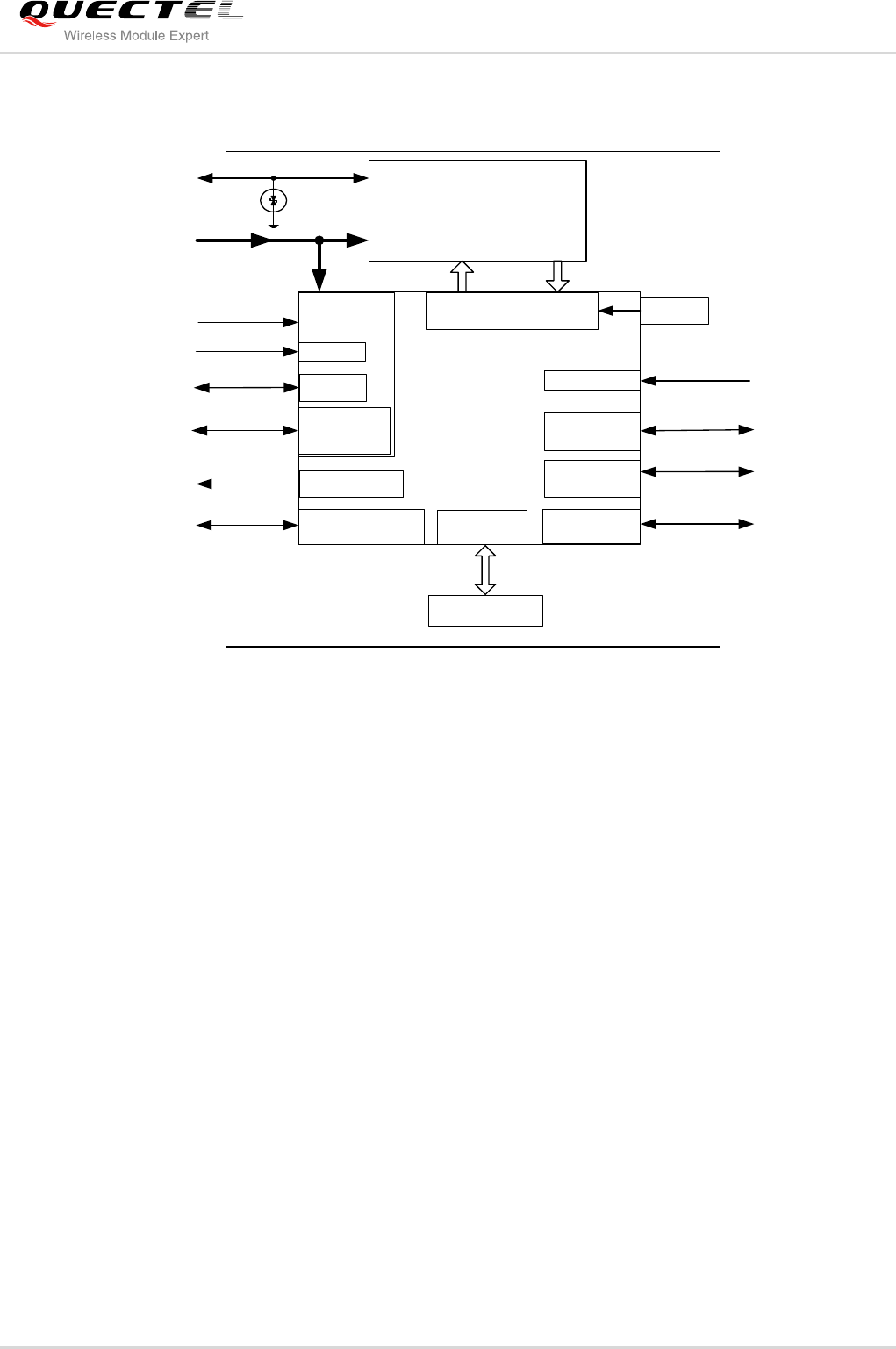
GSM/GPRS Module Series
M85 Hardware Design
M85_Hardware_Design Confidential / Released 15 / 88
—RF interface
BB&RF
RF PAM
26MHzRF Transceiver
RTC
GPIO&PWM
Serial Interface
SIM
Interface
RF_ANT
VBAT
PWRKEY
EMERG_OFF
VRTC
GPIO&
Status&
Netlight
UART
SIM Interfaces
Reset
ESD
PMU
MEMORY Audio Audio
PCM
Interface PCM
Serial Flash
SD
Interface
SD
ADC ADC
Figure 1: Module Functional Diagram
2.5. Evaluation Board
In order to help customer to develop applications with M85, Quectel supplies an evaluation board (EVB),
RS-232 to USB cable, power adapter, earphone, antenna and other peripherals to control or test the
module. For details, please refer to the document [12].

GSM/GPRS Module Series
M85 Hardware Design
M85_Hardware_Design Confidential / Released 16 / 88
3 Application Interface
The module adopts LCC package and has 83 pins. The following chapters provide detailed descriptions
about these pins below.
Power supply
Power on/down
Power saving
RTC
Serial interfaces
Audio interfaces
SIM interfaces
SD interface
PCM interface
ADC
RI
NETLIGHT
Status
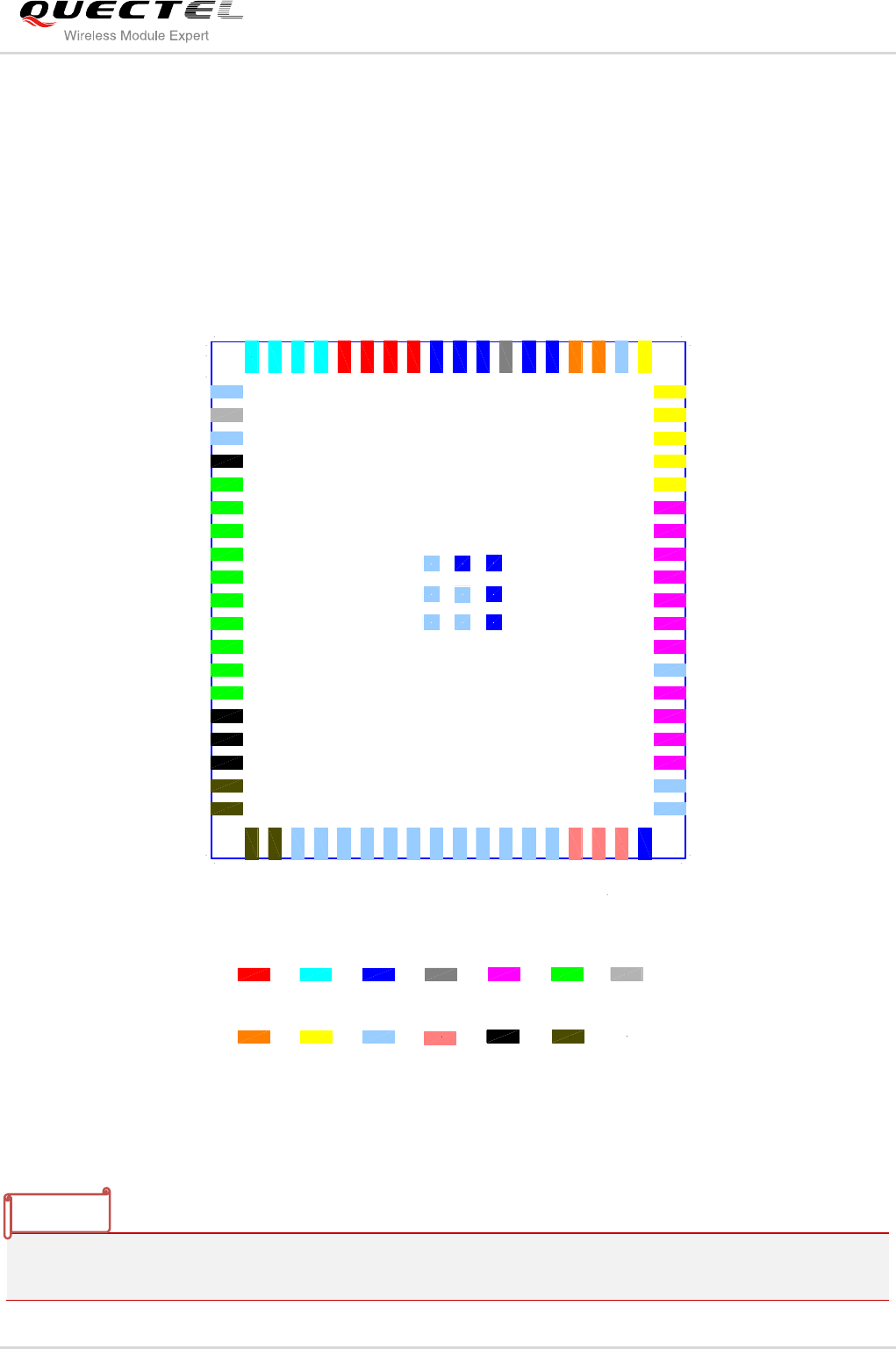
GSM/GPRS Module Series
M85 Hardware Design
M85_Hardware_Design Confidential / Released 17 / 88
3.1. Pin of Module
3.1.1. Pin Assignment
Power SIM1 RESERVED PCM
Other
SD
RESERVED
NETLIGHT
LOUDSPKN
LOUDSPKP
PWRKEY
EMERG_OFF
PCM_IN
PCM_CLK RESERVED
RESERVED
RESERVED
SIM_GND
SIM1_RST
SIM1_DATA
SIM1_CLK
SIM1_VDD
RESERVED
SIM2_VDD
SIM2_CLK
SIM2_DATA
SIM2_RST
SIM1_PRESENCE
GND Audio ADC
1
2
3
4
5
6
7
8
9
10
11
12
13
14
15
16
17
18
19
20 21 22 23 24 25 26 27 28 29 30 31 32 33 34 35 36 37
38
39
40
41
42
43
44
45
46
47
48
49
50
51
52
53
54
55
56
5758
59
60
616263646566676869
70
71727374
Top view
RFSIM2
VBAT UART
ADC0
RESERVED
SPK2P
AGND
MIC2P
MIC2N
MIC1P
MIC1N
SPK1N
SPK1P
STATUS
PCM_OUT
PCM_SYNC
RESERVED
RESERVED
RESERVED
RESERVED
RESERVED
RESERVED
RESERVED
RESERVED
RESERVED
RESERVED
RESERVED
RESERVED
SD_CMD
SD_CLK
SD_DATA0
GND
TXD_AUX
RXD_AUX
DBG_TXD
DBG_RXD
DCD
RI
DTR
CTS
TXD
RXD
RTS
VRTC
VDD_EXT
GND
GND
RF_ANT
GND
GND
GND
VBAT
VBAT
VBAT
VBAT
75
76
77
78
79
80
81
82
RESERVED
RESERVED
RESERVED
RESERVED
GND
GND
GND
GND
RESERVED
83
Figure 2: Pin Assignment
Keep all reserved pins open.
NOTE

GSM/GPRS Module Series
M85 Hardware Design
M85_Hardware_Design Confidential / Released 18 / 88
3.1.2. Pin Description
Table 3: Pin Description
Power Supply
PIN NAME
PIN NO.
I/O
DESCRIPTION
DC
CHARACTERISTICS
COMMENT
VBAT
67, 68, 69,
70
I
Main power supply of
module:
VBAT=3.3V~4.6V
Vmax=4.6V
Vmin=3.3V
Vnorm=4.0V
Make sure that
supply sufficient
current in a
transmitting burst
typically rises to
1.6A.
VRTC
59
I/O
Power supply for RTC.
Charging for backup
battery or golden
capacitor when the
VBAT is applied.
VImax=3.3V
VImin=1.5V
VInorm=2.8V
VOmax=3V
VOmin=2V
VOnorm=2.8V
Iout(max)=2mA
Iin≈10uA
If unused, keep
this pin open.
VDD_EXT
60
O
Supply 2.8V voltage for
external circuit.
Vmax=2.9V
Vmin=2.7V
Vnorm=2.8V
Imax=20mA
1. If unused, keep
this pin open.
2. Recommend to
add a 2.2~4.7uF
bypass capacitor,
when using this
pin for power
supply.
GND
37, 61, 62,
64~66,
79~82,
Ground
Turn on/off
PIN NAME
PIN NO.
I/O
DESCRIPTION
DC
CHARACTERISTICS
COMMENT
PWRKEY
15
I
Power on/off key.
PWRKEY should be pulled
down for a moment to turn
on or turn off the system.
VILmax=
0.1×VBAT
VIHmin=
0.6×VBAT
VIHmax=3.1V
Emergency Shutdown

GSM/GPRS Module Series
M85 Hardware Design
M85_Hardware_Design Confidential / Released 19 / 88
PIN NAME
PIN NO.
I/O
DESCRIPTION
DC
CHARACTERISTICS
COMMENT
EMERG_
OFF
17
I
Emergency off. Pulled
down for at least 40ms,
which will turn off the
module in case of
emergency. Use it only
when shutdown via
PWRKEY or AT command
cannot be achieved.
VILmax=0.45V
VIHmin=1.35V
Vopenmax=1.8V
Open
drain/collector
driver required in
cellular device
application.
If unused, keep
this pin open.
Module Indicator
PIN NAME
PIN NO.
I/O
DESCRIPTION
DC
CHARACTERISTICS
COMMENT
STATUS
16
O
Indicate module’s
operating status. Output
high level when module
turns on, while output low
level when module turns
off.
VOHmin=
0.85×VDD_EXT
VOLmax=
0.15×VDD_EXT
If unused, keep
this pin open.
Audio Interface
PIN NAME
PIN NO.
I/O
DESCRIPTION
DC
CHARACTERISTICS
COMMENT
MIC1P
MIC1N
9, 10
I
Channel 1 positive and
negative voice input
Refer to Section 3.8
If unused, keep
these pins open.
MIC2P
MIC2N
7, 8
I
Channel 2 positive and
negative voice input
SPK1P
SPK1N
12, 11
O
Channel 1 positive and
negative voice output
1. If unused, keep
these pins open.
2. Support both
voice and
ringtone output.
SPK2P
5
O
Channel 2 voice output
AGND
6
Analog ground. Separate
ground connection for
external audio circuits.
If unused, keep
this pin open.
LOUDSPKN
LOUDSPKP
13, 14
O
Channel 3 positive and
negative voice output
1. If unused, keep
these pins open.
2. Integrate a
Class- AB
amplifier
internally.
3. Support both
voice and

GSM/GPRS Module Series
M85 Hardware Design
M85_Hardware_Design Confidential / Released 20 / 88
ringtone output.
Network Status Indicator
PIN NAME
PIN NO.
I/O
DESCRIPTION
DC
CHARACTERISTICS
COMMENT
NETLIGHT
4
O
Network status
indication
VOHmin=
0.85×VDD_EXT
VOLmax=
0.15×VDD_EXT
If unused, keep
this pin open.
UART Port
PIN NAME
PIN NO.
I/O
DESCRIPTION
DC
CHARACTERISTICS
COMMENT
DTR
47
I
Data terminal ready
VILmin=0V
VILmax=
0.25×VDD_EXT
VIHmin=
0.75×VDD_EXT
VIHmax=
VDD_EXT+0.2
VOHmin=
0.85×VDD_EXT
VOLmax=
0.15×VDD_EXT
If only use TXD,
RXD and GND to
communicate,
recommended
connecting RTS
to GND via 0R
resistor and
keeping other
pins open.
RXD
50
I
Receive data
TXD
49
O
Transmit data
RTS
51
I
Request to send
CTS
48
O
Clear to send
RI
46
O
Ring indication
DCD
45
O
Data carrier detection
Debug Port
PIN NAME
PIN NO.
I/O
DESCRIPTION
DC
CHARACTERISTICS
COMMENT
DBG_TXD
42
O
Transmit data
Same as above
If unused, keep
these pins open.
DBG_RXD
43
I
Receive data
Auxiliary Port
PIN NAME
PIN NO.
I/O
DESCRIPTION
DC
CHARACTERISTICS
COMMENT
TXD_AUX
40
O
Transmit data
Same as above
If unused, keep
these pins open.
RXD_AUX
41
I
Receive data
SIM Interface
PIN NAME
PIN NO.
I/O
DESCRIPTION
DC
CHARACTERISTICS
COMMENT

GSM/GPRS Module Series
M85 Hardware Design
M85_Hardware_Design Confidential / Released 21 / 88
SIM1_VDD
56
O
Power supply for SIM
card
The voltage can be
selected by software
automatically. Either
1.8V or 3V.
All signals of SIM
interface should be
protected against
ESD with a TVS
diode array.
Maximum trace
length is 200mm
from the module
pad to SIM card
holder.
SIM2_VDD
71
SIM1_CLK
55
O
SIM clock
VOLmax=
0.15×SIM_VDD
VOHmin=
0.85×SIM_VDD
SIM2_CLK
72
SIM1_ DATA
54
I/O
SIM data
VILmax=
0.25×SIM_VDD
VIHmin=
0.75×SIM_VDD
VOLmax=
0.15×SIM_VDD
VOHmin=
0.85×SIM_VDD
SIM2_DATA
73
SIM1_RST
53
O
SIM reset
VOLmax=
0.15×SIM_VDD
VOHmin=
0.85×SIM_VDD
SIM2_RST
74
SIM1_
PRESENCE
57
I
SIM card detection
VILmin=0V
VILmax=
0.25×VDD_EXT
VIHmin=
0.75×VDD_EXT
VIHmax=
VDD_EXT+0.2
If unused, keep
these pins open.
SIM_GND
52
SIM ground
ADC
PIN NAME
PIN NO.
I/O
DESCRIPTION
DC
CHARACTERISTICS
COMMENT
ADC0
2
I
General purpose
analog to digital
converter.
Voltage range:
0V to 2.8V
If unused, keep
this pin open.
PCM
PIN NAME
PIN NO.
I/O
DESCRIPTION
DC
CHARACTERISTICS
COMMENT
PCM_CLK
19
O
PCM clock
VILmin= 0V
VILmax=
0.25×VDD_EXT
If unused, keep
these pins open.
PCM_IN
18
I
PCM data input

GSM/GPRS Module Series
M85 Hardware Design
M85_Hardware_Design Confidential / Released 22 / 88
PCM_OUT
20
O
PCM data output
VIHmin=
0.75×VDD_EXT
VIHmax=
VDD_EXT+0.2
VOHmin=
0.85×VDD_EXT
VOLmax=
0.15×VDD_EXT
If unused, keep
these pins open.
PCM_SYNC
21
O
PCM frame
synchronization
SD Card
PIN NAME
PIN NO.
I/O
DESCRIPTION
DC
CHARACTERISTICS
COMMENT
SD_CMD
34
O
SD command
VILmin=0V
VILmax=
0.25×VDD_EXT
VIHmin=
0.75×VDD_EXT
VIHmax=
VDD_EXT+0.2
VOHmin=
0.85×VDD_EXT
VOLmax=
0.15×VDD_EXT
If unused, keep
these pins open.
SD_CLK
35
O
SD clock
SD_DATA0
36
I/O
SD data
Antenna Interface
PIN NAME
PIN NO.
I/O
DESCRIPTION
DC
CHARACTERISTICS
COMMENT
RF_ANT
63
I/O
RF antenna pad
Impedance of 50Ω
Other Interface
PIN NAME
PIN NO.
I/O
DESCRIPTION
DC
CHARACTERISTICS
COMMENT
RESERVD
1, 3,
22~33,
38, 39,
44, 58,
75~78,
83
Keep these pins
open.

GSM/GPRS Module Series
M85 Hardware Design
M85_Hardware_Design Confidential / Released 23 / 88
3.2. Operating Modes
The table below briefly summarizes the various operating modes in the following chapters.
Table 4: Overview of Operating Modes
Mode
Function
Normal
Operation
GSM/GPRS
Sleep
After enabling sleep mode by AT+QSCLK=1, the module will
automatically go into Sleep Mode if DTR is set to high level and
there is no interrupt (such as GPIO interrupt or data on UART
port). In this case, the current consumption of module will reduce
to the minimal level. During Sleep Mode, the module can still
receive paging message and SMS from the system normally.
GSM IDLE
Software is active. The module has registered to the GSM
network, and the module is ready to send and receive GSM data.
GSM TALK
GSM connection is ongoing. In this mode, the power
consumption is decided by the configuration of Power Control
Level (PCL), dynamic DTX control and the working RF band.
GPRS IDLE
The module is not registered to GPRS network. The module is
not reachable through GPRS channel.
GPRS
STANDBY
The module is registered to GPRS network, but no GPRS PDP
context is active. The SGSN knows the Routing Area where the
module is located at.
GPRS READY
The PDP context is active, but no data transfer is ongoing. The
module is ready to receive or send GPRS data. The SGSN
knows the cell where the module is located at.
GPRS DATA
There is GPRS data in transfer. In this mode, power consumption
is decided by the PCL, working RF band and GPRS multi-slot
configuration.
POWER DOWN
Normal shutdown by sending the AT+QPOWD=1 command or using the PWRKEY
or the EMERG_OFF1) pin. The power management ASIC disconnects the power
supply from the base band part of the module, and only the power supply for the
RTC is remained. Software is not active. The UART interfaces are not accessible.
Operating voltage (connected to VBAT) remains applied.
Minimum
Functionality
Mode (without
removing power
supply)
AT+CFUN command can set the module to a minimum functionality mode without
removing the power supply. In this case, the RF part of the module will not work or
the SIM card will not be accessible, or both RF part and SIM card will be disabled,
but the UART port is still accessible. The power consumption in this case is very
low.

GSM/GPRS Module Series
M85 Hardware Design
M85_Hardware_Design Confidential / Released 24 / 88
Use the EMERG_OFF pin only when failing to turn off the module by the command AT+QPOWD=1 and
the PWRKEY pin. For more details, please refer to the Section 3.4.2.4.
3.3. Power Supply
3.3.1. Power Features of Module
The power supply is one of the key issues in designing GSM terminals. Because of the 577us radio burst
in GSM every 4.615ms, power supply must be able to deliver high current peaks in a burst period. During
these peaks, drops on the supply voltage must not exceed minimum working voltage of module.
For the M85 module, the max current consumption could reach to 1.6A during a transmit burst. It will
cause a large voltage drop on the VBAT. In order to ensure stable operation of the module, it is
recommended that the max voltage drop during the transmit burst does not exceed 400mV.
Vdrop
4.615ms
577us
IBAT
VBAT
Burst:1.6A
Figure 3: Voltage Ripple during Transmitting
3.3.2. Decrease Supply Voltage Drop
The power supply range of the module is 3.3V to 4.6V. Make sure that the input voltage will never drop
below 3.3V even in a transmitting burst. If the power voltage drops below 3.3V, the module could turn off
automatically. For better power performance, it is recommended to place a 100uF tantalum capacitor with
low ESR (ESR=0.7Ω) and ceramic capacitor 100nF, 33pF and 10pF near the VBAT pin. The reference
circuit is illustrated in Figure 4.
The VBAT route should be wide enough to ensure that there is not too much voltage drop during transmit
burst. The width of trace should be no less than 2mm and the principle of the VBAT route is the longer
route, the wider trace.
NOTE
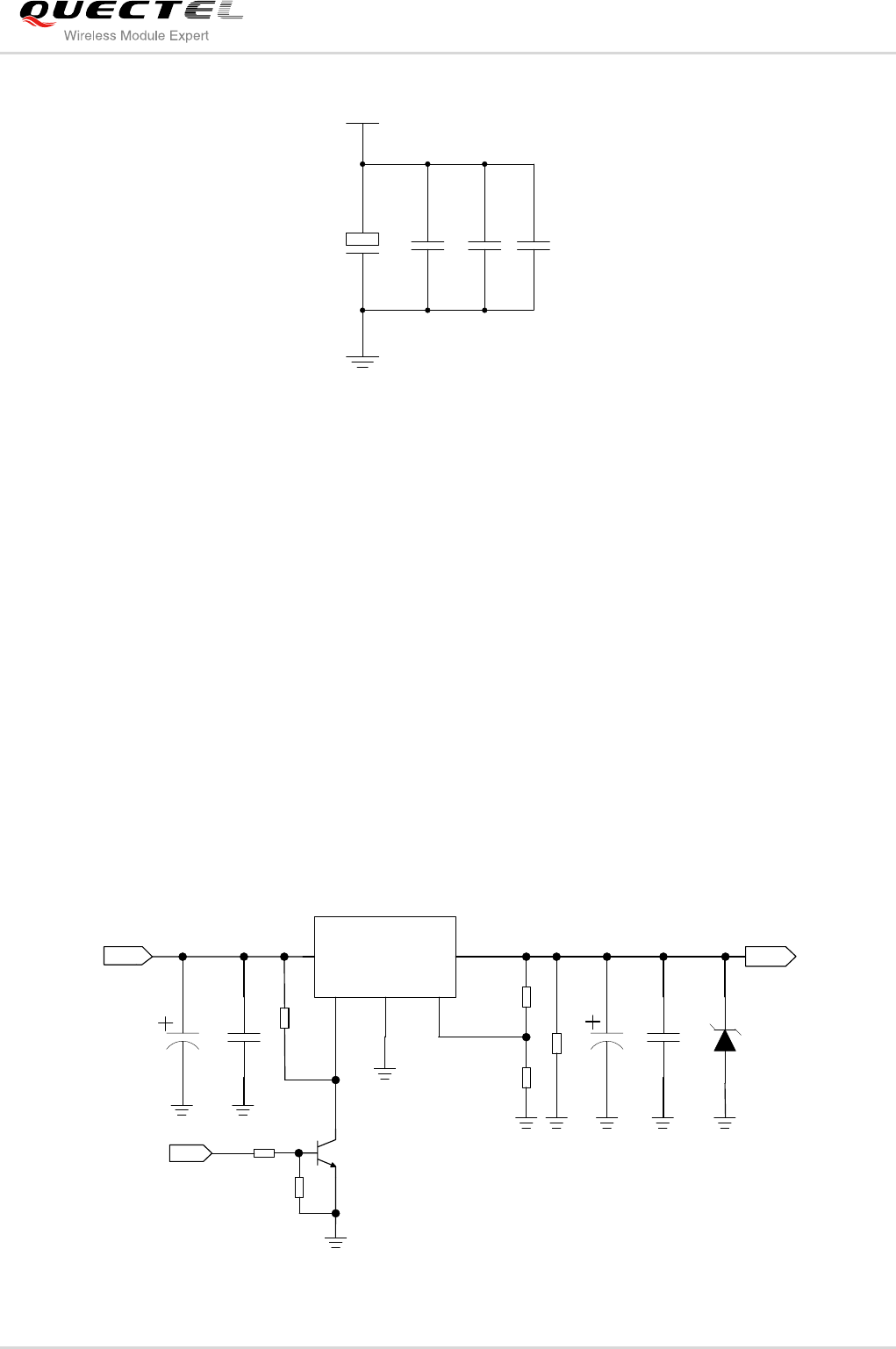
GSM/GPRS Module Series
M85 Hardware Design
M85_Hardware_Design Confidential / Released 25 / 88
VBAT
C2C1
+C3 C4
GND
100uF 100nF 10pF
0603
33pF
0603
Figure 4: Reference Circuit for the VBAT Input
3.3.3. Reference Design For Power Supply
The power design for the module is very important, since the performance of power supply for the module
largely depends on the power source. The power supply is capable of providing the sufficient current up to
2A at least. If the voltage drop between the input and output is not too high, it is suggested to use a LDO
as module’s power supply. If there is a big voltage difference between the input source and the desired
output (VBAT), a switcher power converter is recommended to use as a power supply.
Figure 5 shows a reference design for +5V input power source. The designed output for the power supply
is 4.0V and the maximum load current is 3A. In addition, in order to get a stable output voltage, a zener
diode is placed close to the pins of VBAT. As to the zener diode, it is suggested to use a zener diode
whose reverse zener voltage is 5.1V and dissipation power is more than 1 Watt.
DC_IN
C1 C2
MIC29302WU U1
IN OUT
EN
GND
ADJ
2 4
1
3
5
VBAT
100nF
C3
470uF
C4
100nF
R2
D1
124K
56K
R3
470uF 5.1V
R4
470R
MCU_POWER_ON/OFF
47K
4.7K
R5
R6
R1
51K
Figure 5: Reference Circuit for Power Supply
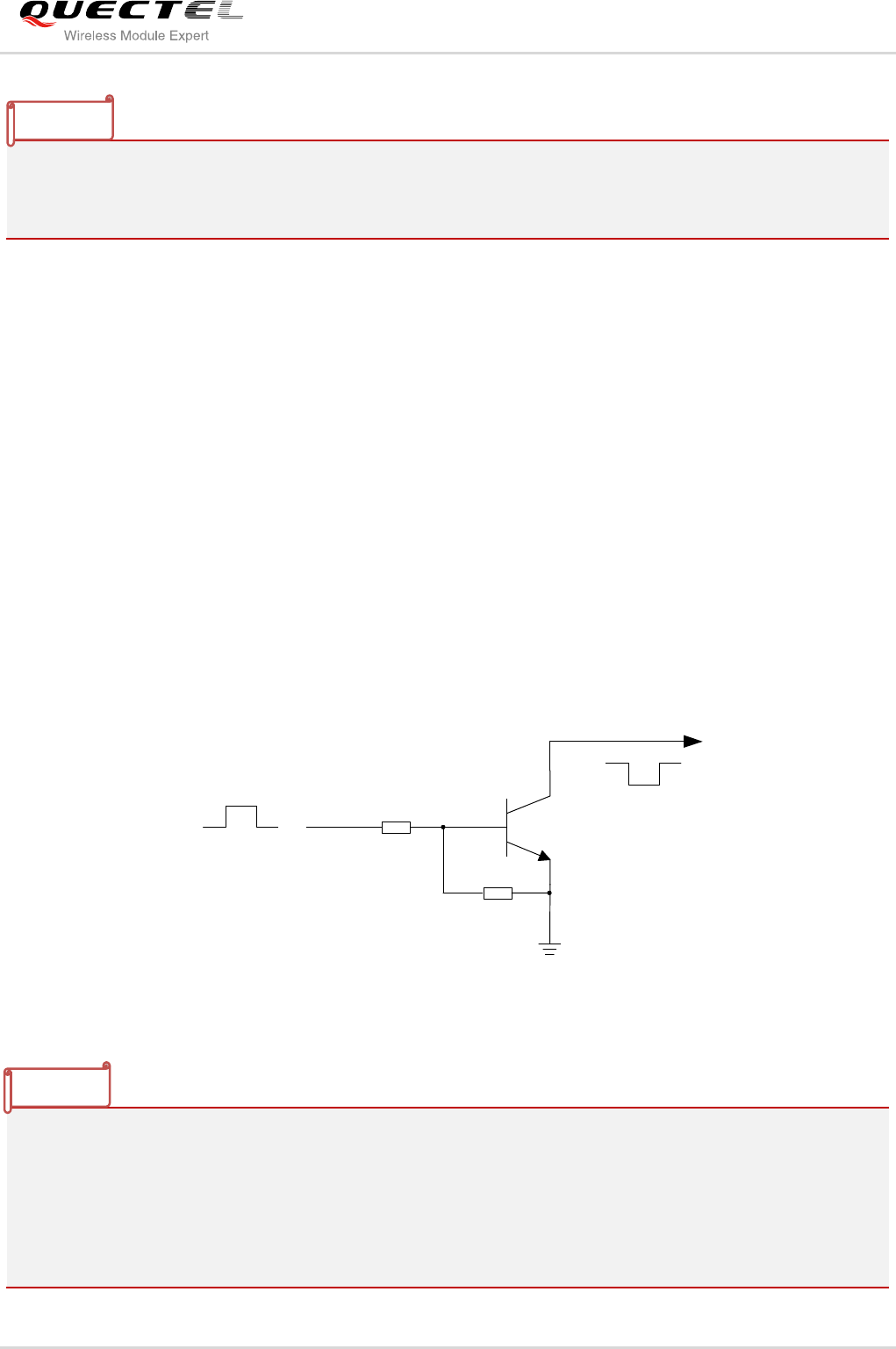
GSM/GPRS Module Series
M85 Hardware Design
M85_Hardware_Design Confidential / Released 26 / 88
It is suggested to control the module’s main power supply (VBAT) via LDO enable pin to restart the
module when the module has become abnormal. Power switch circuit like P-channel MOSFET switch
circuit can also be used to control VBAT.
3.3.4. Monitor Power Supply
The command AT+CBC can be used to monitor the supply voltage of the module. The unit of the
displayed voltage is mV.
For details, please refer to the document [1].
3.4. Power On and Down Scenarios
3.4.1. Power On
The module can be turned on by driving the pin PWRKEY to a low level voltage. An open collector driver
circuit is suggested to control the PWRKEY. A simple reference circuit is illustrated as below.
Turn on pulse
PWRKEY
4.7K
47K
Figure 6: Turn on the Module with an Open-collector Driver
1. M85 module is set to autobauding mode (AT+IPR=0) by default. In the autobauding mode, URC
―RDY‖ is not reported to the host controller after module is powered on. When the module is powered
on after a delay of 4 or 5 seconds, it can receive AT command. Host controller should first send an AT
string in order that the module can detect baud rate of host controller, and it should continue to send
the next AT string until receiving OK string from the module. Then enter AT+IPR=x;&W to set a fixed
baud rate for the module and save the configuration to flash memory of the module. After these
NOTES
NOTE
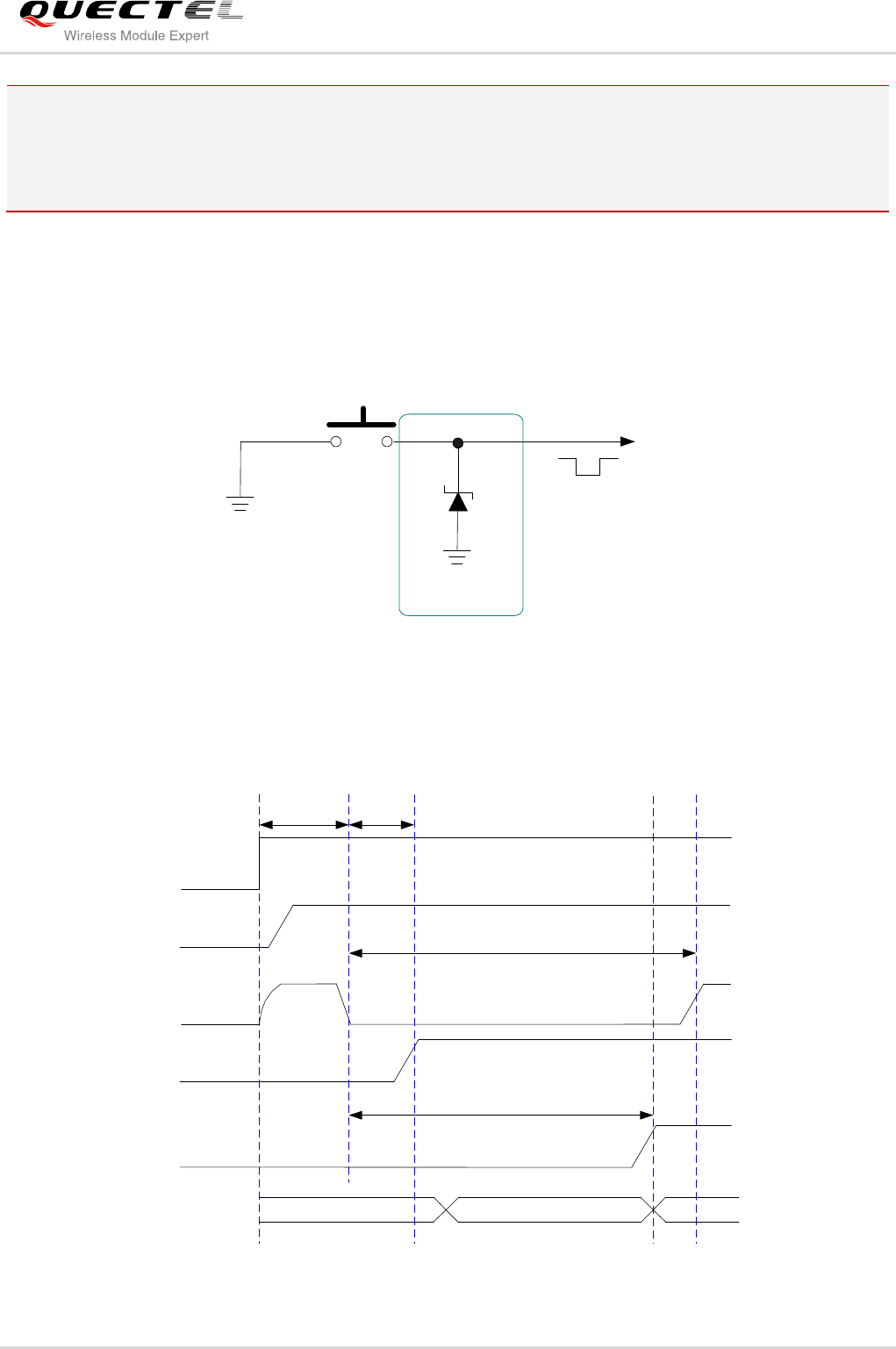
GSM/GPRS Module Series
M85 Hardware Design
M85_Hardware_Design Confidential / Released 27 / 88
configurations, the URC RDY would be received from the UART Port of the module every time when
the module is powered on. For more details, refer to the section AT+IPR in document [1].
2. AT command response indicates module is turned on successfully, or else the module fails to be
turned on.
The other way to control the PWRKEY is through a button directly. A TVS component is indispensable to
be placed nearby the button for ESD protection. For the best performance, the TVS component must be
placed nearby the button. When pressing the key, electrostatic strike may generate from finger. A
reference circuit is shown in the following figure.
PWRKEY
K1
Close to K1
TVS
Figure 7: Turn on the Module with a Button
The turn-on timing is illustrated as the following figure.
VDD_EXT
(OUTPUT)
VIL<0.1*VBAT
VIH > 0.6*VBAT
VBAT
PWRKEY
(INPUT)
EMERG_OFF
(INPUT)
54ms
STATUS
(OUTPUT)
800ms
>1s
OFF BOOTING
MODULE
STATUS RUNNING
T1
Figure 8: Turn-on Timing
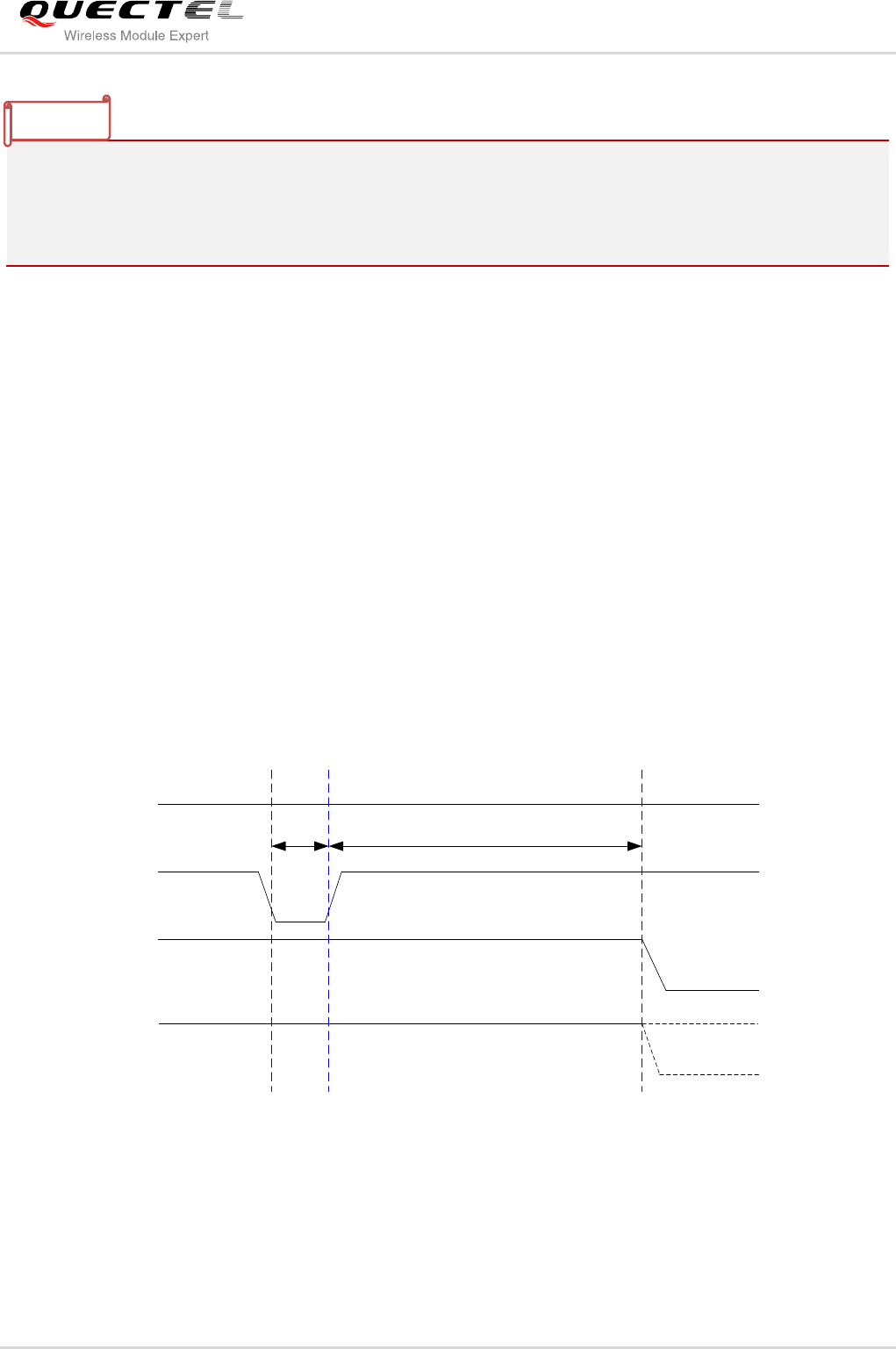
GSM/GPRS Module Series
M85 Hardware Design
M85_Hardware_Design Confidential / Released 28 / 88
1. Make sure that VBAT is stable before pulling down PWRKEY pin. The time of T1 is recommended as
100ms.
2. EMERG_OFF should be floated when it is unused.
3. For more details about the application of STATUS pin, please refer to the Chapter 3.15.
3.4.2. Power Down
The following procedures can be used to turn off the module:
Normal power down procedure: Turn off module using the PWRKEY pin.
Normal power down procedure: Turn off module using command AT+QPOWD.
Over-voltage or under-voltage automatic shutdown: Take effect when over-voltage or under-voltage
is detected.
Emergent power down procedure: Turn off module using the EMERG_OFF pin.
3.4.2.1. Power Down Module Using the PWRKEY Pin
It is a safe way to turn off the module by driving the PWRKEY to a low level voltage for a certain time. The
power down scenario is illustrated as the following figure.
VBAT
PWRKEY
(INPUT)
STATUS
(OUTPUT)
EMERG_OFF
(INPUT)
Logout net about 2s to 12s
0.7s<Pulldown<1s
Figure 9: Turn-off timing
The power down procedure causes the module to log off from the network and allows the firmware to
save important data before completely disconnecting the power supply.
NOTES

GSM/GPRS Module Series
M85 Hardware Design
M85_Hardware_Design Confidential / Released 29 / 88
Before the completion of the power down procedure, module sends out the result code shown as below:
NORMAL POWER DOWN
After that moment, no further AT commands can be executed. Then the module enters the power down
mode, only the RTC is still active. The power down mode can also be indicated by the STATUS pin, which
is a low level voltage in this mode.
1. This unsolicited result codes do not appear when autobauding is active and DTE and DCE are not
correctly synchronized after start-up. The module is recommended to set to a fixed baud rate.
2. As logout network time is related to the local mobile network, it is recommended to delay about 12
seconds before disconnecting the power supply or restarting the module.
3. For more details about the application of STATUS pin, please refer to the Chapter 3.15.
3.4.2.2. Power Down Module Using AT Command
It is also a safe way to turn off the module via AT command AT+QPOWD=1. This command will let the
module to log off from the network and allow the firmware to save important data before completely
disconnecting the power supply.
Before the completion of the power down procedure, module sends out the result code shown as below:
NORMAL POWER DOWN
After that moment, no further AT commands can be executed. And then the module enters the power
down mode, only the RTC is still active.
Please refer to the document [1] for details about the AT command AT+QPOWD.
3.4.2.3. Over-voltage or Under-voltage Automatic Shutdown
The module will constantly monitor the voltage applied on the VBAT, if the voltage is ≤3.5V, the following
URC will be presented:
UNDER_VOLTAGE WARNING
If the voltage is ≥4.5V, the following URC will be presented:
OVER_VOLTAGE WARNING
NOTES

GSM/GPRS Module Series
M85 Hardware Design
M85_Hardware_Design Confidential / Released 30 / 88
The normal input voltage range is from 3.3V to 4.6V. If the voltage is >4.6V or <3.3V, the module would
automatically shut down itself.
If the voltage is <3.3V, the following URC will be presented:
UNDER_VOLTAGE POWER DOWN
If the voltage is >4.6V, the following URC will be presented:
OVER_VOLTAGE POWER DOWN
After that moment, no further AT commands can be executed. The module logs off from network and
enters power down mode, and only RTC is still active.
1. These unsolicited result codes do not appear when autobauding is active and DTE and DCE are not
correctly synchronized after start-up. The module is recommended to set to a fixed baud rate.
2. Over-voltage warning and shutdown function is disabled by default.
3.4.2.4. Emergency Shutdown Using EMERG_OFF Pin
The module can be shut down by driving the pin EMERG_OFF to a low level voltage over 40ms and then
releasing it. The EMERG_OFF line can be driven by an open-drain/collector driver or a button. The circuit
is illustrated as the following figures.
Emergency
shutdown pulse
EMERG_OFF
4.7K
47K
Figure 10: An Open-collector Driver for EMERG_OFF
NOTES

GSM/GPRS Module Series
M85 Hardware Design
M85_Hardware_Design Confidential / Released 31 / 88
K2
EMERG_OFF
TVS2
Close to K2
Figure 11: Reference Circuit for EMERG_OFF by Using Button
Be cautious to use the pin EMERG_OFF. It should only be used under emergent situation. For instance, if
the module is unresponsive or abnormal, the pin EMERG_OFF could be used to shut down the system.
Although turning off the module by EMERG_OFF is fully tested and nothing wrong detected, this
operation is still a big risk as it could cause destroying of the code or data area of the flash memory in the
module. Therefore, it is recommended that PWRKEY or AT command should always be the preferential
way to turn off the system.
3.4.3. Restart
The module can be restarted by driving the PWRKEY to a low level voltage for a certain time, which is
similar to the way of turning on module. In order to make the internal LDOs discharge completely after
turning off the module, it is recommended to delay about 500ms before restarting the module. The restart
timing is illustrated as the following figure.
PWRKEY
(INPUT)
STATUS
(OUTPUT)
Delay >500ms
Turn off Restart
Pull down the PWRKEY
to turn on the module
Figure 12: Timing of Restarting System

GSM/GPRS Module Series
M85 Hardware Design
M85_Hardware_Design Confidential / Released 32 / 88
The module can also be restarted by the PWRKEY after emergency shutdown.
EMERG_OFF
(INPUT)
STATUS
(OUTPUT)
Delay >500ms
Pulldown >40ms
PWRKEY
(INPUT)
Figure 13: Timing of Restarting System after Emergency Shutdown
For more details about the application of STATUS pin, please refer to the Chapter 3.15.
3.5. Power Saving
Based on system requirements, there are several actions to drive the module to enter low current
consumption status. For example, AT+CFUN can be used to set module into minimum functionality mode
and DTR hardware interface signal can be used to lead system to SLEEP mode.
3.5.1. Minimum Functionality Mode
Minimum functionality mode reduces the functionality of the module to a minimum level. The consumption
of the current can be minimized when the slow clocking mode is activated at the same time. The mode is
set with the AT+CFUN command which provides the choice of the functionality levels <fun>=0, 1, 4.
0: minimum functionality
1: full functionality (default)
4: disable both transmitting and receiving of RF part
If the module is set to minimum functionality by AT+CFUN=0, the RF function and SIM card function
would be disabled. In this case, the UART port is still accessible, but all AT commands related with RF
function or SIM card function will be not available.
NOTE

GSM/GPRS Module Series
M85 Hardware Design
M85_Hardware_Design Confidential / Released 33 / 88
If the module has been set by the command with AT+CFUN=4, the RF function will be disabled, but the
UART port is still active. In this case, all AT commands related with RF function will be not available.
After the module is set by AT+CFUN=0 or AT+CFUN=4, it can return to full functionality by AT+CFUN=1.
For detailed information about AT+CFUN, please refer to the document [1].
3.5.2. SLEEP Mode
The SLEEP mode is disabled by default. You can enable it by AT+QSCLK=1. On the other hand, the
default setting is AT+QSCLK=0 and in this mode, the module cannot enter SLEEP mode.
When the module is set by the command with AT+QSCLK=1, you can control the module to enter or exit
from the SLEEP mode through pin DTR. When DTR is set to high level, and there is no on-air or hardware
interrupt such as GPIO interrupt or data on UART port, the module will enter SLEEP mode automatically.
In this mode, the module can still receive voice, SMS or GPRS paging from network, but the UART port
does not work.
3.5.3. Wake up Module from SLEEP Mode
When the module is in the SLEEP mode, the following methods can wake up the module.
If the DTR Pin is set low, it would wake up the module from the SLEEP mode. The UART port will be
active within 20ms after DTR is changed to low level.
Receive a voice or GPRS data from network wakes up module.
Receive an SMS from network wakes up module.
DTR pin should be held at low level during communication between the module and DTE.
3.5.4. Summary of State Transition
Table 5: Summary of State Transition
Current Mode
Next Mode
Power Down
Normal Mode
Sleep Mode
Power Down
Use PWRKEY
NOTE

GSM/GPRS Module Series
M85 Hardware Design
M85_Hardware_Design Confidential / Released 34 / 88
3.6. RTC Backup
The RTC (Real Time Clock) function is supported. The RTC is designed to work with an internal power
supply.
There are three kinds of designs for RTC backup power:
Use VBAT as the RTC power source
When the module is turned off and the main power supply (VBAT) is remained, the real time clock is still
active as the RTC core is supplied by VBAT. In this case, the VRTC pin can be kept floating.
Use VRTC as the RTC power source
If the main power supply (VBAT) is removed after the module is turned off, a backup supply such as a
coin-cell battery (rechargeable or non-chargeable) or a super-cap can be used to supply the VRTC pin to
keep the real time clock active.
Use VBAT and VRTC as the RTC power source
As only power the VRTC pin to keep the RTC will lead an error about 5 minutes a day, it is recommended
to power VBAT and VRTC pin at the same time when RTC function is needed. The recommended supply
for RTC core circuits are shown as below.
Normal Mode
AT+QPOWD, use PWRKEY
pin, or use EMERG_OFF pin
Use AT command
AT+QSCLK=1 and pull up
DTR
SLEEP Mode
Use PWRKEY pin, or use
EMERG_OFF pin
Pull DTR down or
incoming voice call or
SMS or GPRS data
transmission
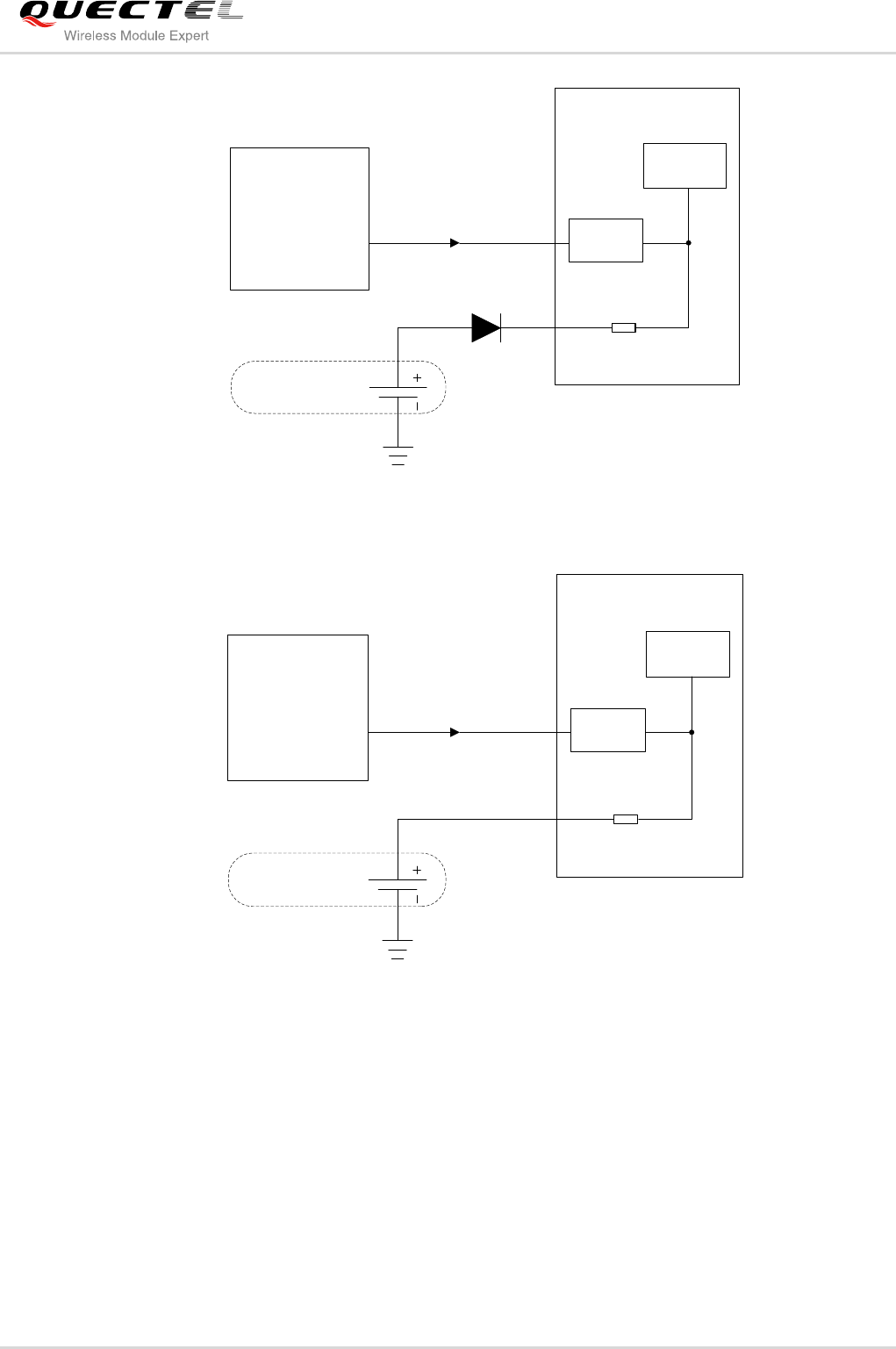
GSM/GPRS Module Series
M85 Hardware Design
M85_Hardware_Design Confidential / Released 35 / 88
Non-chargeable
Backup Battery
Module
RTC
Core
VBAT
Power Supply
LDO/DCDC LDO
VRTC 1.5K
Figure 14: VRTC is Supplied by a Non-chargeable Battery
Rechargeable
Backup Battery
Module
RTC
Core
VBAT
Power Supply
LDO/DCDC LDO
VRTC 1.5K
Figure 15: VRTC is Supplied by a Rechargeable Battery

GSM/GPRS Module Series
M85 Hardware Design
M85_Hardware_Design Confidential / Released 36 / 88
Module
RTC
Core
VBAT
Power Supply
LDO/DCDC LDO
VRTC 1.5K
Large Capacitance
Capacitor
Figure 16: VRTC is Supplied by a Capacitor
For the choice of a rechargeable or non-chargeable coin-cell battery, please visit http://www.sii.co.jp/en/.
If you want to keep an accurate real time, please keep the main power supply VBAT alive.
3.7. Serial Interfaces
The module provides three serial ports: UART Port, Debug Port and Auxiliary Port. The module is
designed as a DCE (Data Communication Equipment), following the traditional DCE-DTE (Data Terminal
Equipment) connection. Autobauding function supports baud rate from 4800bps to 115200bps.
The UART Port:
TXD: Send data to RXD of DTE.
RXD: Receive data from TXD of DTE.
RTS: Request to send.
CTS: Clear to send.
DTR: DTE is ready and inform DCE (this pin can wake the module up).
RI: Ring indicator (when there is a call, SMS or URC output, the module will inform DTE with the RI
pin).
DCD: Data carrier detection (the validity of this pin demonstrates the communication link is set up).
NOTE

GSM/GPRS Module Series
M85 Hardware Design
M85_Hardware_Design Confidential / Released 37 / 88
Hardware flow control is disabled by default. When hardware flow control is required, RTS and CTS
should be connected to the host. AT command AT+IFC=2,2 is used to enable hardware flow control. AT
command AT+IFC=0,0 is used to disable the hardware flow control. For more details, please refer to the
document [1].
The Debug Port:
DBG_TXD: Send data to the COM port of computer.
DBG_RXD: Receive data from the COM port of computer.
The Auxiliary UART Port:
TXD_AUX: Send data to the RXD of DTE.
RXD_AUX: Receive data from the TXD of DTE.
The logic levels are described in the following table.
Table 6: Logic Levels of the UART Interface
Table 7: Pin Definition of the UART Interfaces
Parameter
Min.
Max.
Unit
VIL
0
0.25×VDD_EXT
V
VIH
0.75×VDD_EXT
VDD_EXT +0.2
V
VOL
0
0.15×VDD_EXT
V
VOH
0.85×VDD_EXT
VDD_EXT
V
Interface
Pin Name
Pin No.
Description
Debug Port
DBG_RXD
43
Receive data
DBG_TXD
42
Transmit data
UART Port
DCD
45
Data carrier detection
RI
46
Ring indication
NOTE

GSM/GPRS Module Series
M85 Hardware Design
M85_Hardware_Design Confidential / Released 38 / 88
3.7.1. UART Port
3.7.1.1. The Features of UART Port
Contain data lines TXD and RXD, hardware flow control lines RTS and CTS, other control lines DTR,
DCD and RI.
Used for AT command, GPRS data, etc. Multiplexing function is supported on the UART Port. So far
only the basic mode of multiplexing is available.
Support the communication baud rates as the following:
300, 600, 1200, 2400, 4800, 9600, 14400, 19200, 28800, 38400, 57600 and 115200.
The default setting is autobauding mode. Support the following baud rates for autobauding function:
4800, 9600, 19200, 38400, 57600 and 115200.
The module disables hardware flow control by default. AT command AT+IFC=2,2 is used to enable
hardware flow control.
After setting a fixed baud rate or autobauding, please send AT string at that rate. The UART port is ready
when it responds OK.
Autobauding allows the module to detect the baud rate by receiving the string AT from the host or PC
automatically, which gives module flexibility without considering which baud rate is used by the host
controller. Autobauding is enabled by default. To take advantage of the autobauding mode, special
attention should be paid according to the following requirements:
1. Synchronization between DTE and DCE
When DCE (the module) powers on with the autobauding enabled, it is recommended to wait 4 or 5
seconds before sending the first AT character. After receiving the OK response, DTE and DCE are
correctly synchronized.
DTR
47
Data terminal ready
CTS
48
Clear to send
TXD
49
Transmit data
RXD
50
Receive data
RTS
51
Request to send
Auxiliary UART Port
TXD_AUX
40
Transmit data
RXD_AUX
41
Receive data

GSM/GPRS Module Series
M85 Hardware Design
M85_Hardware_Design Confidential / Released 39 / 88
If the host controller needs URC in the mode of autobauding, it must be synchronized firstly. Otherwise
the URC will be discarded.
2. Restrictions on autobauding operation
The UART port has to be operated at 8 data bits, no parity and 1 stop bit (factory setting).
Only the strings ―AT‖ or ―at‖ can be detected (neither ―At‖ nor ―aT‖).
The Unsolicited Result Codes like ―RDY‖, ―+CFUN: 1‖ and ―+CPIN: READY‖ will not be indicated
when the module is turned on with autobauding enabled and not be synchronized.
Any other Unsolicited Result Codes will be sent at the previous baud rate before the module detects
the new baud rate by receiving the first AT string. The DTE may receive unknown characters after
switching to new baud rate.
It is not recommended to switch to autobauding from a fixed baud rate.
If autobauding is active it is not recommended to switch to multiplex mode.
To assure reliable communication and avoid any problems caused by undetermined baud rate between
DCE and DTE, it is strongly recommended to configure a fixed baud rate and save it instead of using
autobauding after start-up. For more details, please refer to the Section AT+IPR in document [1].
3.7.1.2. The Connection of UART Port
The connection between module and host using UART Port is very flexible. Three connection styles are
illustrated as below.
Reference design for Full-Function UART connection is shown as below when it is applied in
modulation-demodulation.
TXD
RXD
RTS
CTS
DTR
DCD
RI
TXD
RXD
RTS
CTS
DTR
DCD
RING
Module (DCE)
Serial portUART port
GND GND
PC (DTE)
Figure 17: Reference Design for Full-Function UART
NOTE
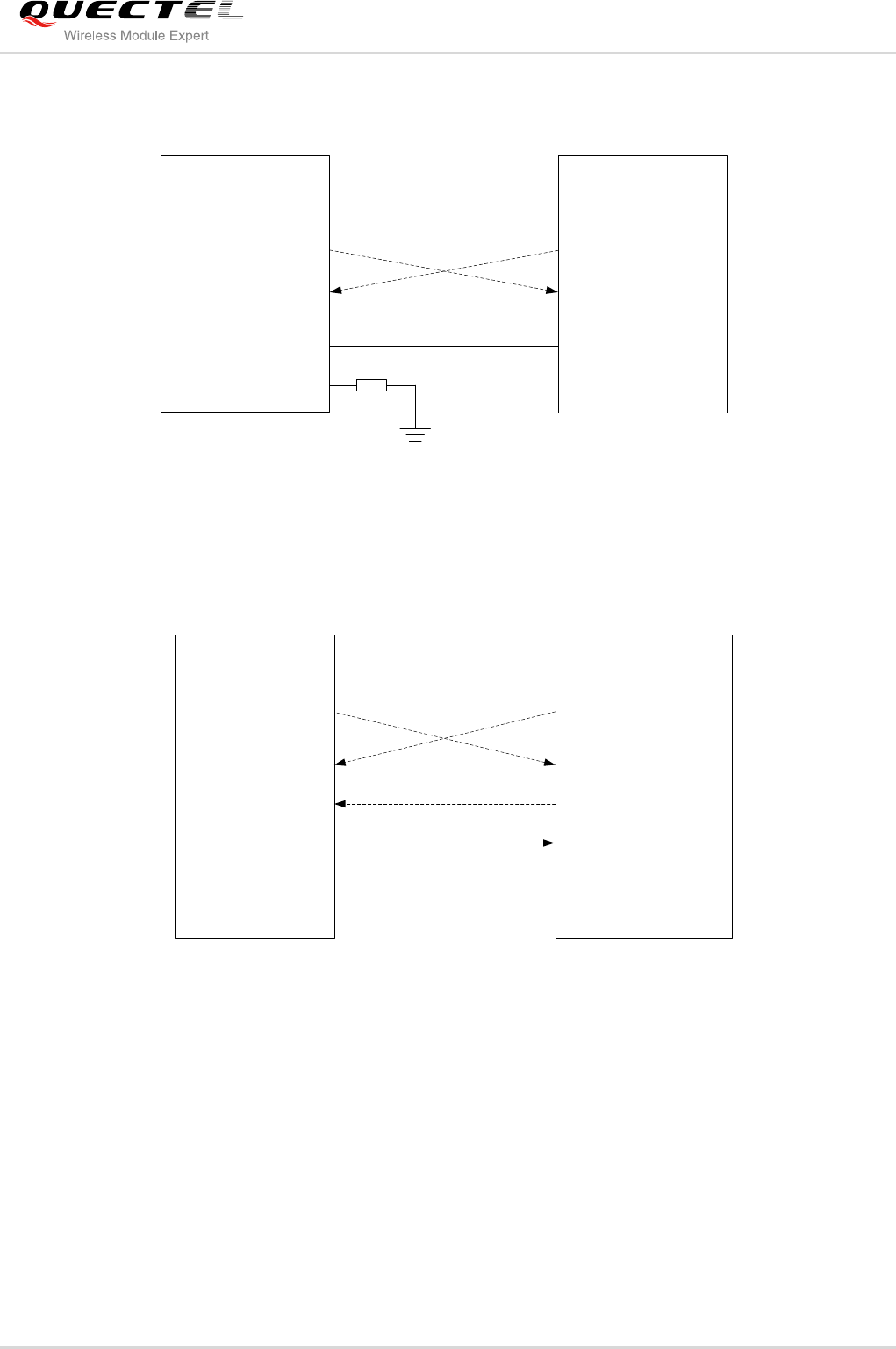
GSM/GPRS Module Series
M85 Hardware Design
M85_Hardware_Design Confidential / Released 40 / 88
Three-line connection is shown as below.
TXD
RXD
GND
UART port
RTS 0R
TXD
RXD
GND
Module (DCE) Host (DTE)
Controller
Figure 18: Reference Design for UART Port
UART Port with hardware flow control is shown as below. This connection will enhance the reliability of
the mass data communication.
RTS
CTS
RTS
CTS
GND
RXD
TXD TXD
RXD
GND
Module (DCE) Host (DTE)
Controller
Figure 19: Reference Design for UART Port with Hardware Flow Control
3.7.1.3. Firmware Upgrade
The TXD, RXD can be used to upgrade firmware. The PWRKEY pin must be pulled down before firmware
upgrade. The reference circuit is shown as below:
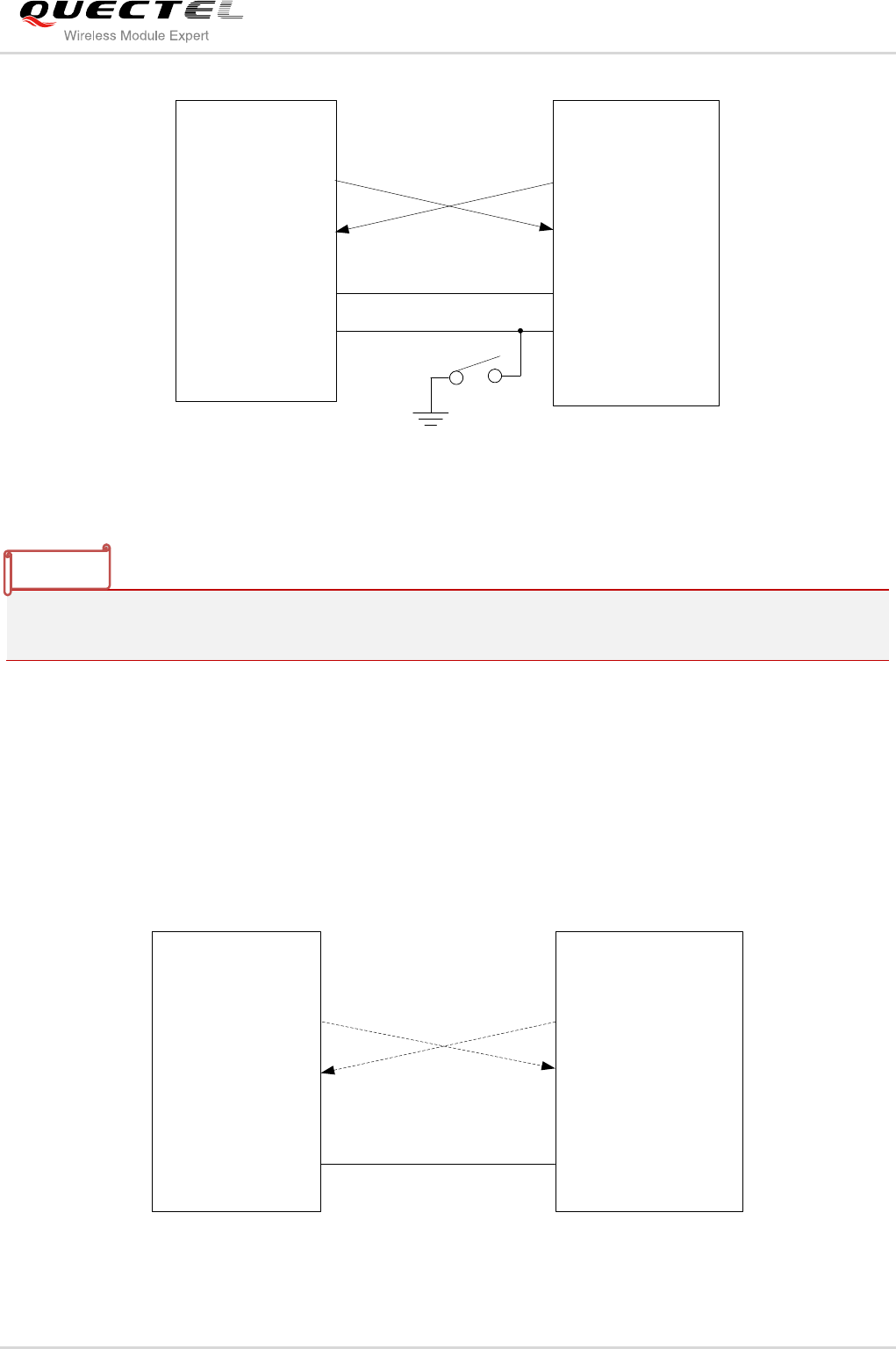
GSM/GPRS Module Series
M85 Hardware Design
M85_Hardware_Design Confidential / Released 41 / 88
IO Connector
TXD
RXD
GND
PWRKEY
Module (DCE)
UART port
TXD
RXD
GND
PWRKEY
Figure 20: Reference Design for Firmware Upgrade
The firmware of module might need to be upgraded due to certain reasons. It is recommended to reserve
these pins in the host board for firmware upgrade.
3.7.2. Debug Port
Two lines: DBG_TXD and DBG_RXD
It outputs log information automatically.
Debug Port is only used for firmware debugging and its baud rate must be configured as 460800bps.
The reference design for Debug Port is shown as below.
Peripheral
TXD
RXD
GND
Module
DBG_TXD
DBG_RXD
GND
Figure 21: Reference Design for Debug Port
NOTE
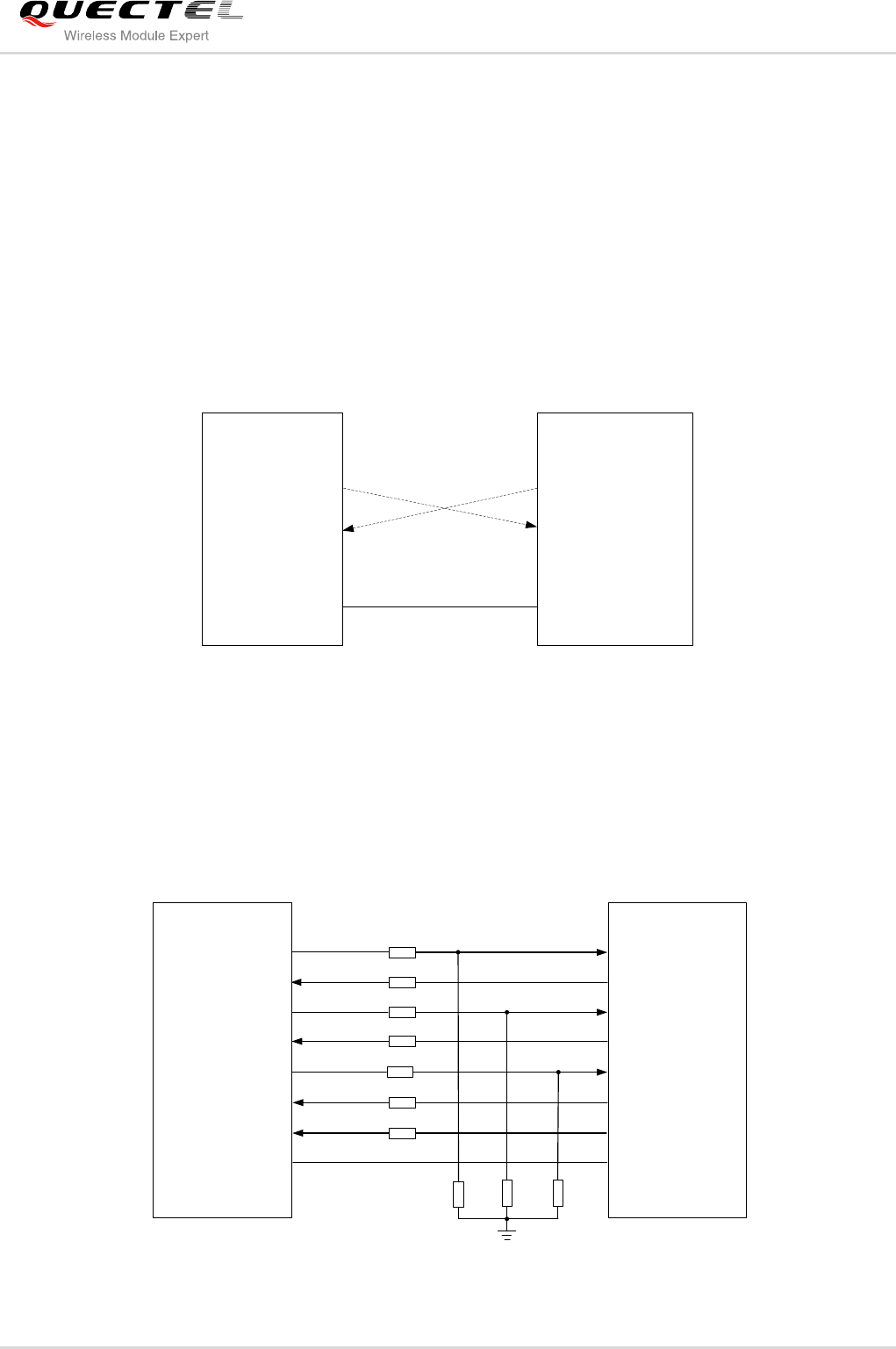
GSM/GPRS Module Series
M85 Hardware Design
M85_Hardware_Design Confidential / Released 42 / 88
3.7.3. Auxiliary UART Port
Two data lines: TXD_AUX and RXD_AUX.
Auxiliary UART port is used for AT command only and does not support GPRS data, multiplexing
function etc.
Auxiliary UART port supports the communication baud rates as the following:
1200, 2400, 4800, 9600, 14400, 19200, 28800, 38400, 57600, 115200bps.
Auxiliary UART port could be used when you send AT+QEAUART=1 string on the UART port.
The default baud rate setting is 115200bps, and does not support autobauding. The baud rate can be
modified by AT+QSEDCB command. For more details, please refer to the document [1].
Peripheral
TXD
RXD
GND
Module
TXD_AUX
RXD_AUX
GND
Figure 22: Reference Design for Auxiliary UART Port
3.7.4. UART Application
The reference design of 3.3V level match is shown as below. If the host is a 3V system, please change
the 5.6K resistor to 10K.
Peripheral
/TXD
/RXD
1K
TXD
RXD
RTS
CTS
DTR
RI
/RTS
/CTS
GPIO
EINT
GPIO DCD
Module
1K
1K
Voltage level:3.3V
5.6K
5.6K
5.6K
1K
1K
1K
1K
GND GND
Figure 23: Level Match Design for 3.3V System
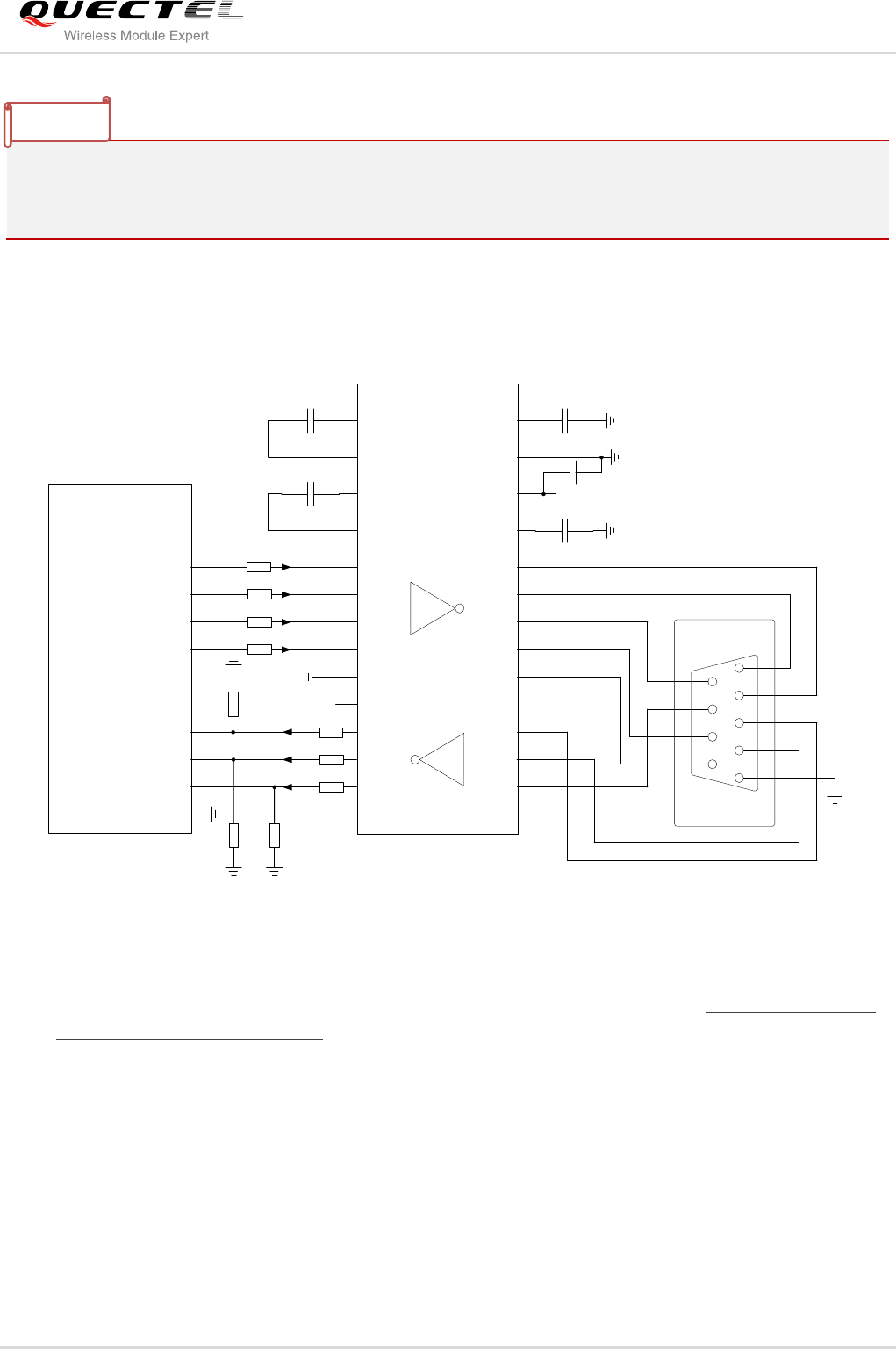
GSM/GPRS Module Series
M85 Hardware Design
M85_Hardware_Design Confidential / Released 43 / 88
It is highly recommended to add the resistor divider circuit on the UART signal lines when the host’s level
is 3V or 3.3V. For the higher voltage level system, a level shifter IC could be used between the host and
the module. For more details about UART circuit design, please refer to document [11].
The following figure shows a sketch map between module and standard RS-232 interface. Since the
electrical level of module is 2.8V, so a RS-232 level shifter must be used. Note that you should assure the
IO voltage of level shifter which connects to module is 2.8V.
TXD
RXD
RTS
CTS
DTR
RI
DCD
Module
GND
C1+
C1-
C2+
C2-
V+
VCC
GND
V-
3.3V
T1IN
T2IN
T3IN
T4IN
R1IN
R2IN
R3IN
R1OUT
R2OUT
R3OUT
T1OUT
T2OUT
T5OUT
T3OUT
T4OUT
T5IN
GND
GND
/R1OUT
1
2
3
4
5
6
7
8
9
GND
To PC Serial Port
GND
1K
1K
1K
1K
1K
5.6K5.6K
1K
1K
5.6K
RS-232 Level Shifter
Figure 24: Sketch Map for RS-232 Interface Match
Please visit vendor website to select the suitable RS-232 level shifter IC, such as: http://www.exar.com/
and http://www.maximintegrated.com.
NOTE

GSM/GPRS Module Series
M85 Hardware Design
M85_Hardware_Design Confidential / Released 44 / 88
3.8. Audio Interfaces
The module provides two analogy input channels and three analogy output channels.
Table 8: Pin Definition of Audio Interface
AIN1 and AIN2 can be used for input of microphone and line. An electret microphone is usually used.
AIN1 and AIN2 are both differential input channels.
AOUT1 is used for output of the receiver. This channel is typically used for a receiver built into a handset.
AOUT1 channel is a differential channel.
AOUT2 is typically used with earphone. It is a single-ended and mono channel. SPK2P and AGND can
establish a pseudo differential mode.
AOUT2 can also be used for output of receiver, which can be used as a single-ended channel. SPK2P
and AGND can establish a pseudo differential mode.
AOUT3 is used for loud speaker output as it embedded an amplifier of class AB whose maximum drive
power is 870mW.
All of these three audio channels support voice and ringtone output, and so on, and can be switched by
AT+QAUDCH command. For more details, please refer to the document [1].
Interface
Pin Name
Pin No.
Description
AIN1/AOUT1
MIC1P
9
Channel 1 Microphone positive input
MIC1N
10
Channel 1 Microphone negative input
SPK1P
12
Channel 1 Audio positive output
SPK1N
11
Channel 1 Audio negative output
AIN2/AOUT2
MIC2P
7
Channel 2 Microphone positive input
MIC2N
8
Channel 2 Microphone negative input
SPK2P
5
Channel 2 Audio positive output
AGND
6
Form a pseudo-differential pair with SPK2P
AOUT3
LOUDSPKP
14
Channel 3 Audio positive output
LOUDSPKN
13
Channel 3 Audio negative output

GSM/GPRS Module Series
M85 Hardware Design
M85_Hardware_Design Confidential / Released 45 / 88
Use AT command AT+QAUDCH to select audio channel:
0--AIN1/AOUT1, the default value is 0.
1--AIN2/AOUT2
2--AIN2/AOUT3
For each channel, you can use AT+QMIC to adjust the input gain level of microphone. Customer can also
use AT+CLVL to adjust the output gain level of receiver and speaker. AT+QSIDET is used to set the
side-tone gain level. For more details, please refer to the document [1].
Table 9: AOUT3 Output Characteristics
3.8.1. Decrease TDD Noise and Other Noise
The 33pF capacitor is applied for filtering out 900MHz RF interference when the module is transmitting at
EGSM900MHz. Without placing this capacitor, TDD noise could be heard. Moreover, the 10pF capacitor
here is for filtering out 1800MHz RF interference. However, the resonant frequency point of a capacitor
largely depends on the material and production technique. Therefore, you would have to discuss with its
capacitor vendor to choose the most suitable capacitor for filtering out GSM850MHz, EGSM900MHz,
DCS1800MHz and PCS1900MHz separately.
The severity degree of the RF interference in the voice channel during GSM transmitting period largely
depends on the application design. In some cases, GSM900 TDD noise is more severe; while in other
cases, DCS1800 TDD noise is more obvious. Therefore, you can have a choice based on test results.
Sometimes, even no RF filtering capacitor is required.
The capacitor which is used for filtering out RF noise should be close to audio interface. Audio alignment
should be as short as possible.
In order to decrease radio or other signal interference, the position of RF antenna should be kept away
from audio interface and audio alignment. Power alignment and audio alignment should not be parallel,
and power alignment should be far away from audio alignment.
The differential audio traces have to be placed according to the differential signal layout rule.
Item
Condition
Min.
Type
Max.
Unit
RMS Power
8ohm load
VBAT=4.2V
THD+N=1%
870
mW
8ohm load
VBAT=3.3V
THD+N=1%
530
mW
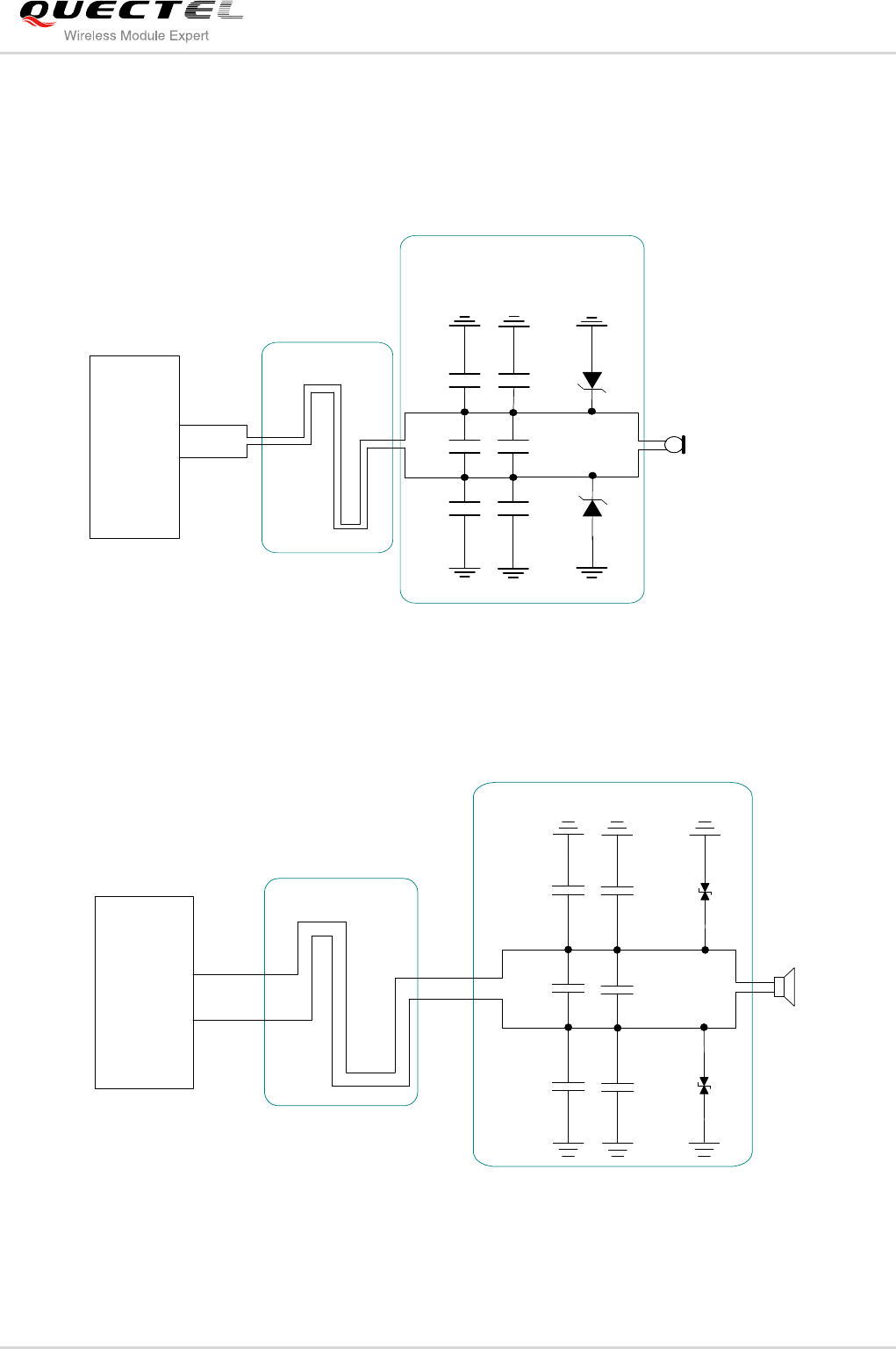
GSM/GPRS Module Series
M85 Hardware Design
M85_Hardware_Design Confidential / Released 46 / 88
3.8.2. Microphone Interfaces Design
AIN1 and AIN2 channels come with internal bias supply for external electret microphone. A reference
circuit is shown in the following figure.
MICxP
Differential
layout
Module 10pF 33pF
33pF
33pF
GND
GND
Electret
Microphone
GND
GND
10pF
10pF
GND
GND
ESD
ESD
MICxN
Close to
Microphone
0603
0603
0603
0603
0603
0603
Figure 25: Reference Design for AIN1&AIN2
3.8.3. Receiver and Speaker Interface Design
SPK1P
SPK1N
Differential layout
Module
10pF
0603
Close to speaker
GND
ESD
33pF
0603
33pF
0603
GND
10pF
0603 ESD
10pF
0603
33pF
0603
Figure 26: Handset Interface Design for AOUT1
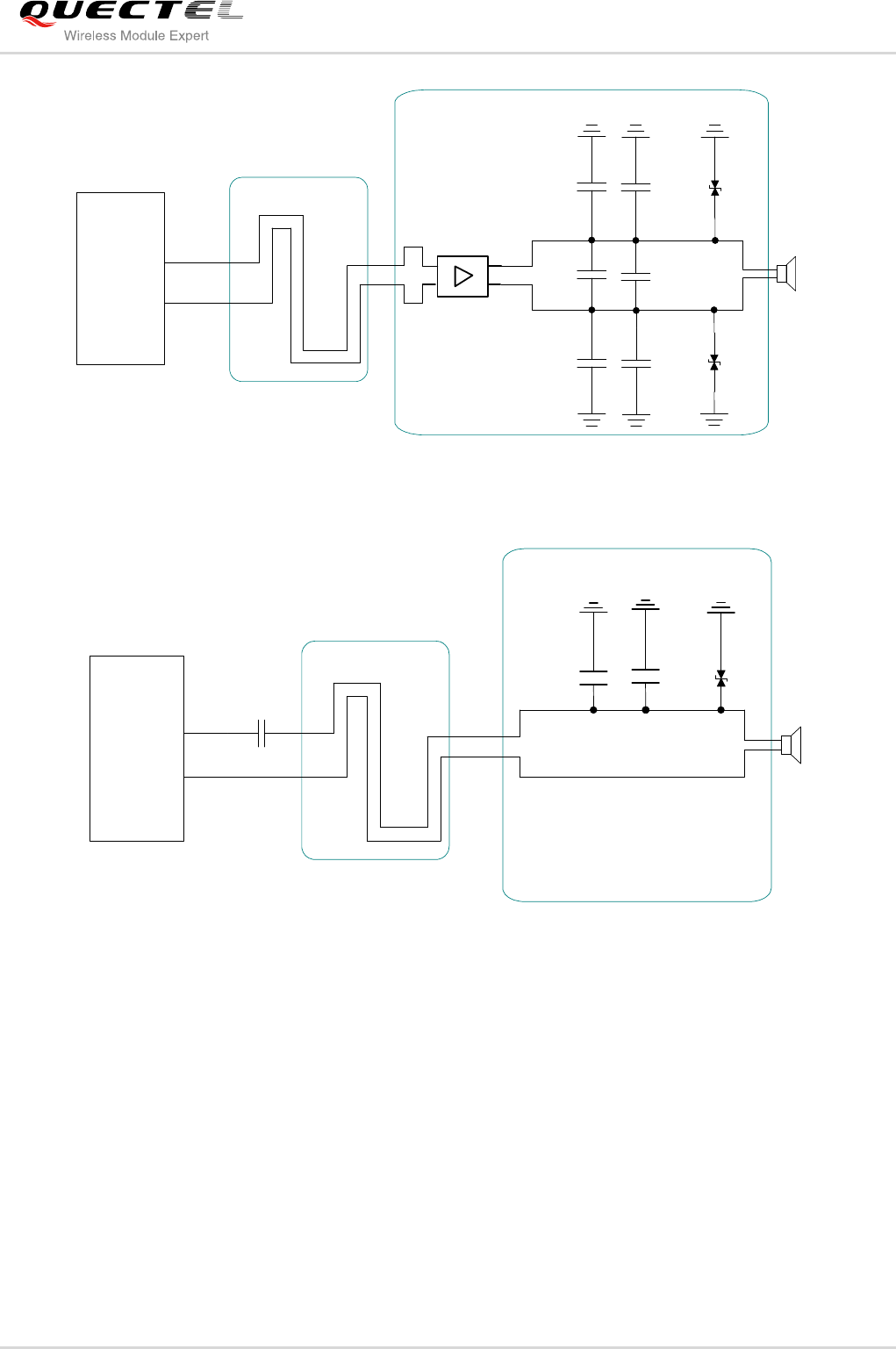
GSM/GPRS Module Series
M85 Hardware Design
M85_Hardware_Design Confidential / Released 47 / 88
SPK1P
SPK1N
Differential
layout Amplifier
circuit
Module
10pF
0603
Close to speaker
GND
ESD
33pF
0603
33pF
0603
GND
10pF
0603 ESD
10pF
0603
33pF
0603
Figure 27: Speaker Interface Design with an Amplifier for AOUT1
SPK2P
AGND
Differential layout 10pF
0603 33pF
0603
Close to Speaker
GND
ESD
Module
22uF
Figure 28: Handset Interface Design for AOUT2
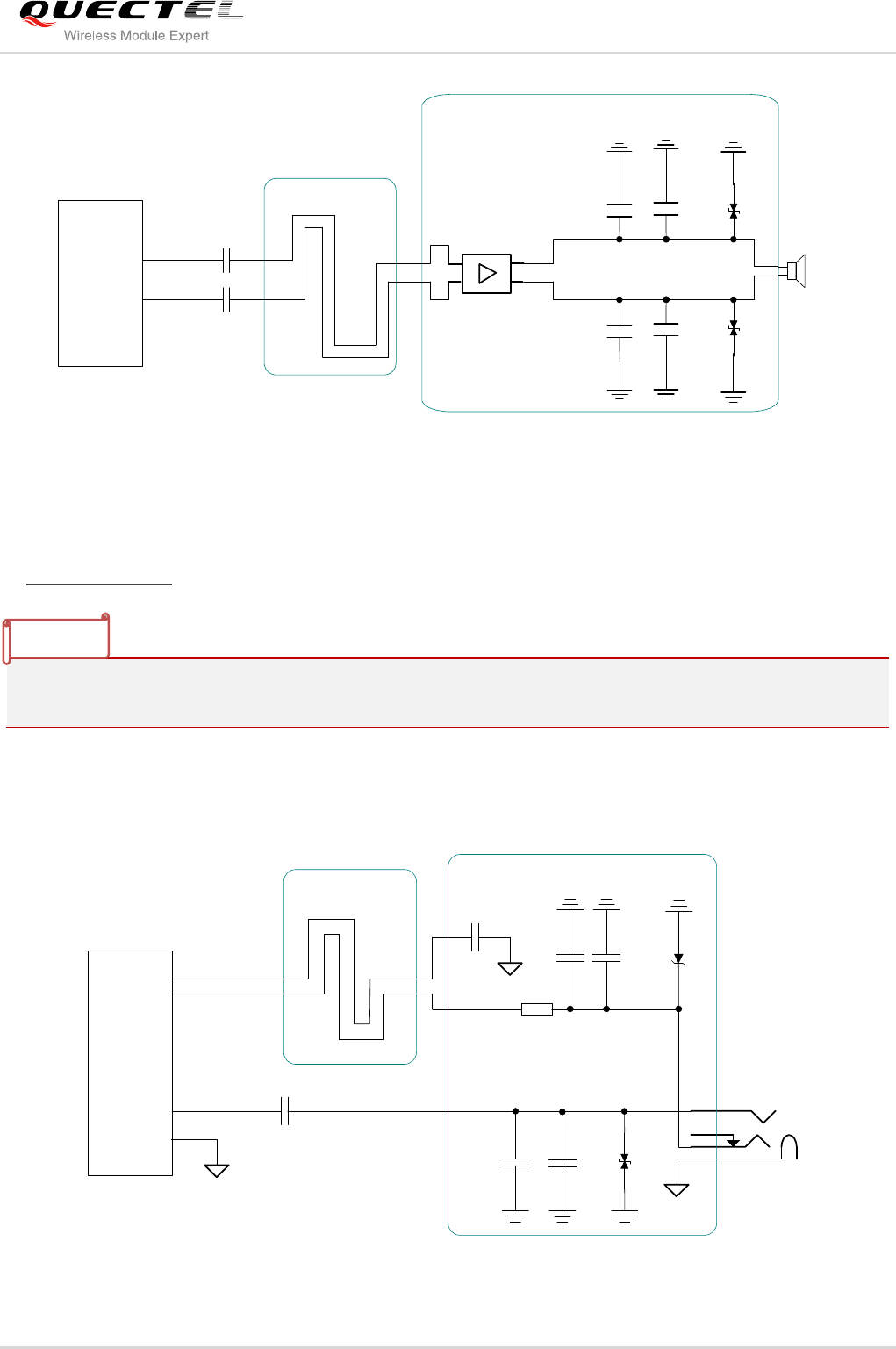
GSM/GPRS Module Series
M85 Hardware Design
M85_Hardware_Design Confidential / Released 48 / 88
Module
SPK2P
AGND
Differential layout Amplifier
circuit
10pF
0603
10pF
0603
33pF
0603
33pF
0603
Close to Speaker
GND
GND
ESD
ESD
C2
C1
Figure 29: Speaker Interface Design with an Amplifier for AOUT2
The suitable differential audio amplifier can be chosen from the Texas Instrument’s website
(http://www.ti.com/). There are other excellent audio amplifier vendors in the market too.
4.
The value of C1 and C2 here depends on the input impedance of audio amplifier.
3.8.4. Earphone Interface Design
1
2
4
3
SPK2P
MIC2N
MIC2P
22uF
68R
AGND
Close to Socket
Differential
layout
AGND
AGND
Module
4.7uF
ESD
GND
33pF
0603
10pF
0603
33pF
0603
GND
10pF
0603
ESD
Figure 30: Earphone Interface Design
NOTE
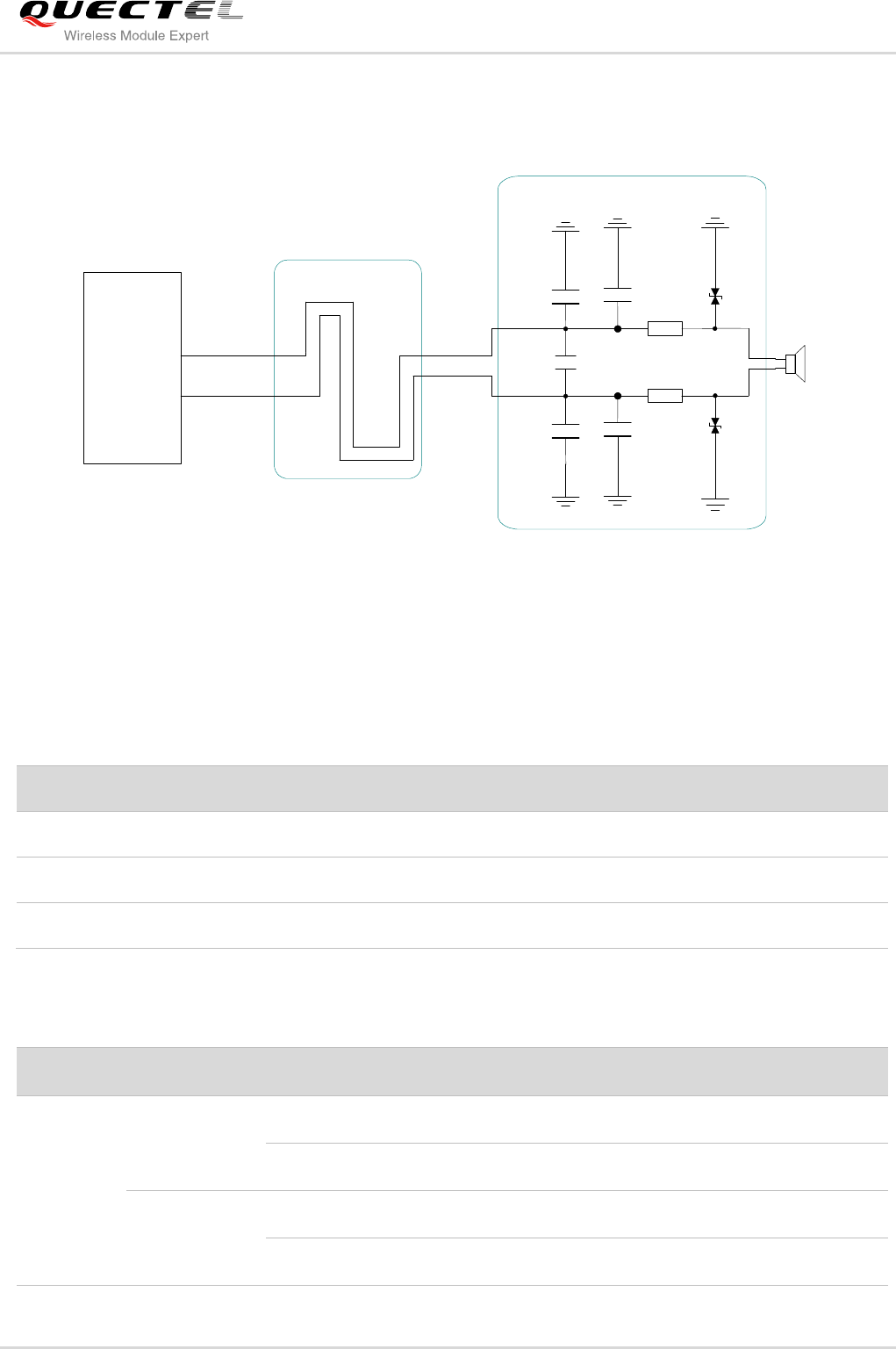
GSM/GPRS Module Series
M85 Hardware Design
M85_Hardware_Design Confidential / Released 49 / 88
3.8.5. Loud Speaker Interface Design
LOUDSPKP
LOUDSPKN
Differential layout 10pF
10pF 33pF
33pF
Close to Speaker
GND
GND
100pF
ESD
ESD
Module
0R
0R
0603
0603 0603
0603
Figure 31: Loud Speaker Interface Design
3.8.6. Audio Characteristics
Table 10: Typical Electret Microphone Characteristics
Table 11: Typical Speaker Characteristics
Parameter
Min.
Typ.
Max.
Unit
Working Voltage
1.2
1.5
2.0
V
Working Current
200
500
uA
External Microphone Load Resistance
2.2
kΩ
Parameter
Min.
Typ.
Max.
Unit
AOUT1
Output
Single-ended
Load resistance
32
Ohm
Ref level
0
2.4
Vpp
Differential
Load resistance
32
Ohm
Ref level
0
4.8
Vpp

GSM/GPRS Module Series
M85 Hardware Design
M85_Hardware_Design Confidential / Released 50 / 88
3.9. SIM Card Interfaces
The module contains two SIM interfaces to allow module access the two SIM cards. Only one SIM card
can work at a time. Both of two SIM interfaces share the ground and only first SIM interface have card
insert detection.
In dual SIM card mode, configure AT+QDSIM=0 to use the SIM1 interface and configure AT+QDSIM=1 to
use SIM2 interface. For more details, please refer to the document [1].
The SIM interface supports the functionality of the GSM Phase 1 specification and also supports the
functionality of the new GSM Phase 2+ specification for FAST 64 kbps SIM card, which is intended for
use with a SIM application Tool-kit.
The SIM interface is powered by an internal regulator in the module. Both 1.8V and 3.0V SIM Cards are
supported.
Table 12: Pin Definition of the SIM Interface
AOUT2
Output
Single-ended
Load resistance
32
Ohm
Ref level
0
2.4
Vpp
AOUT3
Output
Differential
Load resistance
8
Ohm
Ref level
0
2×VBAT
Vpp
Pin Name
Pin No.
Description
SIM1_VDD
56
Supply power for SIM card. Automatic detection of SIM
card voltage. 3.0V±10% and 1.8V±10%. Maximum
supply current is around 10mA.
SIM2_VDD
71
SIM1_CLK
55
SIM card clock
SIM2_CLK
72
SIM1_DATA
54
SIM card data I/O
SIM2_DATA
73
SIM1_RST
53
SIM card reset
SIM2_RST
74
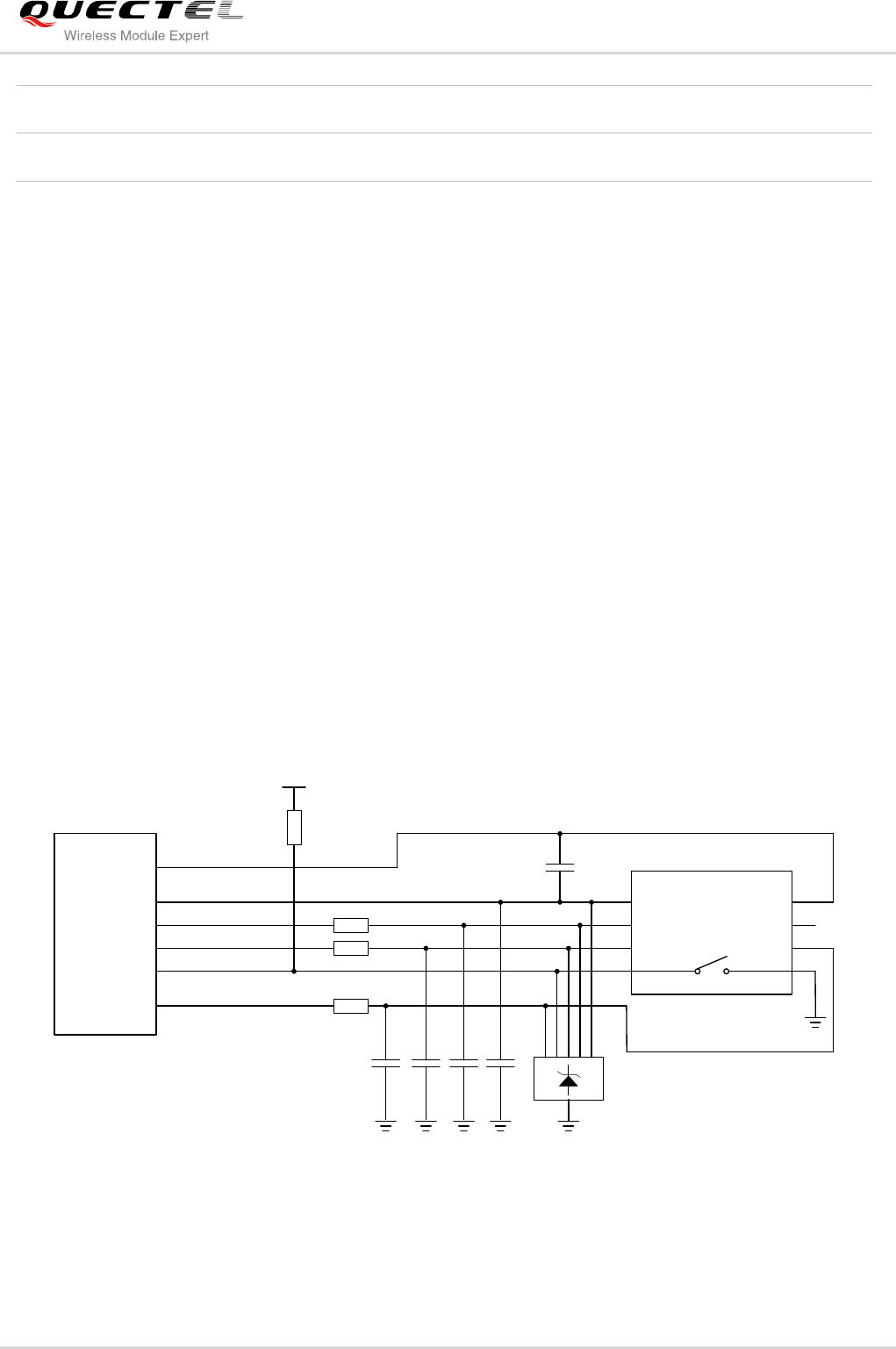
GSM/GPRS Module Series
M85 Hardware Design
M85_Hardware_Design Confidential / Released 51 / 88
The following figure is the reference design for SIM interface, and here an 8-pin SIM card holder is used.
The pin SIM1_PRESENCE is used to detect whether the tray of the Molex SIM socket, which is used for
holding SIM card, is present in the card socket. When the tray is inserted in the socket, SIM1_PRESENCE
is at low level. Regardless of the SIM card is in the tray or not, the change of SIM1_PRESENCE level from
high to low level prompts the module to reinitialize SIM card. In default configuration, SIM card detection
function is disabled. Your application can use AT+QSIMDET=1,0 and AT+QSIMDET=0,0 to switch on and
off the SIM card detection function. For details of this AT command, please refer to document [1]. When
AT+QSIMDET=1,0 is set and the tray with SIM card is removed from SIM socket, the following URC will be
presented:
+CPIN: NOT INSERTED
When the tray with SIM card is inserted into SIM socket again and the module finishes reinitializing SIM
card, the following URC will be presented:
+CPIN: READY
Call Ready
VDD_EXT
Module
SIM1_VDD
SIM_GND
SIM1_RST
SIM1_CLK
SIM1_DATA
SIM1_PRESENCE
22R
22R
22R
10K
100nF SIM_Holder
GND
GND
TVS
33pF33pF 33pF33pF
VCC
RST
CLK IO
VPP
GND
GND
Figure 32: Reference Circuit for SIM1 Interface with 8-pin SIM Card Holder
SIM1_PRESENCE
57
SIM1 card detection
SIM_GND
52
SIM card ground
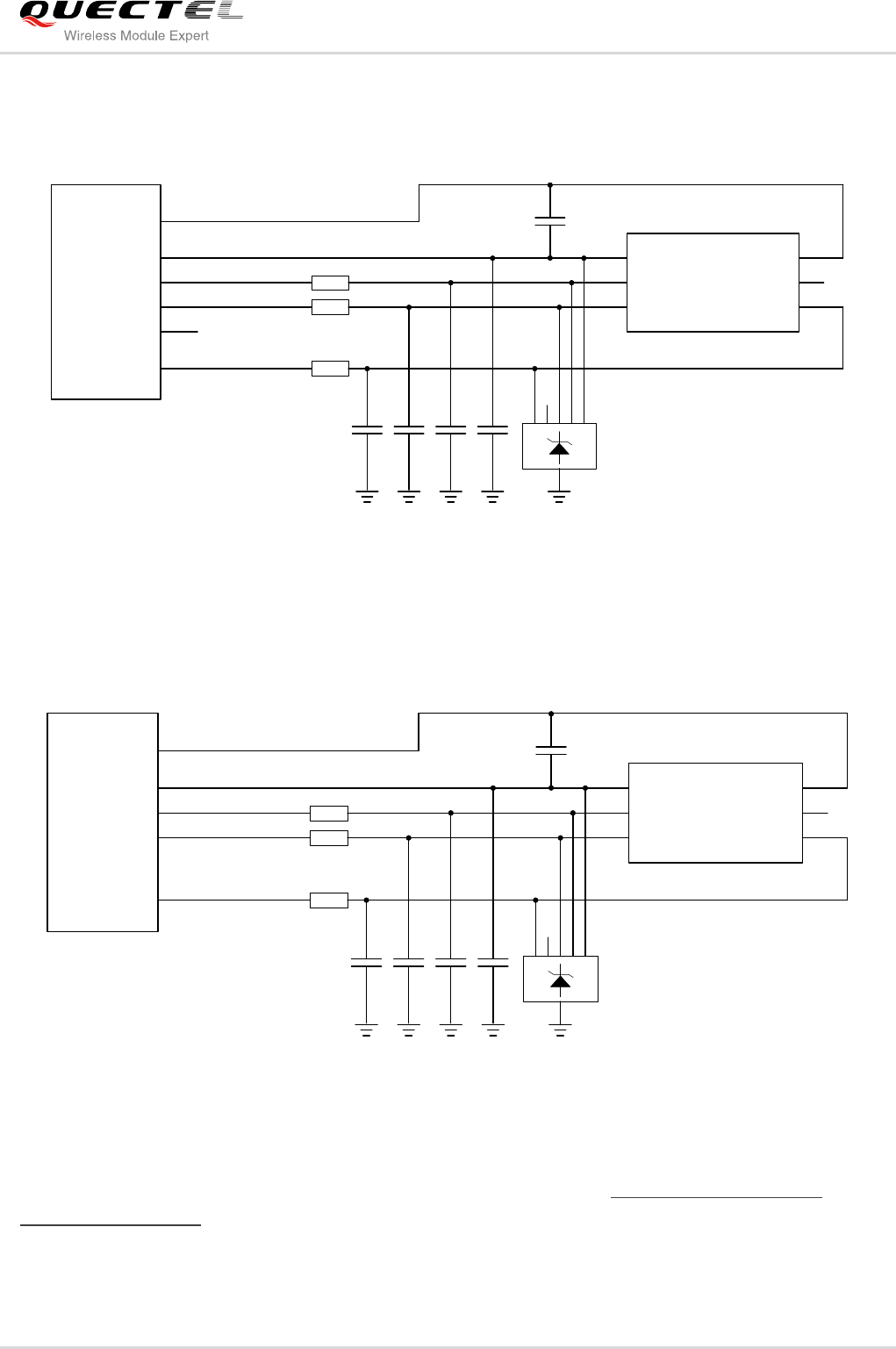
GSM/GPRS Module Series
M85 Hardware Design
M85_Hardware_Design Confidential / Released 52 / 88
If the SIM1 card detection function is not used, keep SIM1_PRESENCE pin open. The reference circuit
for a 6-pin SIM card socket is illustrated as the following figure.
Module
SIM1_VDD
SIM_GND
SIM1_RST
SIM1_CLK
SIM1_DATA
SIM1_PRESENCE
22R
22R
22R
100nF SIM_Holder
GND
TVS
33pF33pF 33pF
VCC
RST
CLK IO
VPP
GND
GND
33pF
Figure 33: Reference Circuit for SIM1 Interface with the 6-pin SIM Card Holder
The following figure is the reference design for SIM2 interface with the 6-pin SIM card holder.
Module
SIM2_VDD
SIM_GND
SIM2_RST
SIM2_CLK
SIM2_DATA 22R
22R
22R
100nF SIM_Holder
GND
TVS
33pF33pF 33pF
VCC
RST
CLK IO
VPP
GND
GND
33pF
Figure 34: Reference Circuit for SIM2 Interface with the 6-pin SIM Card Holder
For more information of SIM card holder, please visit http://www.amphenol.com and
http://www.molex.com.

GSM/GPRS Module Series
M85 Hardware Design
M85_Hardware_Design Confidential / Released 53 / 88
In order to enhance the reliability and availability of the SIM card in application. Please follow the below
criteria in the SIM circuit design:
Keep layout of SIM card as close as possible to the module. Assure the length of the trace as less
than 200mm as possible.
Keep SIM card signals away from RF and VBAT alignment.
Assure the ground between module and SIM cassette short and wide. Keep the width of ground no
less than 0.5mm to maintain the same electric potential. The decouple capacitor of SIM_VDD is less
than 1uF and must be near to SIM cassette.
To avoid cross talk between SIM_DATA and SIM_CLK. Keep them away with each other and shield
them with surrounded ground.
In order to offer good ESD protection, it is recommended to add a TVS diode array. For more
information of TVS diode, please visit http://www.onsemi.com/.The most important rule is to place the
ESD protection device close to the SIM card socket and make sure the nets being protected will go
through the ESD device first and then lead to module. The 22Ω resistors should be connected in
series between the module and the SIM card so as to suppress the EMI spurious transmission and
enhance the ESD protection. Please to be noted that the SIM peripheral circuit should be close to the
SIM card socket.
Place the RF bypass capacitors (33pF) close to the SIM card on all signal lines for improving EMI.
3.10. SD Card Interface
The module provides SD card interface that supports many types of memory, such as Memory Stick,
SD/MCC card and T-Flash or Micro SD card. The following are the main features of SD card interface.
Only supports 1bit serial mode.
Not support the SPI mode for SD memory card.
Not support multiple SD memory cards.
Not support hot plug.
The data rate up to 48MHz in serial mode.
Up to 32GB maximum memory card capacity.
With the SD card interface features and reference circuit shown as below, you can easily design the SD
card application circuit to enhance the memory capacity of the module. The users can store some
high-capacity files to external memory card. Such as in the automotive application system, the module
can record and store the audio file to the SD card, and also can play the audio files in SD card.
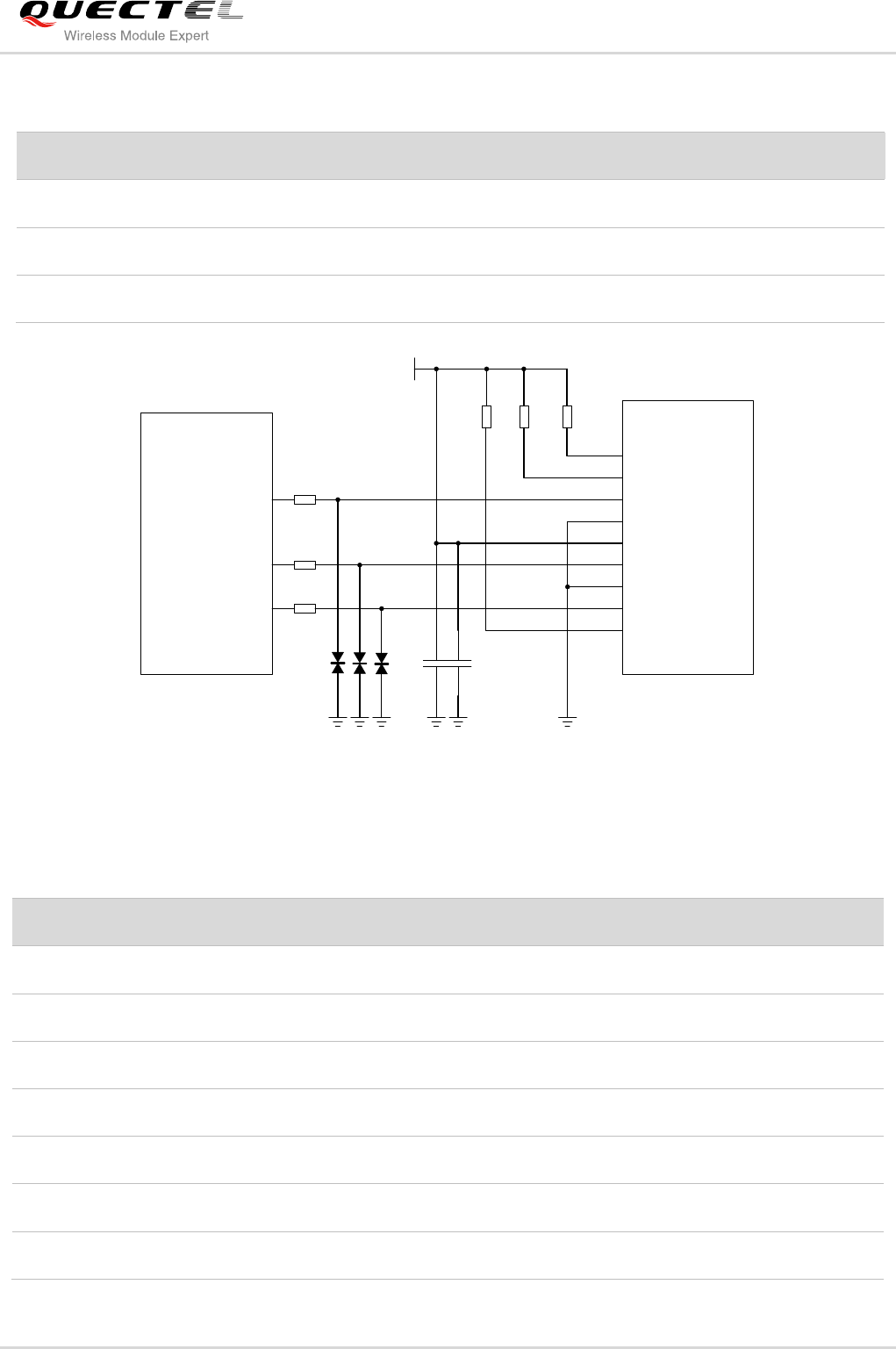
GSM/GPRS Module Series
M85 Hardware Design
M85_Hardware_Design Confidential / Released 54 / 88
Table 13: Pin Definition of the SD Card Interface
Module
SD_DATA0
SD_CLK
SD_CMD
DATA2
DATA1
DATA0
CD/DATA3
CMD
VSS1
VDD
CLK
VSS2
47K47K 47K
4.7uF 0.1nF
VDD_EXT
33R
33R
33R
SD Socket
1
2
3
4
5
6
7
8
9
Figure 35: Reference Circuit for SD Card
Table 14: Pin Definition of the SD Card Interface
Pin Name
Pin No.
Description
SD_CMD
34
Command signal of SD card output
SD_CLK
35
Clock signal of SD card output
SD_DATA0
36
Data output and input signal of SD card
Pin No.
Pin Name of SD Card
Pin Name of T-Flash (Micro SD) Card
1
CD/DATA3
DATA2
2
CMD
CD/DATA3
3
VSS1
CMD
4
VDD
VDD
5
CLK
CLK
6
VSS2
VSS
7
DATA0
DATA0

GSM/GPRS Module Series
M85 Hardware Design
M85_Hardware_Design Confidential / Released 55 / 88
In SD card interface designing, in order to ensure good communication performance with SD card, the
following design principles should be complied with:
Keep all the SD card signals far away from VBAT power and RF trace.
Route all SD card signals as short as possible. Ensure the length of every trace does not exceed
10cm.
The SD_CLK, SD_DATA0 and SD_CMD trace should be routed together. Keep trace difference of
SD_DATA0, SD_CMD and SD_CLK to be less than 10mm.
In order to offer good ESD protection, it is recommended to add TVS on signals with the capacitance
less than 15pF.
Reserve external pull-up resistors for other data lines except the DATA0 signal.
The SD_CLK and SD_DATA0 line must be shielded by ground in order to improve EMI.
3.11. PCM Interface
M85 supports PCM interface. It is used for digital audio transmission between the module and the device.
This interface is composed of PCM_CLK, PCM_SYNC, PCM_IN and PCM_OUT signal lines.
Pulse-code modulation (PCM) is a converter that changes the consecutive analog audio signal to discrete
digital signal. The whole procedure of Pulse-code modulation contains sampling, quantizing and
encoding.
Table 15: Pin Definition of PCM Interface
8
DATA1
DATA1
9
DATA2
Pin Name
Pin No.
Description
PCM_IN
18
PCM data input
PCM_CLK
19
PCM clock output
PCM_OUT
20
PCM data output
PCM_SYNC
21
PCM frame synchronization output

GSM/GPRS Module Series
M85 Hardware Design
M85_Hardware_Design Confidential / Released 56 / 88
3.11.1. Configuration
M85 module supports 13-bit line code PCM format. The sample rate is 8 KHz, and the clock source is 256
KHz, and the module can only act as master mode. The PCM interface supports both long and short
synchronization simultaneously. Furthermore, it only supports MSB first. For detailed information, please
refer to the table below.
Table 16: Configuration
3.11.2. Timing
The sample rate of the PCM interface is 8 KHz and the clock source is 256 KHz, so every frame contains
32 bits data, since M85 supports 16 bits line code PCM format, the left 16 bits are invalid. The following
diagram shows the timing of different combinations. The synchronization length in long synchronization
format can be programmed by firmware from one bit to eight bits. In the Sign extension mode, the high
three bits of 16 bits are sign extension, and in the Zero padding mode, the low three bits of 16 bits are
zero padding.
Under zero padding mode, you can configure the PCM input and output volume by executing
AT+QPCMVOL command. For more details, please refer to Chapter 3.11.4.
PCM
Line Interface Format
Linear
Data Length
Linear: 13 bits
Sample Rate
8KHz
PCM Clock/Synchronization Source
PCM master mode: clock and synchronization is
generated by module
PCM Synchronization Rate
8KHz
PCM Clock Rate
PCM master mode: 256 KHz (line)
PCM Synchronization Format
Long/short synchronization
PCM Data Ordering
MSB first
Zero Padding
Yes
Sign Extension
Yes
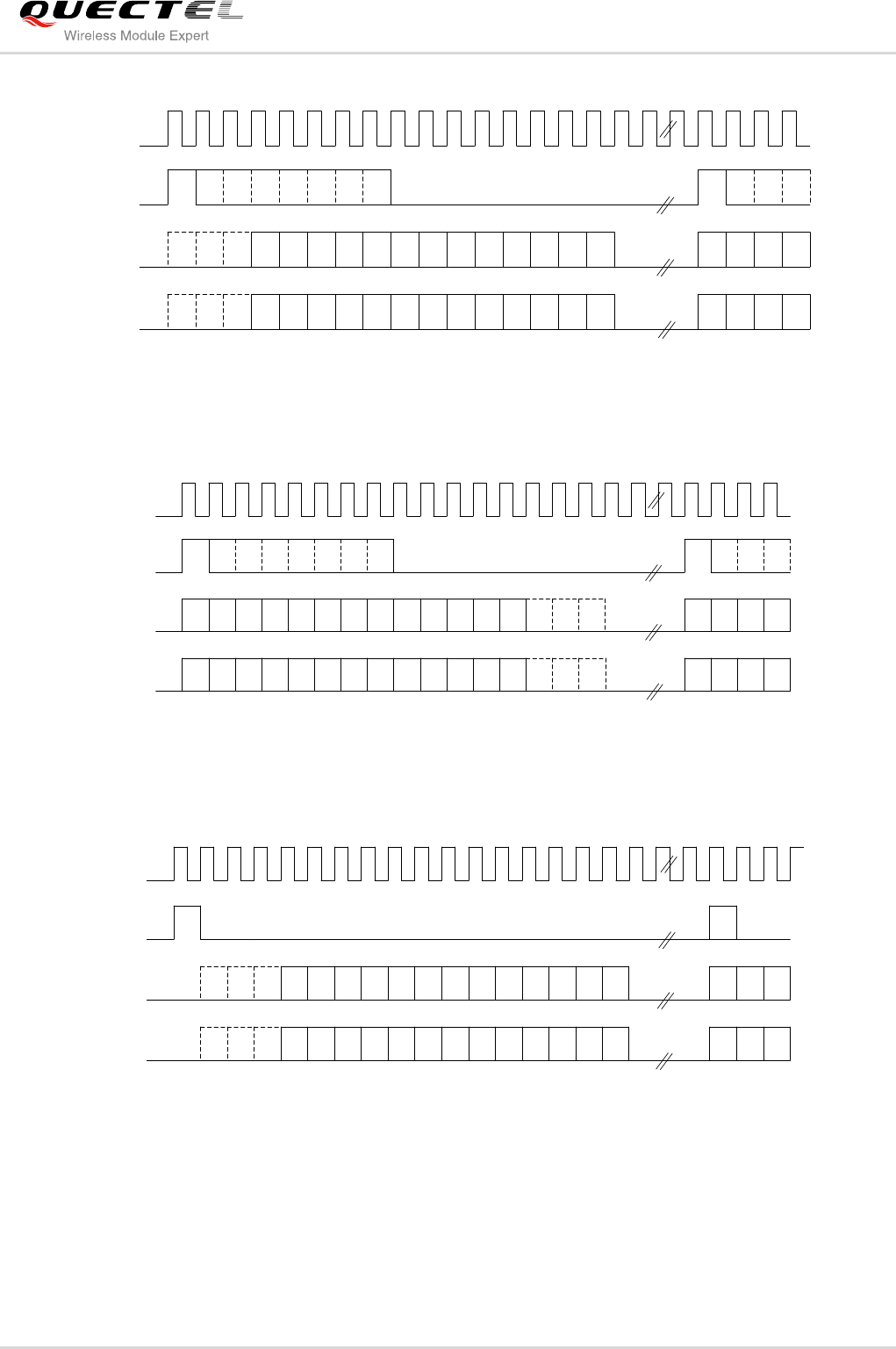
GSM/GPRS Module Series
M85 Hardware Design
M85_Hardware_Design Confidential / Released 57 / 88
12 11 10 9 8 7 6 5 4 3 2 1 0
12 11 10 9 8 7 6 5 4 3 2 1 0
PCM_CLK
PCM_SYNC
PCM_OUT
PCM_IN
MSB
MSB
Sign
extension
Sign
extension
Figure 36: Long Synchronization & Sign Extension Diagram
12 11 10 9 8 7 6 5 4 3 2 1 0
12 11 10 9 8 7 6 5 4 3 2 1 0
PCM_CLK
PCM_SYNC
PCM_OUT
PCM_IN
MSB
MSB
Zero padding
Zero padding
Figure 37: Long Synchronization & Zero Padding Diagram
PCM_CLK
PCM_SYNC
PCM_OUT
PCM_IN
12 11 10 9 8 7 6 5 4 3 2 1 0
12 11 10 9 8 7 6 5 4 3 2 1 0
MSB
MSB
Sign extension
Sign extension
Figure 38: Short synchronization & Sign Extension Diagram
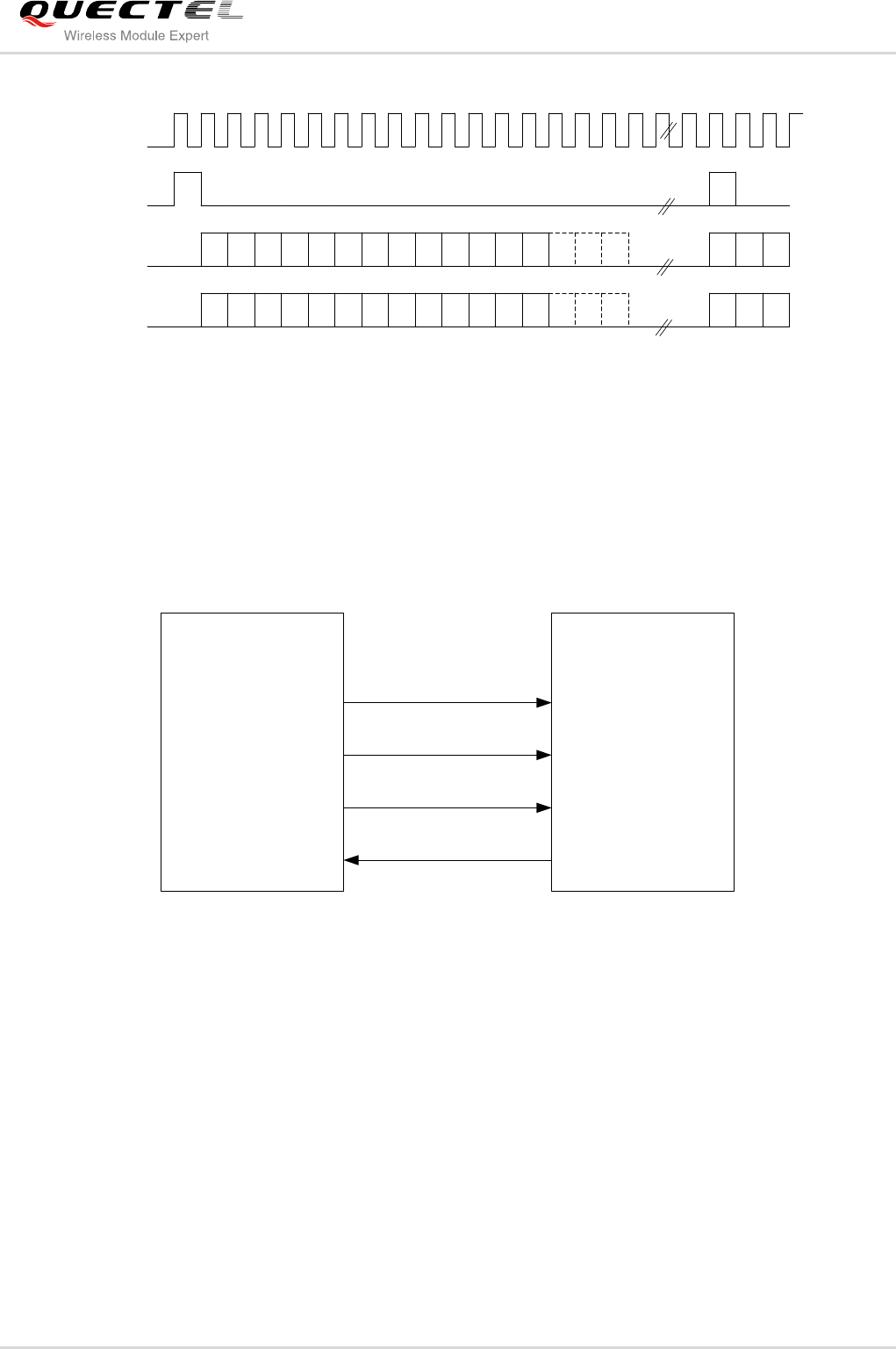
GSM/GPRS Module Series
M85 Hardware Design
M85_Hardware_Design Confidential / Released 58 / 88
PCM_CLK
PCM_SYNC
PCM_OUT
PCM_IN
12 11 10 9 8 7 6 5 4 3 2 1 0
12 11 10 9 8 7 6 5 4 3 2 1 0
MSB
MSB
Zero padding
Zero padding
Figure 39: Short Synchronization & Zero Padding Diagram
3.11.3. Reference Design
M85 can only work as a master, providing synchronization and clock source. The reference design is
shown as below.
PCM_SYNC
PCM_CLK
PCM_OUT
PCM_IN
PCM_SYNC
PCM_CLK
PCM_IN
PCM_OUT
Module
(Master)
Peripheral
(Slave)
Figure 40: Reference Design for PCM
3.11.4. AT Command
There are two AT commands about the configuration of PCM are listed as below.
AT+QPCMON can configure operating mode of PCM.
AT+QPCMON= mode,Sync_Type,Sync_Length,SignExtension,MSBFirst.

GSM/GPRS Module Series
M85 Hardware Design
M85_Hardware_Design Confidential / Released 59 / 88
Table 17: QPCMON Command Description
AT+QPCMVOL can configure the volume of input and output.
AT+QPCMVOL=vol_pcm_in, vol_pcm_out
Table 18: QPCMVOL Command Description
3.12. ADC
The module provides an ADC channel to measure the value of voltage. Please give priority to the use of
ADC0 channel. The command AT+QADC can read the voltage value applied on ADC0 pin. For details of
this AT command, please refer to the document [1]. In order to improve the accuracy of ADC, the layout
of ADC should be surrounded by ground.
Parameter
Scope
Description
Mode
0~2
0: Close PCM
1: Open PCM
2: Open PCM when audio talk is set up
Sync_Type
0~1
0: Short synchronization
1: Long synchronization
Sync_Length
1~8
Programmed from one bit to eight bit
SignExtension
0~1
0: Zero padding
1: Sign extension
MSBFirst
0~1
0: MSB first
1: Not supported
Parameter
Scope
Description
vol_pcm_in
0~32767
Set the input volume
vol_pcm_out
0~32767
Set the output volume
The voice may be distorted when this value exceeds 16384.

GSM/GPRS Module Series
M85 Hardware Design
M85_Hardware_Design Confidential / Released 60 / 88
Table 19: Pin Definition of the ADC
Table 20: Characteristics of the ADC
3.13. Behaviors Of The RI
Table 21: Behaviors of the RI
If URC of SMS is disabled, the RI will not change.
Pin Name
Pin No.
Description
ADC0
2
Analog to digital converter.
Item
Min.
Typ.
Max.
Units
Voltage Range
0
2.8
V
ADC Resolution
10
bits
ADC Accuracy
2.7
mV
State
RI response
Standby
HIGH
Voice Calling
Change to LOW, then:
1. Change to HIGH when call is established.
2. Use ATH to hang up the call, RI changes to HIGH.
3. Calling part hangs up, RI changes to HIGH first, and changes to LOW for
120ms indicating ―NO CARRIER‖ as an URC, then changes to HIGH again.
4. Change to HIGH when SMS is received.
SMS
When a new SMS comes, the RI changes to LOW and holds low level for about 120
ms, then changes to HIGH.
URC
Certain URCs can trigger 120ms low level on RI.
NOTE

GSM/GPRS Module Series
M85 Hardware Design
M85_Hardware_Design Confidential / Released 61 / 88
If the module is used as a caller, the RI would maintain high except the URC or SMS is received. On the
other hand, when it is used as a receiver, the timing of the RI is shown as below.
RI
Idle Ring
Off-hook by“ATA”
On-hook by “ATH”
SMS received
HIGH
LOW
Figure 41: RI Behavior of Voice Calling as a Receiver
RI
Idle Calling On-hook
Talking
HIGH
LOW
Idle
Figure 42: RI Behavior as a Caller
RI
Idle or
Talking
URC or
SMS received
HIGH
LOW
120ms
Figure 43: RI Behavior of URC or SMS Received

GSM/GPRS Module Series
M85 Hardware Design
M85_Hardware_Design Confidential / Released 62 / 88
3.14. Network Status Indication
The NETLIGHT signal can be used to drive a network status indicator LED. The working state of this pin
is listed in the following table.
Table 22: Working State of the NETLIGHT
A reference circuit is shown as below.
Module
NETLIGHT 4.7K
47K
300R
VBAT
Figure 44: Reference Design for NETLIGHT
3.15. Operating Status Indication
The STATUS pin will output a high level after the module being turned on, but it is not recommended
connecting this pin to a MCU’s GPIO to judge whether the module is turn-on or not. The following LED
indicator circuit for STATUS pin can be used to indicate the state after the module has been turned on.
State
Module function
Off
The module is not running.
64ms On/800ms Off
The module is not synchronized with network.
64ms On/2000ms Off
The module is synchronized with network.
64ms On/600ms Off
The GPRS data transmission after dialing the PPP connection.
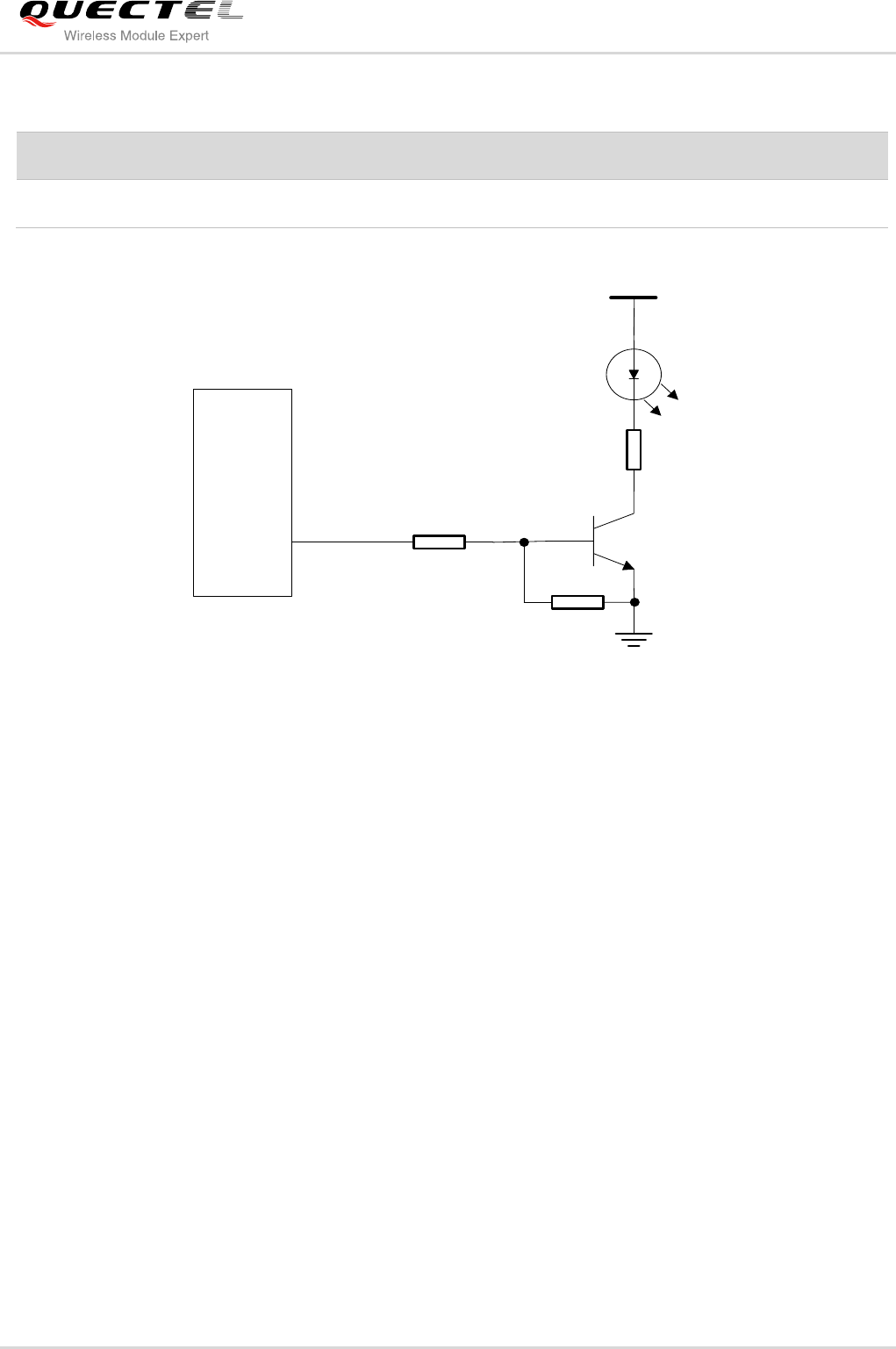
GSM/GPRS Module Series
M85 Hardware Design
M85_Hardware_Design Confidential / Released 63 / 88
Table 23: Pin Definition of the STATUS
Module
300R
4.7K
47K
VBAT
STATUS
Figure 45: Reference Design for STATUS
Pin Name
Pin No.
Description
STATUS
16
Indicate module operating status
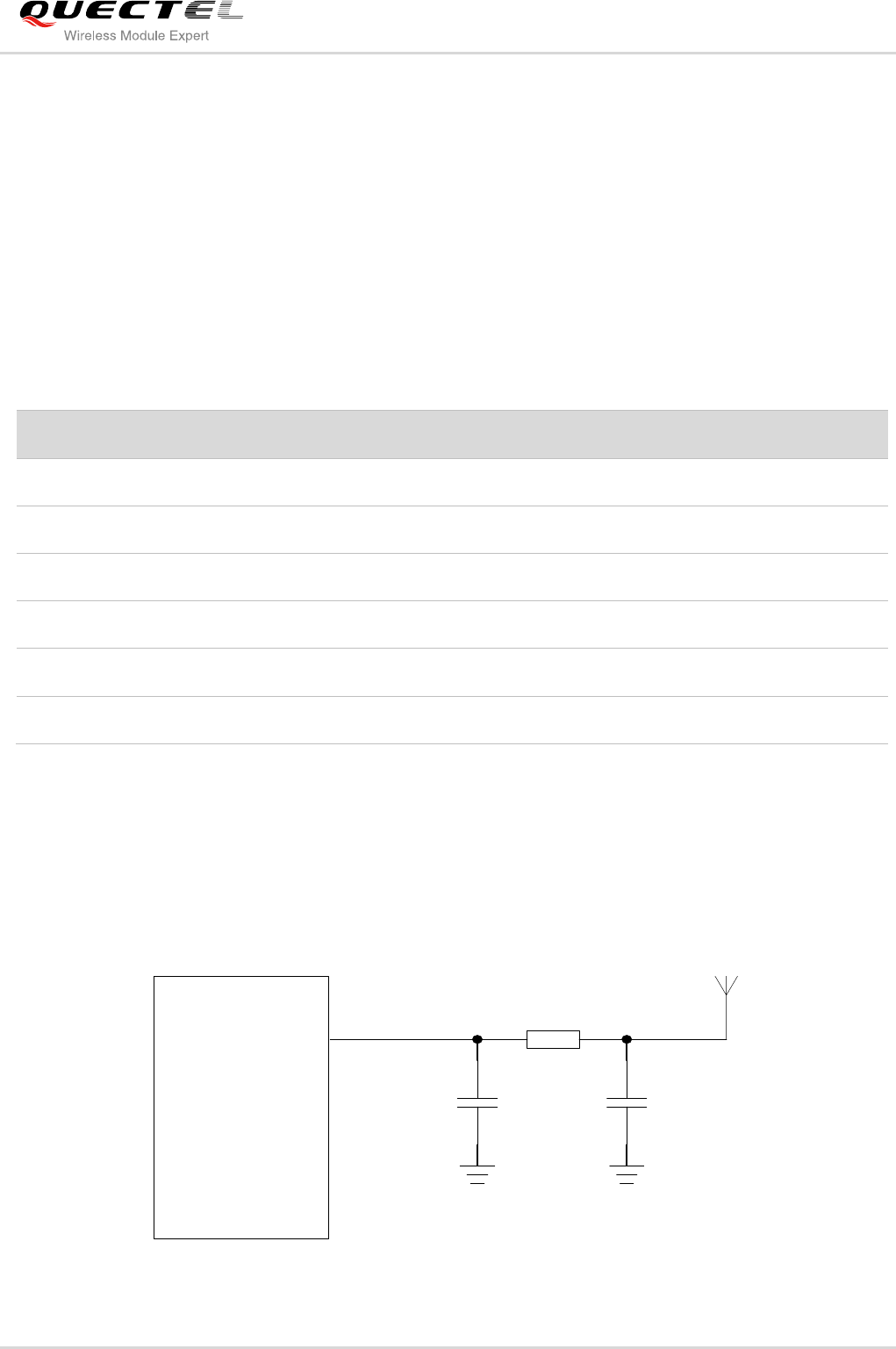
GSM/GPRS Module Series
M85 Hardware Design
M85_Hardware_Design Confidential / Released 64 / 88
4 Antenna Interface
The Pin 63 is the RF antenna pad. The RF interface has an impedance of 50Ω.
Table 24: Pin Definition of the RF_ANT
4.1. Reference Design
The external antenna must be matched properly to achieve best performance, so the matching circuit is
necessary, the reference design for RF is shown as below.
Module
RF_ANT
0R
NM NM
Figure 46: Reference Design for RF
Pin Name
Pin No.
Description
GND
61
Ground
GND
62
Ground
RF_ANT
63
RF antenna pad
GND
64
Ground
GND
65
Ground
GND
66
Ground

GSM/GPRS Module Series
M85 Hardware Design
M85_Hardware_Design Confidential / Released 65 / 88
M85 provides an RF antenna pad for antenna connection. The RF trace in host PCB connected to the
module RF antenna pad should be coplanar waveguide line or microstrip line, whose characteristic
impedance should be close to 50Ω. M85 comes with grounding pads which are next to the antenna pad in
order to give a better grounding. Besides, a π type match circuit is suggested to be used to adjust the RF
performance.
4.2. RF Output Power
Table 25: The Module Conducted RF Output Power
In GPRS 4 slots TX mode, the max output power is reduced by 2.5dB. This design conforms to the GSM
specification as described in Section 13.16 of 3GPP TS 51.010-1.
4.3. RF Receiving Sensitivity
Table 26: The Module Conducted RF Receiving Sensitivity
Frequency
Max.
Min.
GSM850
33dBm±2dB
5dBm±5dB
EGSM900
33dBm±2dB
5dBm±5dB
DCS1800
30dBm±2dB
0dBm±5dB
PCS1900
30dBm±2dB
0dBm±5dB
Frequency
Receive Sensitivity
GSM850
< -109dBm
EGSM900
< -109dBm
DCS1800
< -109dBm
PCS1900
< -109dBm
NOTE

GSM/GPRS Module Series
M85 Hardware Design
M85_Hardware_Design Confidential / Released 66 / 88
4.4. Operating Frequencies
Table 27: The Module Operating Frequencies
4.5. Antenna Requirement
The following table shows the requirement on GSM antenna.
Table 28: Antenna Cable Requirements
Type
Requirements
GSM850/EGSM900
Cable insertion loss <1dB
DCS1800/PCS1900
Cable insertion loss <1.5dB
Table 29: Antenna Requirements
Type
Requirements
Frequency Range
GSM850/EGSM900/DCS1800/PCS1900MHz.
VSWR
≤ 2
Gain (dBi)
1
Max Input Power (W)
50
Input Impedance (Ω)
50
Polarization Type
Vertical
Frequency
Receive
Transmit
ARFCH
GSM850
869~894MHz
824~849MHz
128~251
EGSM900
925~960MHz
880~915MHz
0~124, 975~1023
DCS1800
1805~1880MHz
1710~1785MHz
512~885
PCS1900
1930~1990MHz
1850~1910MHz
512~810

GSM/GPRS Module Series
M85 Hardware Design
M85_Hardware_Design Confidential / Released 67 / 88
4.6. RF Cable Soldering
Soldering the RF cable to RF pad of module correctly will reduce the loss on the path of RF, please refer
to the following example of RF soldering.
Figure 47: RF Soldering Sample

GSM/GPRS Module Series
M85 Hardware Design
M85_Hardware_Design Confidential / Released 68 / 88
5 Electrical, Reliability and Radio
Characteristics
5.1. Absolute Maximum Ratings
Absolute maximum ratings for power supply and voltage on digital and analog pins of module are listed in
the following table:
Table 30: Absolute Maximum Ratings
Parameter
Min.
Max.
Unit
VBAT
-0.3
+4.73
V
Peak current of power supply
0
2
A
RMS current of power supply (during one TDMA- frame)
0
0.7
A
Voltage at digital pins
-0.3
3.08
V
Voltage at analog pins
-0.3
3.08
V
Voltage at digital/analog pins in power down mode
-0.25
0.25
V

GSM/GPRS Module Series
M85 Hardware Design
M85_Hardware_Design Confidential / Released 69 / 88
5.2. Operating Temperature
The operating temperature is listed in the following table:
Table 31: Operating Temperature
1) When the module works within this temperature range, the deviation from the GSM specification may
occur. For example, the frequency error or the phase error will be increased.
5.3. Power Supply Ratings
Table 32: The Module Power Supply Ratings
Parameter
Min.
Typ.
Max.
Unit
Normal Temperature
-35
+25
+80
℃
Restricted Operation1)
-40 ~ -35
+80 ~ +85
℃
Storage Temperature
-45
+90
℃
Parameter
Description
Conditions
Min.
Typ.
Max.
Unit
VBAT
Supply voltage
Voltage must stay within the
min/max values, including
voltage drop, ripple, and
spikes.
3.3
4.0
4.6
V
Voltage drop
during
transmitting
burst
Maximum power control level
on GSM850 and EGSM900.
400
mV
IVBAT
Average supply
current
Power down mode
SLEEP mode @DRX=5
150
1.3
uA
mA
Minimum functionality mode
AT+CFUN=0
IDLE mode
SLEEP mode
13
0.98
mA
mA
NOTE

GSM/GPRS Module Series
M85 Hardware Design
M85_Hardware_Design Confidential / Released 70 / 88
1. 1) Power control level PCL 5.
2. 2) Power control level PCL 0.
3. 3) Under the GSM850 and EGSM900 spectrum, the power of 1Rx and 4Tx has been reduced.
5.4. Current Consumption
The values of current consumption are shown as below.
Table 33: The Module Current Consumption
AT+CFUN=4
IDLE mode
SLEEP mode
13
1.0
mA
mA
TALK mode
GSM850/EGSM9001)
DCS1800/PCS19002)
223/219
153/151
mA
mA
DATA mode, GPRS (3Rx,2Tx)
GSM850/EGSM9001)
DCS1800/PCS19002)
363/393
268/257
mA
mA
DATA mode, GPRS (2Rx,3Tx)
GSM850/EGSM9001)
DCS1800/PCS19002)
506/546
366/349
mA
mA
DATA mode, GPRS (4Rx,1Tx)
GSM850/EGSM9001)
DCS1800/PCS19002)
217/234
172/170
mA
mA
DATA mode, GPRS (1Rx,4Tx)
GSM850/EGSM9001)
DCS1800/PCS19002)
458/4853)
462/439
mA
mA
Peak supply
current (during
transmission
slot)
Maximum power control level
on GSM850 and EGSM900.
1.6
2
A
Condition
Current Consumption
Voice Call
GSM850
@power level #5 <300mA, Typical 223mA
NOTES

GSM/GPRS Module Series
M85 Hardware Design
M85_Hardware_Design Confidential / Released 71 / 88
@power level #12, Typical 83mA
@power level #19, Typical 62mA
EGSM900
@power level #5 <300mA, Typical 219mA
@power level #12, Typical 83mA
@power level #19, Typical 63mA
DCS1800
@power level #0 <250mA, Typical 153mA
@power level #7, Typical 73mA
@power level #15, Typical 60mA
PCS1900
@power level #0 <250mA, Typical 151mA
@power level #7, Typical 76mA
@power level #15, Typical 61mA
GPRS Data
DATA Mode, GPRS (3Rx, 2Tx) CLASS 12
GSM850
@power level #5 <550mA, Typical 363mA
@power level #12, Typical 131mA
@power level #19, Typical 91mA
EGSM900
@power level #5 <550mA, Typical 393mA
@power level #12, Typical 132mA
@power level #19, Typical 92mA
DCS1800
@power level #0 <450mA, Typical 268mA
@power level #7, Typical 112mA
@power level #15, Typical 88mA
PCS1900
@power level #0 <450mA, Typical 257mA
@power level #7, Typical 119mA
@power level #15, Typical 89mA
DATA Mode, GPRS (2Rx, 3Tx) CLASS 12
GSM850
@power level #5 <640mA, Typical 506mA
@power level #12, Typical 159mA
@power level #19, Typical 99mA
EGSM900
@power level #5 <600mA, Typical 546mA
@power level #12, Typical 160mA
@power level #19, Typical 101mA
DCS1800
@power level #0 <490mA, Typical 366mA
@power level #7, Typical 131mA
@power level #15, Typical 93mA
PCS1900
@power level #0 <480mA, Typical 348mA
@power level #7, Typical 138mA
@power level #15, Typical 94mA
DATA Mode, GPRS (4Rx, 1Tx) CLASS 12

GSM/GPRS Module Series
M85 Hardware Design
M85_Hardware_Design Confidential / Released 72 / 88
GPRS Class 12 is the default setting. The module can be configured from GPRS Class 1 to Class 12.
Setting to lower GPRS class would make it easier to design the power supply for the module.
5.5. Electro-static Discharge
Although the GSM engine is generally protected against Electro-static Discharge (ESD), ESD protection
precautions should still be emphasized. Proper ESD handling and packaging procedures must be applied
throughout the processing, handling and operation of any applications using the module.
GSM850
@power level #5 <350mA, Typical 216mA
@power level #12, Typical 103mA
@power level #19, Typical 83mA
EGSM900
@power level #5 <350mA, Typical 233mA
@power level #12, Typical 104mA
@power level #19, Typical 84mA
DCS1800
@power level #0 <300mA, Typical 171mA
@power level #7, Typical 96mA
@power level #15, Typical 82mA
PCS1900
@power level #0 <300mA, Typical 169mA
@power level #7, Typical 98mA
@power level #15, Typical 83mA
DATA Mode, GPRS (1Rx, 4Tx) CLASS 12
GSM850
@power level #5 <660mA, Typical 457mA
@power level #12, Typical 182mA
@power level #19, Typical 106mA
EGSM900
@power level #5 <660mA, Typical 484mA
@power level #12, Typical 187mA
@power level #19, Typical 109mA
DCS1800
@power level #0 <530mA, Typical 461mA
@power level #7, Typical 149mA
@power level #15, Typical 97mA
PCS1900
@power level #0 <530mA, Typical 439mA
@power level #7, Typical 159mA
@power level #15, Typical 99mA
NOTE

GSM/GPRS Module Series
M85 Hardware Design
M85_Hardware_Design Confidential / Released 73 / 88
The measured ESD values of module are shown as the following table:
Table 34: The ESD Endurance (Temperature: 25ºC , Humidity: 45%)
Tested Point
Contact Discharge
Air Discharge
VBAT, GND
±5KV
±10KV
RF_ANT
±5KV
±10KV
TXD, RXD
±2KV
±4KV
Others
±0.5KV
±1KV
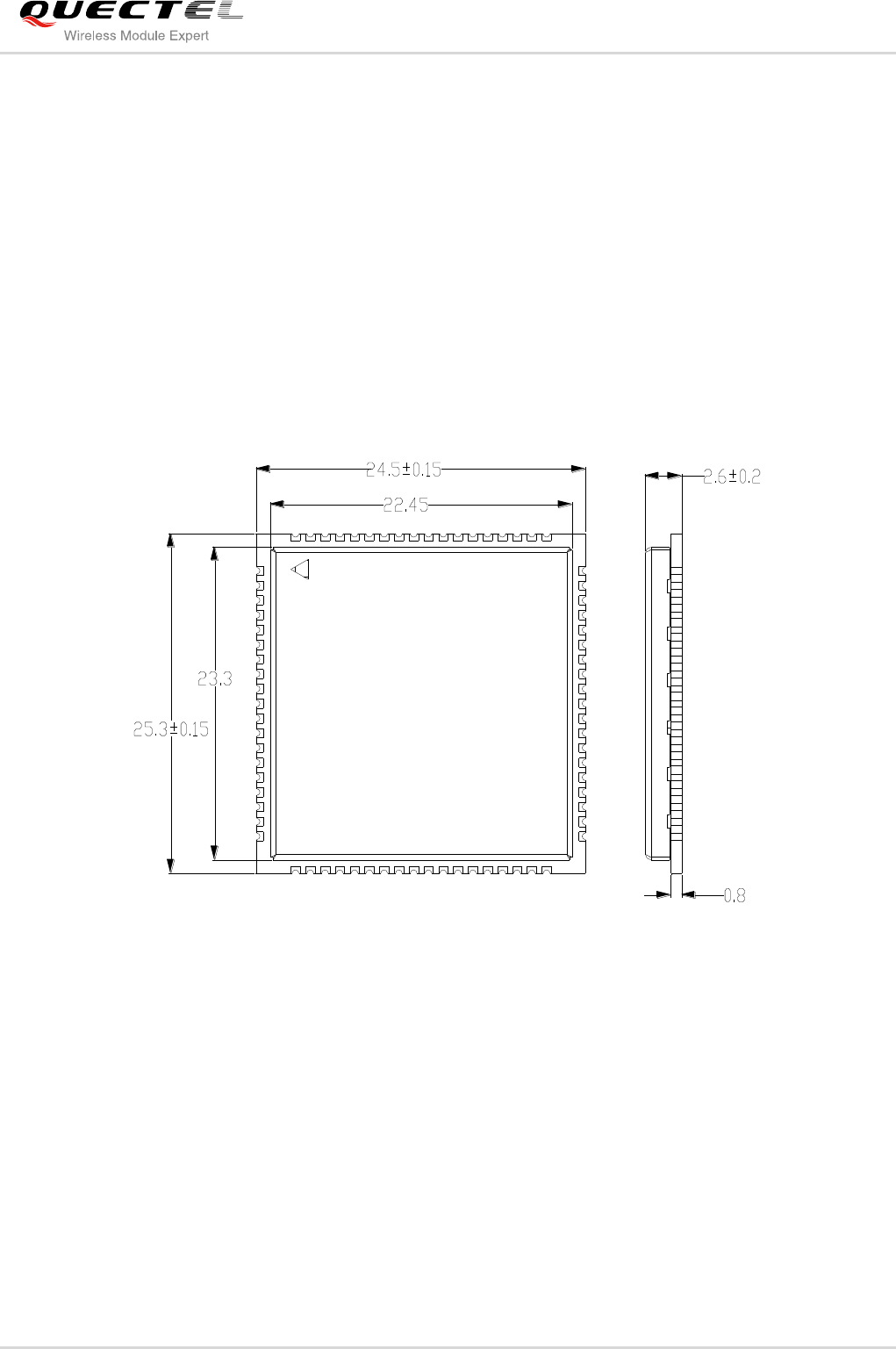
GSM/GPRS Module Series
M85 Hardware Design
M85_Hardware_Design Confidential / Released 74 / 88
6 Mechanical Dimensions
This chapter describes the mechanical dimensions of the module.
6.1. Mechanical Dimensions of Module
Figure 48: M85 Module Top and Side Dimensions (Unit: mm)
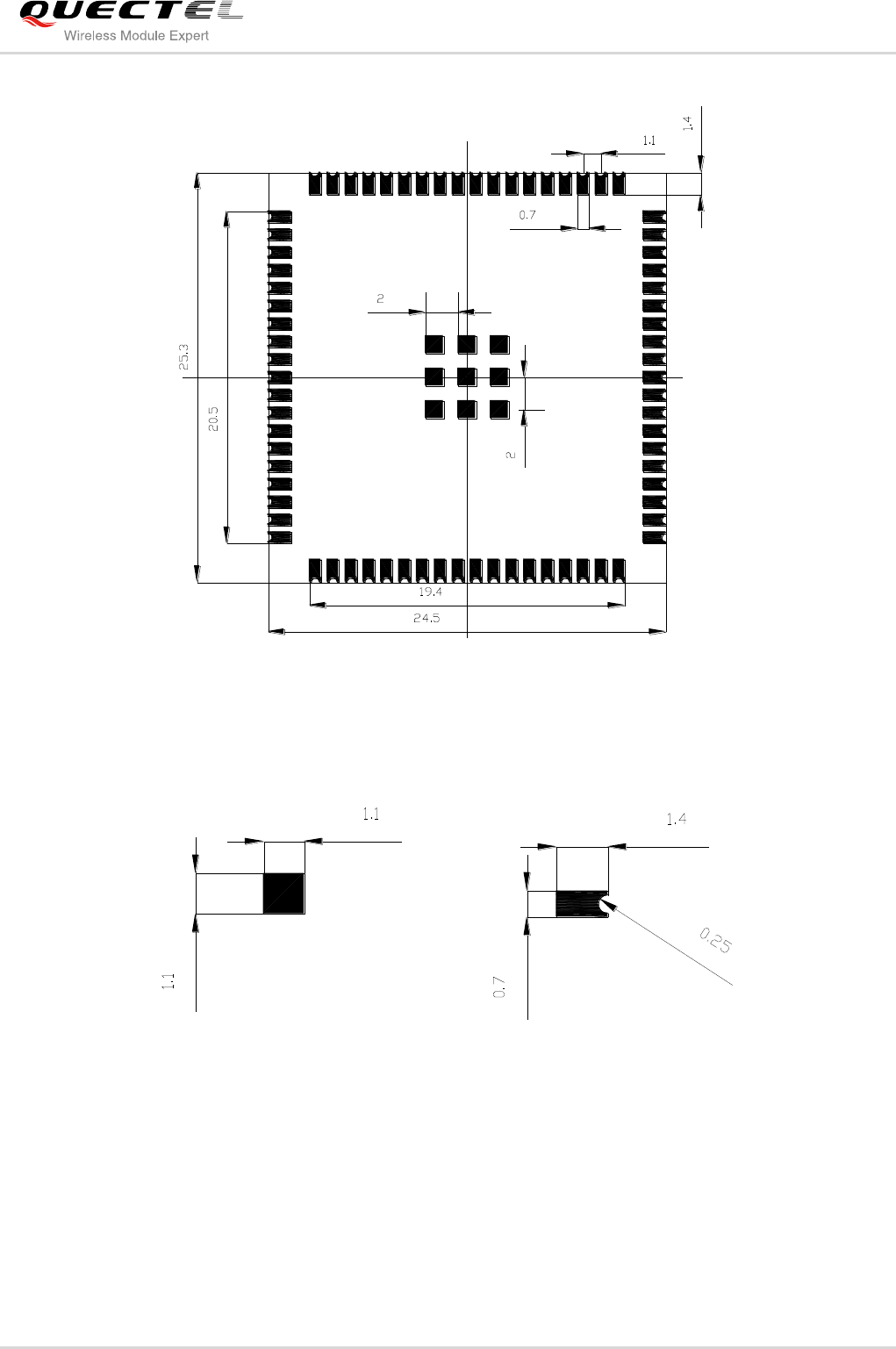
GSM/GPRS Module Series
M85 Hardware Design
M85_Hardware_Design Confidential / Released 75 / 88
Figure 49: M85 Module Bottom Dimensions (Unit: mm)
Figure 50: The PAD Dimensions (Unit: mm)
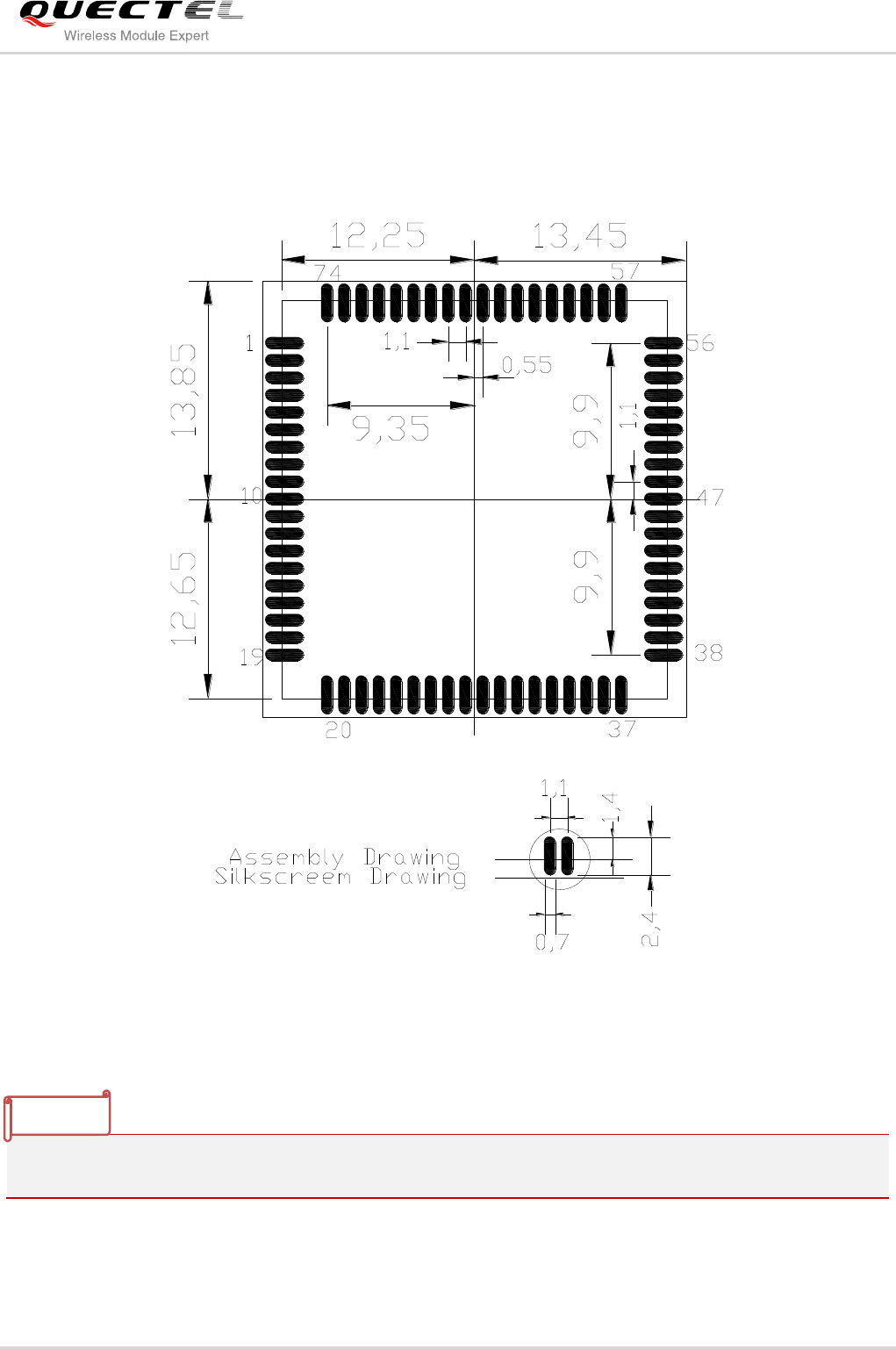
GSM/GPRS Module Series
M85 Hardware Design
M85_Hardware_Design Confidential / Released 76 / 88
6.2. Recommended Footprint
Figure 51: Recommended Footprint (Unit: mm)
The module should keep about 3mm away from other components in the host PCB.
NOTE
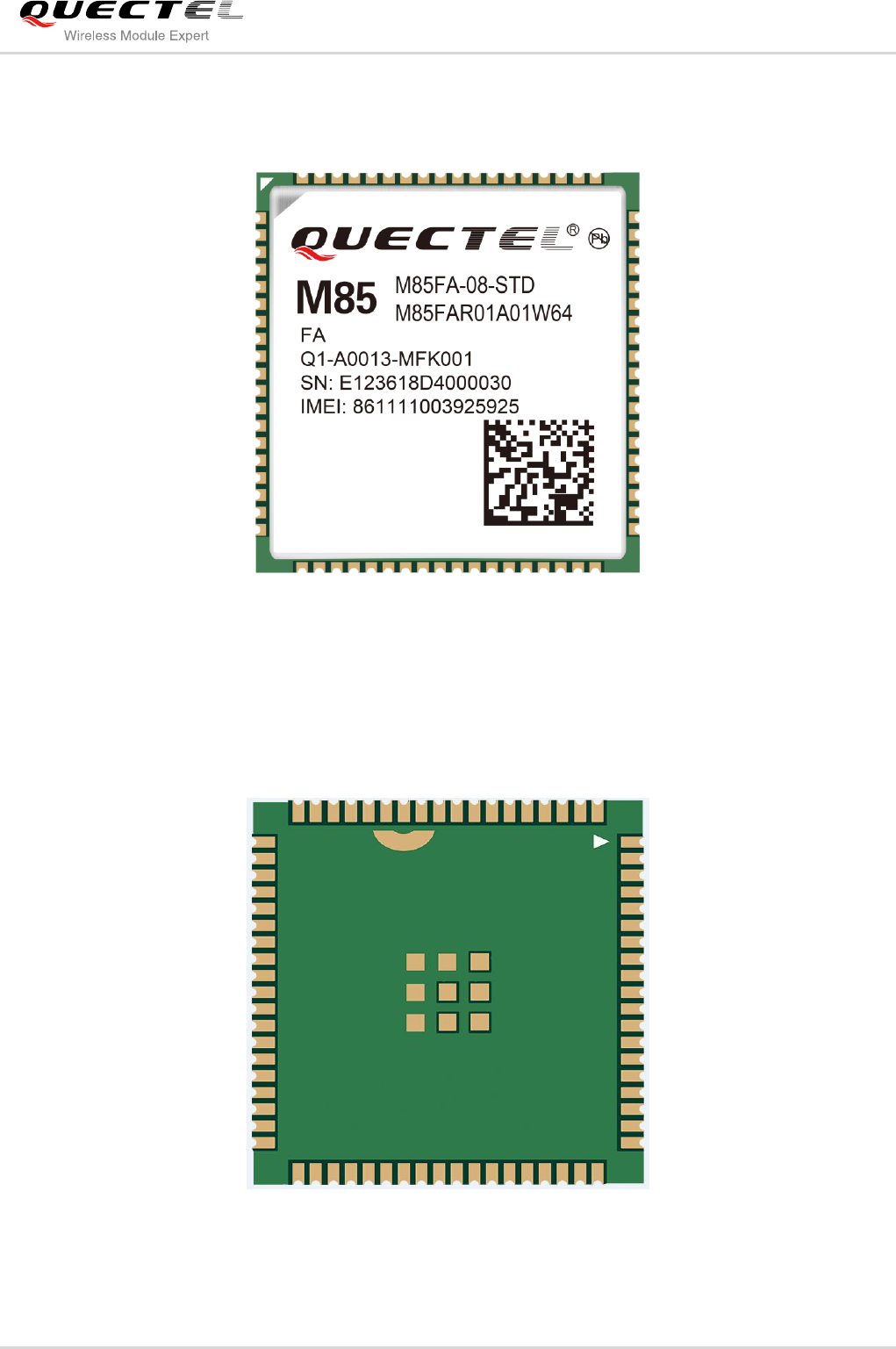
GSM/GPRS Module Series
M85 Hardware Design
M85_Hardware_Design Confidential / Released 77 / 88
6.3. Top View of the Module
Figure 52: Top View of the Module
6.4. Bottom View of the Module
Figure 53: Bottom View of the Module

GSM/GPRS Module Series
M85 Hardware Design
M85_Hardware_Design Confidential / Released 78 / 88
7 Storage and Manufacturing
7.1. Storage
M85 module is distributed in a vacuum-sealed bag. The restriction for storage is shown as below.
Shelf life in the vacuum-sealed bag: 12 months at environments of <40ºC temperature and < 90%RH.
After the vacuum-sealed bag is opened, devices that need to be mounted directly must be:
Mounted within 72 hours at the factory environment of ≤30ºC temperature and <60% RH.
Stored at <10% RH.
Devices require baking before mounting, if any circumstance below occurs.
When the ambient temperature is 23ºC ±5 ºC , humidity indication card shows the humidity is >10%
before opening the vacuum-sealed bag.
If ambient temperature is <30ºC and the humidity is <60%, the devices have not been mounted
during 72hours.
Stored at >10% RH.
If baking is required, devices should be baked for 48 hours at 125ºC ±5 ºC .
As plastic container cannot be subjected to high temperature, devices must be removed prior to high
temperature (125ºC ) bake. If shorter bake times are desired, refer to the IPC/JEDECJ-STD-033 for bake
procedure.
NOTE
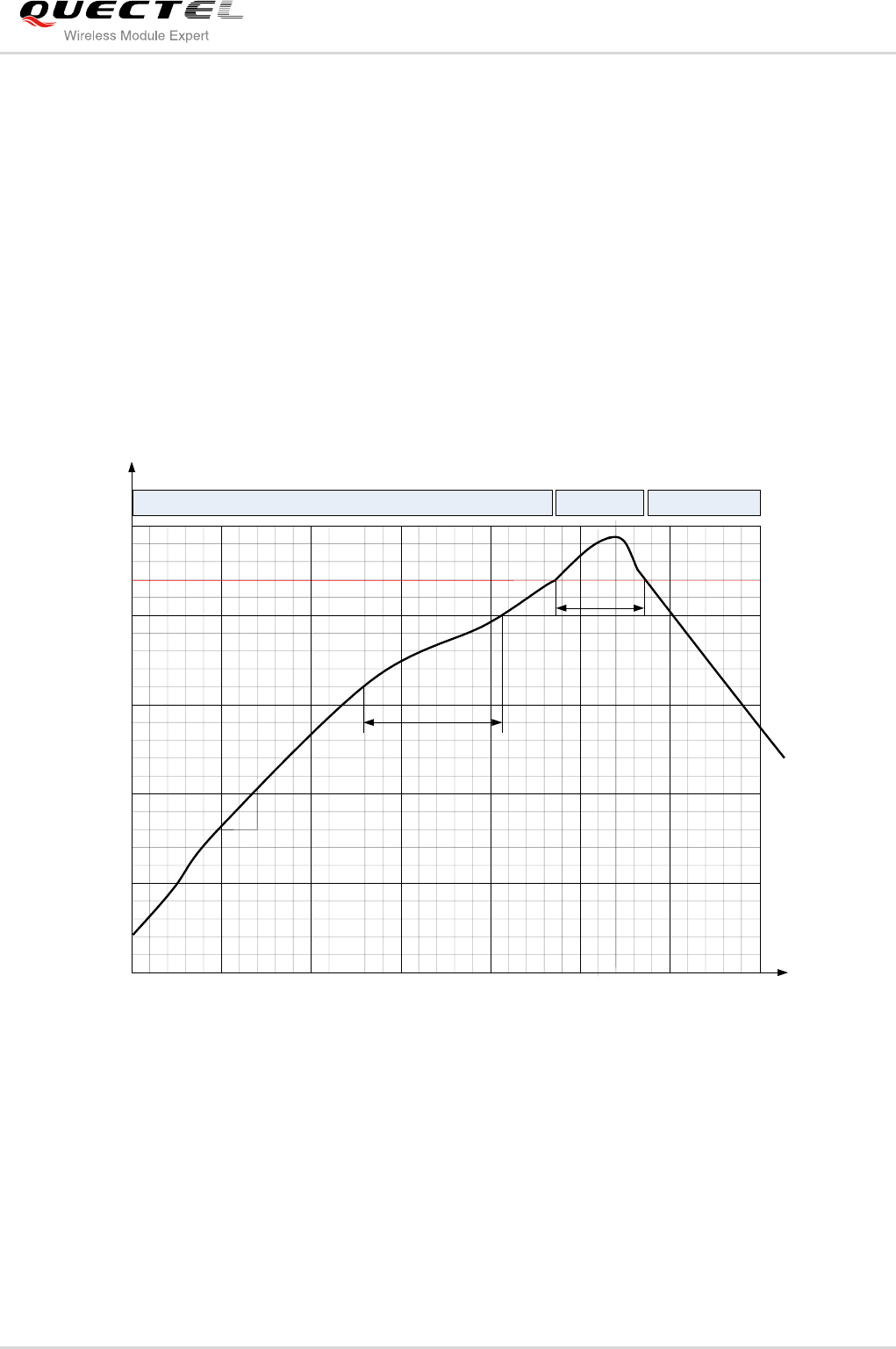
GSM/GPRS Module Series
M85 Hardware Design
M85_Hardware_Design Confidential / Released 79 / 88
7.2. Soldering
The squeegee should push the paste on the surface of the stencil that makes the paste fill the stencil
openings and penetrate to the PCB. The force on the squeegee should be adjusted so as to produce a
clean stencil surface on a single pass. To ensure the module soldering quality, the thickness of stencil at
the hole of the module pads should be 0.2 mm for M85. For more details, please refer to document [13].
It is suggested that peak reflow temperature is from 235ºC to 245ºC (for SnAg3.0Cu0.5 alloy). Absolute
max reflow temperature is 260ºC. To avoid damage to the module when it was repeatedly heated, it is
suggested that the module should be mounted after the first panel has been reflowed. The following
picture is the actual diagram which we have operated.
Time(s)
50 100 150 200 250 300
50
100
150
200
250
160℃
200℃
217
0
70s~120s
40s~60s
Between 1~3℃/S
Preheat Heating Cooling
℃
s
Liquids
Temperature
Figure 54: Ramp-Soak-Spike Reflow Profile
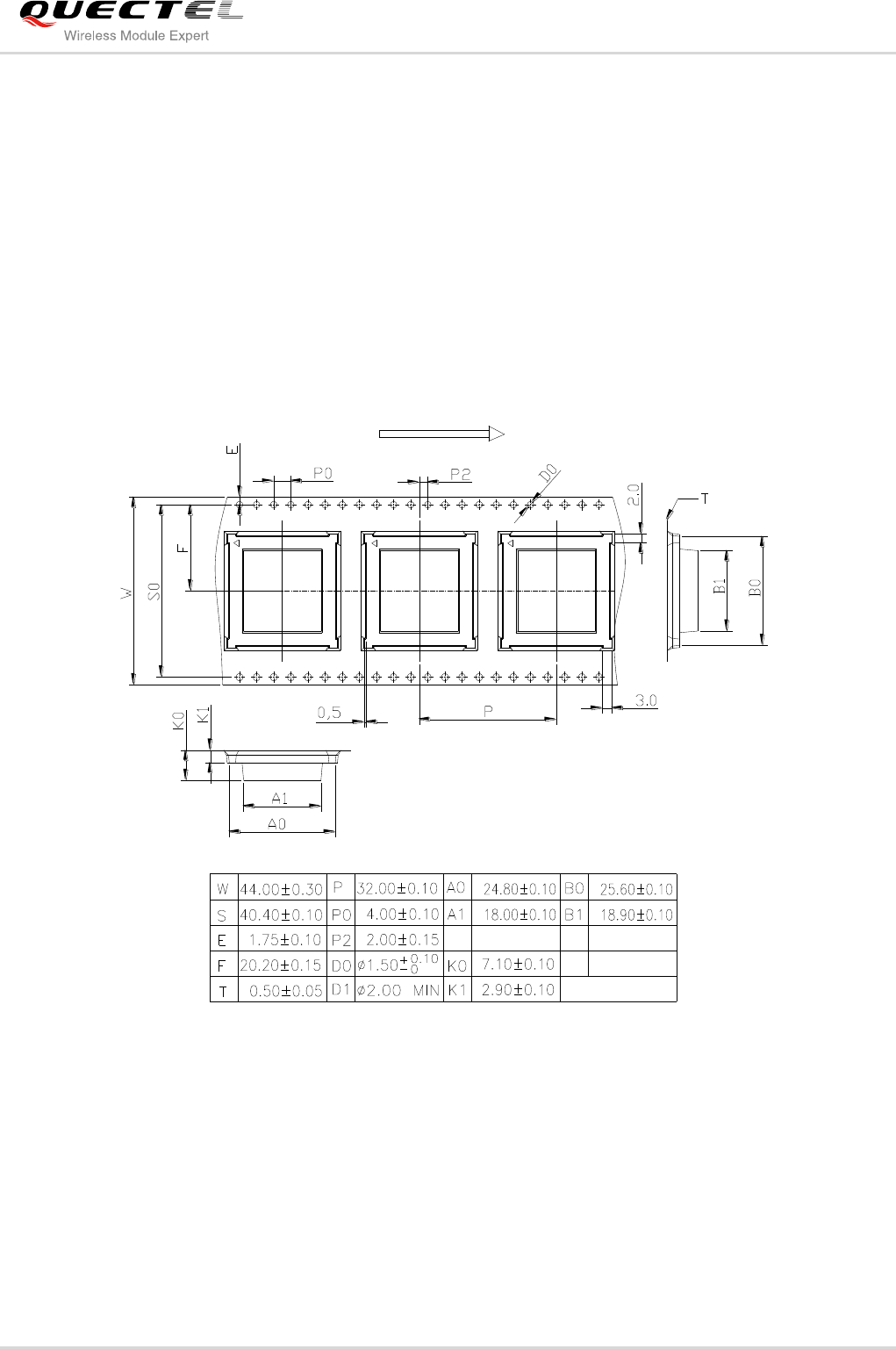
GSM/GPRS Module Series
M85 Hardware Design
M85_Hardware_Design Confidential / Released 80 / 88
7.3. Packaging
M85 modules are shipped in tape and reel form. The reel is 330mm in diameter and each reel contains
250pcs modules. This is especially suitable for the M85 according to SMT assembly processes
requirements.
The tape is packed in a vacuum-sealed bag which is ESD protected. Furthermore, it should not be
opened until the devices are ready to be soldered onto the application.
Direction of SMT

GSM/GPRS Module Series
M85 Hardware Design
M85_Hardware_Design Confidential / Released 81 / 88
DC圆盘44
PS
6
DETAIL:A
DETAIL:A
Figure 55: Tape and Reel Information
Table 35: Reel Packing
Model Name
MOQ for MP
Minimum Package: 250pcs
Minimum Package×4=1000pcs
M85
250pcs
Size: 370 × 350 × 56mm
N.W: 0.78kg
G.W: 1.54kg
Size: 380 × 250 × 365mm
N.W: 3.10kg
G.W: 6.80kg

GSM/GPRS Module Series
M85 Hardware Design
M85_Hardware_Design Confidential / Released 82 / 88
8 Appendix A Reference
Table 36: Related Documents
SN
Document Name
Remark
[1]
Quectel_M85_AT_Commands_Manual
AT commands manual
[2]
ITU-T Draft new recommendation V.25ter
Serial asynchronous automatic dialing and
control
[3]
GSM 07.07
Digital cellular telecommunications (Phase
2+); AT command set for GSM Mobile
Equipment (ME)
[4]
GSM 07.10
Support GSM 07.10 multiplexing protocol
[5]
GSM 07.05
Digital cellular telecommunications (Phase
2+); Use of Data Terminal Equipment – Data
Circuit terminating Equipment (DTE – DCE)
interface for Short Message Service (SMS)
and Cell Broadcast Service (CBS)
[6]
GSM 11.14
Digital cellular telecommunications (Phase
2+); Specification of the SIM Application
Toolkit for the Subscriber Identity module –
Mobile Equipment (SIM – ME) interface
[7]
GSM 11.11
Digital cellular telecommunications (Phase
2+); Specification of the Subscriber Identity
module – Mobile Equipment (SIM – ME)
interface
[8]
GSM 03.38
Digital cellular telecommunications (Phase
2+); Alphabets and language-specific
information
[9]
GSM 11.10
Digital cellular telecommunications (Phase
2); Mobile Station (MS) conformance
specification; Part 1: Conformance
specification
[10]
Quectel_GSM_UART_Application_Note
UART port application note
[11]
Quectel_GSM_Module_Digital_IO_Application_Note
GSM Module Digital IO Application Note

GSM/GPRS Module Series
M85 Hardware Design
M85_Hardware_Design Confidential / Released 83 / 88
Table 37: Terms and Abbreviations
[12]
Quectel_GSM_EVB_User_Guide
GSM EVB user guide
[13]
Quectel_Module_Secondary_SMT_User_Guide
Module secondary SMT user guide
Abbreviation
Description
ADC
Analog-to-Digital Converter
AMR
Adaptive Multi-Rate
ARP
Antenna Reference Point
ASIC
Application Specific Integrated Circuit
BER
Bit Error Rate
BOM
Bill Of Material
BTS
Base Transceiver Station
CHAP
Challenge Handshake Authentication Protocol
CS
Coding Scheme
CSD
Circuit Switched Data
CTS
Clear To Send
DAC
Digital-to-Analog Converter
DRX
Discontinuous Reception
DSP
Digital Signal Processor
DCE
Data Communications Equipment (typically module)
DTE
Data Terminal Equipment (typically computer, external controller)
DTR
Data Terminal Ready
DTX
Discontinuous Transmission
EFR
Enhanced Full Rate
EGSM
Enhanced GSM

GSM/GPRS Module Series
M85 Hardware Design
M85_Hardware_Design Confidential / Released 84 / 88
EMC
Electromagnetic Compatibility
ESD
Electrostatic Discharge
ETS
European Telecommunication Standard
FCC
Federal Communications Commission (U.S.)
FDMA
Frequency Division Multiple Access
FR
Full Rate
GMSK
Gaussian Minimum Shift Keying
GPRS
General Packet Radio Service
GSM
Global System for Mobile Communications
G.W
Gross Weight
HR
Half Rate
I/O
Input/Output
IC
Integrated Circuit
IMEI
International Mobile Equipment Identity
Imax
Maximum Load Current
Inorm
Normal Current
kbps
Kilo Bits Per Second
LED
Light Emitting Diode
Li-Ion
Lithium-Ion
MO
Mobile Originated
MOQ
Minimum Order Quantity
MP
Manufacture Product
MS
Mobile Station (GSM engine)
MT
Mobile Terminated
N.W
Net Weight

GSM/GPRS Module Series
M85 Hardware Design
M85_Hardware_Design Confidential / Released 85 / 88
PAP
Password Authentication Protocol
PBCCH
Packet Switched Broadcast Control Channel
PCB
Printed Circuit Board
PDU
Protocol Data Unit
PPP
Point-to-Point Protocol
RF
Radio Frequency
RMS
Root Mean Square (value)
RTC
Real Time Clock
RX
Receive Direction
SIM
Subscriber Identification Module
SMS
Short Message Service
TDMA
Time Division Multiple Access
TE
Terminal Equipment
TX
Transmitting Direction
UART
Universal Asynchronous Receiver & Transmitter
URC
Unsolicited Result Code
USSD
Unstructured Supplementary Service Data
VSWR
Voltage Standing Wave Ratio
Vmax
Maximum Voltage Value
Vnorm
Normal Voltage Value
Vmin
Minimum Voltage Value
VIHmax
Maximum Input High Level Voltage Value
VIHmin
Minimum Input High Level Voltage Value
VILmax
Maximum Input Low Level Voltage Value
VILmin
Minimum Input Low Level Voltage Value

GSM/GPRS Module Series
M85 Hardware Design
M85_Hardware_Design Confidential / Released 86 / 88
VImax
Absolute Maximum Input Voltage Value
VImin
Absolute Minimum Input Voltage Value
VOHmax
Maximum Output High Level Voltage Value
VOHmin
Minimum Output High Level Voltage Value
VOLmax
Maximum Output Low Level Voltage Value
VOLmin
Minimum Output Low Level Voltage Value
Phonebook Abbreviations
LD
SIM Last Dialing phonebook (list of numbers most recently dialed)
MC
Mobile Equipment list of unanswered MT Calls (missed calls)
ON
SIM (or ME) Own Numbers (MSISDNs) list
RC
Mobile Equipment list of Received Calls
SM
SIM phonebook

GSM/GPRS Module Series
M85 Hardware Design
M85_Hardware_Design Confidential / Released 87 / 88
9 Appendix B GPRS Coding Scheme
Four coding schemes are used in GPRS protocol. The differences between them are shown in the
following table.
Table 38: Description of Different Coding Schemes
Scheme
Code
Rate
USF
Pre-coded
USF
Radio
Block
excl.USF
and BCS
BCS
Tail
Coded
Bits
Punctured
Bits
Data
Rate
Kb/s
CS-1
1/2
3
3
181
40
4
456
0
9.05
CS-2
2/3
3
6
268
16
4
588
132
13.4
CS-3
3/4
3
6
312
16
4
676
220
15.6
CS-4
1
3
12
428
16
-
456
-
21.4
Radio block structure of CS-1, CS-2 and CS-3 is shown as the figure below.
Figure 56: Radio Block Structure of CS-1, CS-2 and CS-3
Rate 1/2 convolutional coding
Puncturing
456 bits
USF
BCS
Radio Block

GSM/GPRS Module Series
M85 Hardware Design
M85_Hardware_Design Confidential / Released 88 / 88
Radio block structure of CS-4 is shown as the following figure.
Figure 57: Radio Block Structure of CS-4
Block
Code
No coding
456 bits
USF
BCS
Radio Block

GSM/GPRS Module Series
M85 Hardware Design
M85_Hardware_Design Confidential / Released 89 / 88
10 Appendix C GPRS Multi-slot Class
Twenty-nine classes of GPRS multi-slot modes are defined for MS in GPRS specification. Multi-slot
classes are product dependant, and determine the maximum achievable data rates in both the uplink and
downlink directions. Written as 3+1 or 2+2, the first number indicates the amount of downlink timeslots,
while the second number indicates the amount of uplink timeslots. The active slots determine the total
number of slots the GPRS device can use simultaneously for both uplink and downlink communications.
The description of different multi-slot classes is shown in the following table.
Table 39: GPRS Multi-slot Classes
Multislot Class
Downlink Slots
Uplink Slots
Active Slots
1
1
1
2
2
2
1
3
3
2
2
3
4
3
1
4
5
2
2
4
6
3
2
4
7
3
3
4
8
4
1
5
9
3
2
5
10
4
2
5
11
4
3
5
12
4
4
5